A tradition continued
décembre 2025

The buffalo horn tobacco box has a long tradition. As early as the end of the seventeenth century, such boxes were made in England by pressing sheets of horn or whalebone into metal matrices. At that time, they were used to store pipe tobacco. The technique of pressing has remained alive since then and has returned regularly. It even spread to other countries such as the German states. The box depicted is a later example made in Portugal around 1820, now intended for snuff. As usual, the box has been left plain, the decoration concentrated on the lid. In the centre we see an altar with two burning hearts, flanked by two turtledoves. The inscription love till death do us part in the Portuguese language makes the snuff box a suitable wedding gift. The inscription on the edge reads two united hearts make one sorrow. Both horn and whalebone are strong materials and therefore suitable for years of use. However, the material wore out over time, and in other cases it warped, causing the boxes to start leaking. Despite this, such objects remained in use until they were superseded by artificial materials around 1850. Fortunately, our snuff box was preserved in very good condition.
Amsterdam Pipe Museum APM 30.489
PermalinkA beaten gold band
novembre 2025

The most successful products from established pipe factories are given extra cachet with a luxurious mounting. This is the case with this tobacco pipe made by Savinelli in Milan. With its wide bowl shape, round bottom and slightly curved stem with wide mouthpiece, it is a typical seventies design that fits seamlessly with the prevailing fashion of the time. The sandblasted finish with dark stained tint together with the black glossy stem, requires a clear caesura to accentuate the materials. This was found in a gold band that was very subtly provided with a fantasy wood grain relief. The gold brings contrast, and that is precisely what made the object chic. This exclusive pipe belonged to a dedicated Rotterdam smoker who did not shy away from purchasing quality at a correspondingly high price. In September 1980, almost 400 guilders were lovingly paid for this pipe, a considerable sum for that time. The consolation is that the gold did not need to be polished, unlike its brass counterparts under a hundred guilders. Above and beyond that, the briar used in this pipe was older and therefore more porous. This guaranteed the pipe a milder taste of the smoke, which was also what our motivated pipe smoker hoped for.
Amsterdam Pipe Museum APM 30.452
PermalinkStunning kakiemon style
octobre 2025

In the Japanese potteries in the Arita region, a decor was developed in the seventeenth century, characterized by delicate branches with sparse flowers in a unique asymmetrical style. This painting style is called kakiemon and because of the great transparency and unexpected flower branch pattern, this fashion quickly became popular worldwide. It will come as no surprise that this fame led to imitation. The porcelain pipe bowl depicted here shows this kakiemon style. However, it is a pipe made in the famous Königlichen Sächsischen Porzellan-Manufaktur in Meissen, dating from around the year 1730. Although the inspiration unmistakably lay in the decor of the East, we can clearly see European influences. Where the branches in the Japanese kakiemon are exceptionally transparent, partly leafless and with a whimsical design, the European version is more closely related to the colorful floral bouquets of other Meissen decors with more flower and leaf work. Furthermore, the use of bright colors suits the taste of the European market. These bright but unrealistic colours - note for example the leaves in a blue tint - betray Japanese inspiration, but in the execution we search in vain for the convincing Japanese identity. It remains a truly European object, but because of the wonderful mix, it is extremely rare in its kind.
Amsterdam Pipe Museum APM 30.432
PermalinkThe raven and the frog
septembre 2025
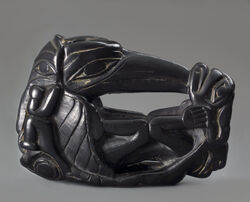
This title sounds like a fairy tale, perfectly matching the design of this pipe. It is carved from argillite, a coal-black stone related to slate, also referred to as claystone. The name is derived from the French word argil, which literally means clay. The pipe comes from the Haida, a people who live on Queen Charlotte's Island off the west coast of Canada in the Pacific Ocean. This amazing black stone is found there. Since the beginning of the nineteenth century, the Haida have been carving pipes with a very characteristic two-dimensionality. The two visible sides are dominated by fantastical, intertwined human and animal figures, depicted in a swirling representation in which the portrait heads look in all directions. Characteristic is the lack of naturalism, meaning that the proportions between the depicted figures can also be completely fantasy. In the pipe shown here, the raven is the main animal, a bird with high prestige in Haida culture. We also see a frog that is almost eaten and a human figure. It has not been handed down what exactly is meant by this figuration. Such imaginative works of art have been sold as souvenirs to travelers since about 1820. They are real collector's items, therefore, bought without the intention of being smoked. In any case, the art of the Haida is still loved and the panel pipes such as the one depicted here remain in demand worldwide.
Amsterdam Pipe Museum APM 30.426
PermalinkWell-made tinder box
août 2025

A typical Dutch item is the tinder box, used for centuries as a storage box for the material to make fire. In the tinder box you kept a piece of tinder fungus, together with a flint and a fire striker. If you needed fire, you brought the highly flammable tinder to smolder by striking a spark with iron on the stone. Then it was a piece of cake to transfer the fire to a chip of wood that can be used to light your pipe. Tinder boxes have been made since the seventeenth century, from simple to richly decorated. Characteristic of the nineteenth century is the cylindrical elongated box that fits comfortably in the hand. Such metal tinder boxes have a lid that closes over the box. The other side of the box shows a sliding bottom that clamps into the box. You can slide that bottom up to get the tinder fungus out of the narrow storage space more easily. As in most cases, a link chain connects the box and lid. All these features are clearly visible in this beautifully made tinderbox. Another nice aspect is that this luxurious version is made of silver; such tinderboxes are usually made of brass or copper. The bands with twisted rings provide strength and are a beautiful decorative element. Another attractive detail is the way in which the chain is made. This refined tinderbox was made in 1850 by Johannes van Kempen from Utrecht, not just any silversmith.
Amsterdam Pipe Museum APM 30.424
PermalinkGesteck of burlwood
juillet 2025

The adoration of natural phenomena prompted many nineteenth-century smokers to create a special object. This wooden tobacco pipe with a whimsical silhouette, which from a distance looks a lot like the German Gesteckpfeife with porcelain bowl, is a perfect example. The three main parts were selected for their bizarre, yet natural appearance. The wood used here has fallen prey to the growth of burlwood, which grows out of the tree trunk and can completely change or damage the shape of the tree or shrub. No pipe shows this effect, called Maserknol in German, better than the one illustrated here. Burlwood occurs in various trees, but especially in birch, oak or ash. The maker of this natural product has worked carefully. The pieces of wood show similar patterns, which means that they fit together well in terms of shape and appearance. Each piece is lightly polished to fit comfortably in the hand. To complete the object, a silver mounting in the form of a hinged lid has been added. This part is a standard item that was ordered from the lid maker. Furthermore, a subtle silver band reinforces the place where the bowl and stem are clamped. Purely for decoration, as a continuation of the irregular shapes of the whole object, the stem is extended with a piece of stag horn. This is just as idiosyncratic in design but spikier. A simple buffalo horn stem with a knob mouthpiece completes the pipe. Hasn't it become an odd curiosity?
Amsterdam Pipe Museum APM 30.406
PermalinkAristocratic corncob
juin 2025
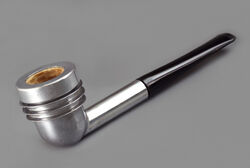
This chic pipe with streamlined appearance is known as the Aristocob. It is an industrial design with quite a history. Although you wouldn't say so, the core is a corncob pipe. The design is by Joseph Zarikta from Grand Haven in the American state of Michigan. He wanted to use the simple corncob to sweeten the taste of the smoke, but gave it a completely new twist. To give the object greater durability and a more chic appearance, he camouflaged the corncob with aluminum that was given cooling fins on the outside. The patent for his invention was issued in December 1966. The production of the metal was outsourced to the Al-Cob Corporation in Grand Haven, Michigan. The corncob inserts were supplied by the famous Missouri Meerschaum Company. The contemporary nature of this creation is also emphasized by the black nylon stem that offers space for a so-called Medico filter of rolled paper, produced by the same meerschaum company. The Aristocob was popular in those years in a plastic gift box, complete with two new corncob pipe bowls. After years, production was taken over by the aforementioned company from Missouri, which had been responsible for the insert bowls since the early years. The pipe remained in production until 1983. In the Netherlands, this pipe is truly a rarity.
Amsterdam Pipe Museum APM 30.381
PermalinkNot just a lower leg
mai 2025
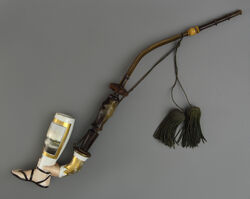
This porcelain tobacco pipe has a truly original design. In the bowl of the pipe we recognize the stummel shape, the oval pipe bowl that was so popular after 1800. However, the designer did not use a standard heel, but modeled the bowl base into a foot stuck in a classic thin-strapped sandal, so that the pipe bowl got the meaning of thigh. The stem attachment shows another joke, there we see a hand that holds the lower leg at the ankle, with a cuffed sleeve at the stem. These are original and beautifully modeled elements that provide a certain logical rhythm. As if that were not enough, the front of the bowl was painted as if it were a classic stummel: the cityscape of Mainz, unambiguously indicated with a text in beautiful handwriting, in a rectangle with a wide gold leaf frame. This makes this pipe also a souvenir for anyone who has visited Mainz. However, it is the authentic mounting that gives this pipe such a majestic but above all classic appearance. A heavier, horn-turned stem serves as a handle for the smoker; above that we see an elegant flattened stem with the so-called button mouthpiece after a baluster knot. A green cotton cord with two tassels holds the various parts together like a bail cord, as a lifesaver in case of accidental detachment. The date lies in the first quarter of the nineteenth century.
Amsterdam Pipe Museum APM 30.380
PermalinkSeated woman
avril 2025
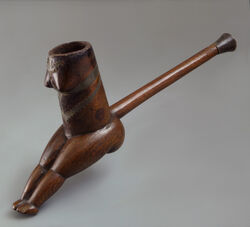
The pipes of the Xhosa in the eastern Cape in South Africa have a fixed design: a high, slightly oval bowl with a heel shape at the transition of the stem. The straight stem goes up at an angle of sixty to eighty degrees. This stem has a trumpet shape at the end into which the smoker inserts his or her own mouthpiece. That separate stem end is personal and almost sacred. Acacia wood is often used, whereby two pipes are always formed from one single piece of wood. Each pipe shows great craftsmanship, as is evident for example from the thin bowl wall. In this nineteenth century Xhosa pipe we still recognize the high bowl, but now as the basis for an exceptional design. The torso of a seated woman is carved from the wood block, who sticks both legs out at the bowl base. The beautiful styling is extremely subtle, simple and attractive. The protruding leg section also makes handling the pipe a pleasure. This Xhosa pipe is decorated with lead inlay, as is sometimes done. Three partly serrated bands around the neck, chest and belly give a decorative effect. The stem end is provided with a buffalo horn cuff, which makes the pipe extra strong when assembled. The pipe is more luxurious than usual, even in this respect.
Amsterdam Pipe Museum APM 30.057
PermalinkUnusual Pirkenhammer
mars 2025

A porcelain factory has been established in the Bohemian town of Pirkenhammer since 1803, which became of great importance for the development of the German porcelain pipe. The company reached its prosperity due to the partners Johann Martin Fischer and Christoph Reichenbach. Their pipes were sometimes provided with the impressed intaglio mark "F&R", but most objects left the factory unmarked. Famous are the Pirkenhammer pipe bowls with high church windows painted around the bowl, through which you can see the surroundings in miniature. The pipe depicted here is slightly hexagonally flattened and has a baluster shape at the base and a hinged lid as a cover. The hexagonal shape is copied from the church window pipes, but here a plain background was used, decorated with three raised medallions. Each of these was given a hand-painted decoration of a hunter flanked by a squirrel and a fox. Bright yellow, green and salmon are fashionable colours of the 1830s and shortly thereafter. Also note the marbled stem that suggests an alternative material. Fischer and Reichenbach reaped great success with their colourful pipes. This was partly due to the rich montages with buffalo horn, combined with ivory that emphasized the luxurious aspect. After 1860, however, consumer behaviour shifted from pipes to tableware and curiosities.
Amsterdam Pipe Museum APM 30.034
PermalinkA horn as a water reservoir
février 2025

The African continent has a great tradition in water pipes. This history begins with the dagga or dakka pipe from South Africa, named after the local word for hash, which was already smoked there around the year 1600. A piece of cow horn was used for the water reservoir of these pipes, serving to cool the smoke. In other regions, smokers chose more striking horns such as those of the antelope. The water pipe depicted is from the Ngombe people from the Equator Province of Congo-Kinshasa. The antelope horn is drilled open well before the end. Next, a baked clay pipe bowl is fitted into the hole using a ring-shaped stopper made of woven plant material. The potter took great care in decorating this pipe bowl. Rows of recessed triangles were applied as in notch carving. After baking, these were alternately accentuated with red and white dye to create a colorful smoking instrument. For use, the mouth was placed around the wide opening of the horn and in this way one could inhale the smoke cooled by the water. This ensures a deep inhalation of the smoke to give the desired kick. The saliva of the smoker caused the mouthpiece to be gnawed by insects later.
Amsterdam Pipe Museum APM 24.904
PermalinkBowl shape from Bukhara
janvier 2025

Almost in the middle of Central Asia we find the town Bukhara, one of the oldest cities in Uzbekistan. Situated on the Silk Road, this place was a lively trading city for centuries. In Bukhara there was a coming and going of traders who transported products from east to west but also from north to south. This tobacco pipe, turned from green steatite or soapstone is a characteristic trade item for this area. The relatively soft steatite can be worked well with a simple lathe. This technique has been known for centuries as a cottage industry. Pipes like these were usually made from different pieces of stone that were glued together using a tap. The turning was polished and then provided with fine turned rings, usually in pairs that form a beautiful contrast with the tap welds. Steatite can be found almost everywhere in the world. This pipe is likely made of stone from the Yarkand River basin that flows from Pakistan to Western China. If we look at the shape of the pipe, it corresponds to the hash pipe from India and Pakistan. The bowl-shaped head is particularly characteristic, as is the way in which the bowl tap falls into the stem. These pipes have been popular for smoking for a long time, certainly from well before 1850 up to the present day. The way they were made as well as the wear and tear through use reveal the dating. We can therefore recognize this pipe with a total length of twelve centimeters as an early twentieth-century product.
Amsterdam Pipe Museum APM 24.902
PermalinkJanus de la deuxième génération
décembre 2024

On sait que les fabricants de pipes de Gouda au dix-neuvième siècle ne comptaient pas parmi les meilleurs designers de pipes. Alors qu'à partir de 1820, les fabriques de pipes françaises produisaient des pipes à portrait magnifiques et réalistes, l'apparence de la pipe en terre de Gouda, qui était encore déterminée par la tradition et la simplicité, s'est estompée. Les fabricants de Gouda sont conscients de leurs lacunes et, bien qu'ils s'efforcent d'innover, ils n'ont pas le don de le faire. Cet amusant portrait d'un homme et d'une femme en figure de Janus prouve l'absence de conception de la part des Gouwenaars. Les visages n'ont aucun caractère, aucune trace de pommette ou d'orbite, il faut également noter la conception mécanique de la coiffure. En outre, même le concept n'est pas innovant. Il ne s'agit en aucun cas d'une invention du XIXe siècle, mais d'une copie pure et simple d'une pipe datant d'environ 1700, qui était vraiment progressiste à l'époque. Seule la taille du fourneau a été adaptée aux exigences de l'époque moderne ; il est devenu un peu plus haut pour pouvoir contenir plus de tabac, sinon le design est inchangé. Ce fourneau prouve les capacités limitées des fabricants de pipes de Gouda, qui ont eu à souffrir que leur industrie soit progressivement dépassée par les nouveautés étrangères.
Amsterdam Pipe Museum APM 24.860
PermalinkFourneau de pipe en céramique
novembre 2024

À côté de toutes ces pipes fantaisistes faites pour impressionner, il y a beaucoup d'autres pipes simples qui ne sont pas si spéciales, mais qui ont été extrêmement populaires. Cela vaut pour les pipes de notre monde moderne, mais aussi pour les pièces ethnographiques. Ce fourneau d'une simple pipe utilitaire est représentatif de ce type de pipe. Il provient du Ghana et a été utilisé par la tribu Lobi. Façonnée dans de l'argile rouge, cette pipe simple et fonctionnelle jouit d'une grande popularité depuis des générations. Avec son fourneau étroit et son fond plat, c'est un objet pratique. Ces pipes sont fumées sur un tuyau solide d'un demi-mètre, voire plus. Pendant que l'on fume, la pipe assez lourde repose sur le sol et le fumeur la tire vers lui lorsqu'il veut bourer la pipe ou rallumer le tabac. Comme le fond de la pipe glisse sur le sol de la hutte, le fond du fourneau s'use peu à peu. C'est justement ce qui s'est passé ici. Enfin, un détail important concernant la conception de la manchette, l'extrémité de la tige de la pipe. Avec sa forme aplatie et le triangle découpé dans le coin du tuyau, il symbolise un phallus considéré comme un symbole de fertilité. Ce motif est présent sur les têtes de pipes depuis des générations, peut-être depuis si longtemps que les fabricants et les utilisateurs en ont oublié la signification originelle.
Amsterdam Pipe Museum APM 24.774
PermalinkExtincteur à cigarette avec oiseau stylisé
octobre 2024

Cette fois, il s'agit d'un objet presque oublié : l'extincteur de cigarettes. Au vingtième siècle, ce petit instrument discret était couramment utilisé pour repousser les mégots fumants dans le cendrier sans se tacher les doigts. Cette coutume est tombée en désuétude lorsque les fabricants de cigarettes ont commencé à introduire le filtre et, un peu plus tard, à ajouter des produits chimiques pour empêcher la cigarette de se consumer. À l'époque actuelle, où les mégots fumants ne sont envisageables que dans le domaine des fumeurs dépendants, cet objet a complètement disparu. Cet oiseau des années 1930, dans lequel on peut voir un pélican avec un peu d'imagination, est l'un des derniers extincteurs de l'environnement bourgeois. Il est bon de savoir que cet oiseau a passé sa vie active dans le cendrier de l'ancien directeur de notre Rijksmuseum, Arthur van Schendel. Son père, le célèbre écrivain du même nom, était, contrairement à son fils, un fumeur de pipe invétéré.
Amsterdam Pipe Museum APM 24.768
PermalinkPortrait de hussard au casque en laiton
septembre 2024

Les premières pipes en bois d'Ulm sont rares. Le dix-huitième siècle est loin derrière nous, de nombreuses pipes bien-aimées ont été fumées pendant des années, mais inévitablement le moment de la mise au rebut est venu parce que des défauts se sont manifestés. Cette pipe est un bel exemple d'une première Ulm avec une forme rare de figuration qui a été conservée en bon état. Elle représente la tête d'un hussard à l'allure dure, soulignée par sa grande moustache. Caractéristique de l'époque, le bois est décoré de perles blanches qui donnent ici et là un accent subtil mais attrayant. La façon dont le tuyau est protégé contre l'usure lors de la pose de l'instrument est tout à fait unique. Le clou en laiton dans le lobe de l'oreille du soldat se trouve exactement au niveau de la partie la plus épaisse du fourneau de la pipe. Si vous n'avez pas fumé pendant un certain temps et que la pipe est posée sur le côté, l'objet repose sur ce clou, sur le bord du couvercle et sur la manchette, ce qui évite les rayures sur le bois. Le fabricant y a manifestement pensé. Un autre élément du XVIIIe siècle est le couvercle à charnière en forme de véritable casque militaire, fabriqué en laiton lourd. Les premiers accessoires de pipes d'Ulm sont toujours en laiton, l'argent devenant plus populaire un peu plus tard, lorsque la pipe est devenue un objet de prestige respecté au début du XIXe siècle. Le casque n'est pas seulement une couronne appropriée sur la tête de ce soldat, il est aussi devenu un moyen favori de couvrir le fourneau de la pipe contre les étincelles qui s'en échappent.
Amsterdam Pipe Museum APM 24.766
PermalinkPipe à tabac au tuyau flexible
août 2024

Au début du XIXe siècle, alors qu'il était encore courant de fumer dans des pipes à long tuyau, des pipes à tuyau flexible ont été créées. Elles n'étaient pas vraiment pratiques. Un tuyau fixe offre un support qui permet de tenir l'embout entre les dents, tout en soutenant le fourneau d'une main. Un tuyau flexible semble être le summum du confort, mais il n'offre aucun support entre l'embout et la pipe. En fait, vous ne pouvez pas retirer l'embout de votre bouche pendant un certain temps sans qu'il ne tombe un peu. Il est intéressant de savoir qu'un tuyau aussi souple était fabriqué à partir d'un ressort en fer, recouvert à l'extérieur d'une peau de chamois, puis tressé avec du crin de cheval, parfois aussi avec du fil de soie brillant. Cet exemple est un peu plus luxueux, car ici le revêtement extérieur de la tige est fait d'anneaux de corne de buffle tournés qui garantissent à la fois la mobilité et la durabilité. Malheureusement, l'humidité de la fumée avait souvent un effet destructeur sur le noyau de fer, qui rouillait progressivement et rendait la tige rigide, jusqu'à ce qu'elle se brise en un endroit et que le plaisir soit terminé. Il n'est donc pas surprenant que peu de ces tuyaux flexibles aient été conservés en bon état. Cette pipe possède un fourneau de forme dite hongroise, haut et cylindrique, en écume de mer. L'élégance de cette pipe à fumer est soulignée par un couvercle à charnière en argent et une monture de manchette également en argent. De telles pipes étaient fumées dans les cercles bourgeois vers les années 1830.
Amsterdam Pipe Museum APM 24.764
PermalinkTrophée pour le gagnant
juillet 2024

Les concours de fumage de pipe peuvent sembler bizarres pour certains fumeurs de pipe, mais c'est une tradition qui captive encore aujourd'hui d'innombrables Nicotiniens. Ce trophée remporté lors du championnat de fumage de pipe à Sneek en 2012 en témoigne. Si le trophée en forme de coupe a fait place à une approche moderne, presque sculpturale, l'objectif des participants n'a pas changé. Ils se disputent le titre honorifique de champion langzeitrauchen, comme le dit si bien l'allemand. Une fois la pipe de compétition - égale pour tous - remplie de trois grammes de tabac, le signal de départ est donné. Chaque participant dispose d'une minute pour allumer sa pipe, pour laquelle deux allumettes sont fournies. Ensuite, il s'agit de fumer avec le moins de feu possible pour remporter le titre. Le vainqueur de l'époque s'est vu remettre cet objet après 2 heures et 36 minutes passées à fumer dans la même pipe, avec tous les éloges et un magnifique certificat. Il est étonnant qu'après dix ans d'exposition dans l'armoire du lauréat, cette récompense ait maintenant atteint le statut de musée, avec le diplôme.
Amsterdam Pipe Museum APM 24.756c
PermalinkAcier à feu avec boucles
juin 2024

Faire du feu est inextricablement lié au fait de fumer. Pas de fumée sans feu ! Autrefois, avoir du feu était un point d'attention. Le plus simple était d'aller chercher des braises sur le poêle de la cuisine. Si ce n'était pas possible, il fallait s'y mettre soi-même. Faire du feu était un véritable enjeu : créer une étincelle à l'aide d'un silex et d'une pierre à feu qui pouvait enflammer un morceau d'amadou. Ensuite, une mèche ou un copeau de bois permettait d'amener le feu dans la pipe. Il existe de nombreux types d'aciers à feu, dont celui-ci a la forme la plus caractéristique. La section de frappe est la plus épaisse, avec un côté droit pour frapper le silex. La partie qui sert de poignée a besoin d'une bonne prise pour pouvoir frapper avec puissance. La poignée de notre exemple est gracieusement courbée et torsadée en deux boucles. Cela lui donne la forme de l'acier à feu traditionnel qui a été utilisé pendant des siècles avec cet aspect et qui a également été souvent représenté comme un symbole. Cet acier à feu est par exemple l'emblème des ducs de Bourgogne. Après avoir été forgé, l'acier à feu était trempé pour être durable et offrir des années de service. Les manipulations fréquentes ont donné au fer forgé une belle patine et l'ont empêché de rouiller. Cet objet ancien a été conservé dans cet état impressionnant.
Amsterdam Pipe Museum APM 24.734
PermalinkBoîte à tabac de première génération
mai 2024
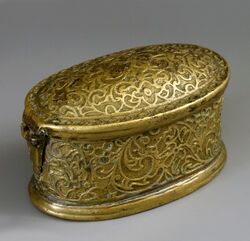
Au début, le tabac était très cher en raison du transport depuis la Virginie. Cette herbe précieuse méritait d'être conservée en toute sécurité. Il n'est donc pas surprenant que les premiers fumeurs aient été favorables à un emballage approprié. Voici une de ces premières boîtes à tabac. Il s'agit d'une boîte en laiton de 6 centimètres de long, destinée à la première génération de fumeurs. Les exigences du fumeur étaient une taille pas trop grande, la solidité, un couvercle qui se ferme bien et quelque chose en plus. À l'époque, les pipes à tabac étaient si petites qu'elles ne pouvaient pas être remplies avec le doigt. Il était donc pratique d'avoir un bourre pipe et le fabricant de boîtes a appliqué cet instrument à la charnière à l'intérieur de la boîte. Cette boîte est moulée et a un poids considérable. L'usure ne détruirait pas rapidement une boîte aussi robuste. En outre, sa forme est pratique. Grâce à son fond plat, l'objet peut se tenir debout sur la table, mais c'est aussi un bijou. L'extérieur est décoré d'un motif en relief de vignes à feuilles frisées qui, au deuxième coup d'œil, sont disposées de manière géométrique. Le fond de ces champs est approfondi et légèrement rugueux. Ils suggèrent qu'ils pourraient être remplis d'émail multicolore. Cependant, cela n'est pas nécessaire et ne semble pas avoir été le cas pour cette boîte. Même dans cette version moins tape-à-l'œil, elle reste un objet destiné à un fumeur chic et plus fortuné.
Amsterdam Pipe Museum APM 24.731
PermalinkSouches d’arbres dans une pipe à tabac
avril 2024
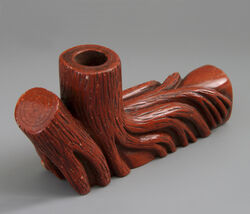
Les têtes de pipes des Sioux américains sont fabriquées en catlinite, une pierre d'un rouge saisissant, avec une certaine stratification. En général, on recherche un morceau de pierre aussi rouge que possible, mais il arrive que ce soit différent. Dans le cas présent, le pipier a exploité les surprises de la nature en utilisant une pierre vibrante avec de légers points le long du bord inférieur, qui présente une décoloration semblable à celle du quartz. Le pipier a utilisé cette variété de couleur pour créer un accent supplémentaire sur le dessous de la pipe. Cette pipe se distingue également par son design. Contrairement à l'habitude, cette pipe n'a pas de tuyau droit qui se poursuit derrière le fourneau, mais la sortie est inclinée vers le haut. La souche ascendante et le fourneau de la pipe sont tous deux constitués de troncs d'arbres à la base, qui se transforment en un relief évoquant des racines. L'écorce correspond à celle de l'arbre, tandis que le sommet de la souche présente des anneaux de croissance. Pour compléter le tout, un anneau de croissance a également été placé autour de l'ouverture de la pipe. Dans l'ensemble, une conception originale a été réalisée dans la tradition de la tribu, mais avec une grande liberté. Compte tenu des traces de fumée, la pipe a été fumée par d'autres membres de la tribu avant d'entrer dans une collection privée et d'aboutir dans notre musée.
Amsterdam Pipe Museum APM 24.710
PermalinkPipe Téké à deux figures
mars 2024
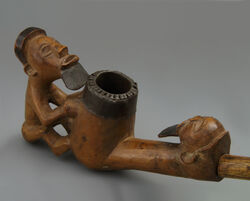
Dans cette pipe à tabac, la forme de base de la bruyère européenne est visible, bien que l'interprétation soit complètement africaine. Nous voyons un fourneau cylindrique auquel est attaché un tuyau ascendant. En raison du bois tendre dans lequel la pipe est taillée, le fabricant a doublé l'intérieur du fourneau d'une feuille de métal pour éviter les brûlures. Cette opération a été minutieusement réalisée, avec d'abord une bande autour de la partie supérieure du fourneau, puis l'intérieur, dont le métal a été découpé sur le bord et replié. L'objet est décoré de deux sculptures. La plus dominante est une figure qui colle à l'avant du fourneau et qui montre clairement des traits cubiques. On remarque les mains et les pieds, mais aussi la barbichette carrée. La seconde figure présente le même caractère mais consiste en un simple masque qui marque l'extrémité de la tige. Dans les deux cas, certaines parties ont été colorées avec de la teinture noire, comme les cheveux sur la tête et la barbiche. Un tuyau en bois vaguement taillé permet de fumer la pipe. Cette partie aurait été fabriquée en caoutchouc vulcanisé dans une pipe européenne, alors qu'ici, un bois local a été utilisé dans une courbe inhabituelle pour nous. Plus tard, la tribu utilise souvent du métal pour le tuyau de la pipe. L'aspect cubique des figures et les traits stylistiques du visage indiquent une production par les Tékés, un peuple vivant le long des rives du fleuve Congo. Cette pipe est datée de la première moitié du XXe siècle. La représentation du personnage à l'avant de la pipe est devenue si populaire qu'elle a été régulièrement retaillée jusqu'à la fin du XXe siècle.
Amsterdam Pipe Museum APM 24.709
PermalinkPrototype de pipe Porsche
février 2024
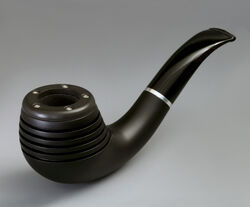
Les objets de design ne sont pas faciles à construire. Le designer aspire à la nouveauté, à la qualité et à l'unicité. Il n'est donc pas surprenant qu'il s'aventure parfois dans une nouvelle conception un nombre incalculable de fois avant d'obtenir le résultat final idéal. C'est ce qui s'est passé avec le désormais célèbre pipe de Porsche. Inspiré par le design de Ferdinand Alexander Porsche, Heinrich Oldenkott de Rees (Allemagne) a créé en 1988 un modèle unique avec les emblématiques ailettes de refroidissement. Mais l'histoire ne s'est pas arrêtée là. Plus de dix ans plus tard, en 1999, l'entreprise néerlandaise Gubbels a poursuivi la production du tuyau Porsche à sa guise. C'est à cette époque qu'est apparue la fameuse tête métallique avec les vis caractéristiques. Ensuite, une nouvelle forme entièrement incurvée a été conçue, mais cela n'a pas été sans heurts. Lors du fraisage des anneaux de refroidissement autour du fourneau de la pipe, il s'est avéré que la fraise a heurté la tige et l'a endommagée. Il a fallu trouver une solution, ce qui n'a été possible qu'en construisant le tuyau en deux parties. La cuvette avec les étranglements a été fabriquée séparément, puis collée sur la base. La première pipe qui y est parvenu est l'exemple présenté ici. Cependant, la méthode étant trop lourde, ce modèle n'a jamais été produit. A la même époque, plusieurs pipes Porsche ont été conçues, mais n'ont finalement pas été produites. Heureusement, ils se sont retrouvés dans la collection du musée de la pipe d'Amsterdam, où ils illustrent les essais et les erreurs. Ces prototypes donnent un aperçu intéressant du processus de création d'objets de design, ce qui est tout à fait digne d'une collection de musée.
Amsterdam Pipe Museum APM 24.703
PermalinkPot à tabac dans un style historisant
janvier 2024
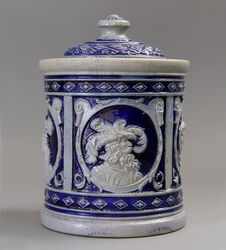
À la fin du XIXe siècle, on assiste à un grand renouveau de la production de grès dans le style historicisant à Westerwald, en Allemagne. Nous sommes ravis de cette tabatière, qui est un exemple représentatif de cette mode. Il s'agit d'un pot cylindrique avec un couvercle plat qui tombe dans un bord de couvercle lesté. Tout autour, entre des bandes avec des têtes de clous, on voit quatre grands médaillons avec des volutes dans les coins. Au centre, quatre portraits d'un homme et d'une femme, alternativement, dans des vêtements du XVIe siècle. Ils pourraient sortir tout droit d'une estampe de Dürer. Les plumes exubérantes des chapeaux des deux dames sont particulièrement frappantes. Ce sont de riches portraits, mais la stylisation dans laquelle ils sont exécutés les fait passer de l'historique à l'Art nouveau. Le grès de Westerwald se caractérise depuis le XVIe siècle par un tesson gris recouvert d'une glaçure saline brillante. De nombreuses pièces sont décorées au cobalt, ce qui donne des accents bleus joyeux. Le fabricant a apposé sa marque sur le fond, ce qui nous permet de savoir que cet objet a été fabriqué par Eckhardt & Engler. Cette marque est souvent apposée en creux avec le numéro de forme de l'objet, comme c'est le cas ici. De cette manière, le client pouvait facilement commander à nouveau un article sans avoir à discuter de la mise en œuvre. Malgré l'historicisme, une adaptation est indéniablement ancrée dans la modernité. Il s'agit de la possibilité de placer une éponge dans le couvercle afin de maintenir le contenu suffisamment humide. Il s'agit d'un ajout important pour un pot à tabac, en particulier lorsque, après 1900, le tabac devient plus aromatique et doit être plus humide pendant le fumage. La grande taille du pot à tabac en dit long sur la consommation de tabac à l'époque. De nos jours, un pot à tabac peut facilement faire moins de la moitié de cette taille.
Amsterdam Pipe Museum APM 24.701
PermalinkUn bougeoir en guise de pipe à tabac
décembre 2023
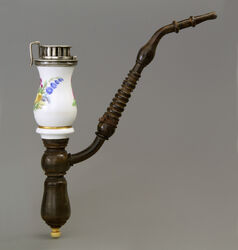
La pipe en porcelaine ancienne présentée ici provient de la Manufacture royale de porcelaine de Meissen. La pipe est connue sous le merveilleux nom de Leuchtertulle, qui fait référence à un chandelier en forme de balustre qui couronne chaque chandelier pour y placer la bougie. La même forme a été transformée ici en un fourneau de pipe. Sur le devant, le fourneau présente un bouquet de quatre fleurs peintes à la main, chacune avec sa propre couleur, tandis qu'à l'arrière, on voit une simple brindille. À la base, ce fourneau est monté sur un support en corne de buffle tournée dans lequel la partie en porcelaine est fixée à l'aide d'une vis. Ce support fait office d'anti-humidité, une solution très pratique puisqu'il s'agit également de la partie destinée à tenir la pipe sans se brûler. Un court tuyau ascendant avec une torsion dans la partie oblique transforme la forme du chandelier en une véritable pipe à tabac. La conception de cette pipe remonte aux années 1780 et la production se poursuit jusque dans les années 1795. Après 1800, cette invention a été complètement supplantée par l'apparition du haut fourneau ovale appelé stummel. Le fourneau de la pipe a conservé son couvercle d'origine en forme de tambour en argent avec un long ressort de serrage. Le dessus du couvercle est gravé du nom et des initiales de l'ancien propriétaire ou peut-être du donateur. Nous lisons le nom « SICKER » sur un ruban, avec un cœur en dessous et un beau monogramme des lettres « SJCD ». Ces inscriptions personnalisent la pipe, bien qu'il soit aujourd'hui impossible de savoir à quel point cette inscription était précieuse à l'époque.
Amsterdam Pipe Museum APM 24.693
PermalinkPipe à portrait en ivoire
novembre 2023
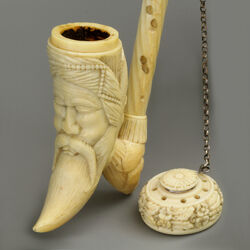
Cette pipe en ivoire maritime ou en dent de cachalot est un objet impressionnant avec ses 65 centimètres de long. La pipe à tabac est composée de segments de dents, chacun d'entre eux ayant été soigneusement tourné. Les cinq morceaux du tuyau sont habilement tordus et enfilés dans des nœuds ovales avec la même torsion. De cette manière, un long tuyau est construit avec un morceau flexible de fil métallique tressé au sommet, qui se termine par un embout en forme de bouton. Bien entendu, l'attention se porte surtout sur le fourneau, dont la forme pointue à la base est immédiatement reconnaissable comme la dent d'un cachalot. Ce fourneau représente le portrait fantaisiste d'un homme oriental avec une moustache et une longue barbe pointue, avec un visage similaire à l'arrière. Il porte sur la tête un turban orné de quelques rangs de perles, le revers montrant un couvre-chef plus serré. Ce qui frappe dans cette pipe, c'est qu'il n'y a pas de fourneau intérieur séparé, comme c'est généralement le cas. Le tabac fumant brûlait directement contre la dent, ce qui dégageait une odeur désagréable. Malgré cela, l'intérieur du fourneau de la pipe a été recouvert d'une belle couche uniforme de charbon en fumant. Heureusement, le fourneau ne s'est pas fissuré, comme beaucoup le craignent. La tête de la pipe est recouvert d'un couvercle de serrage abondamment sculpté. Dans la pièce de jonction entre le bol et la tige se trouve un troisième portrait, également celui d'un homme moustachu et barbu, portant une sorte de turban, mais beaucoup plus petit. Ce visage regarde de l'autre côté. De telles pipes, curieuses et surtout peu confortables, ont été fabriquées occasionnellement au XIXe siècle, mais le nombre de celles qui nous sont parvenues est extrêmement réduit. En raison du matériau utilisé, de sa longueur et de la décoration sculptée, il s'agit d'une pièce spéciale qui a sa place dans une vitrine plutôt qu'entre les lèvres d'un fumeur.
Amsterdam Pipe Museum APM 24.691
PermalinkTabatière à fermeture secrète
octobre 2023
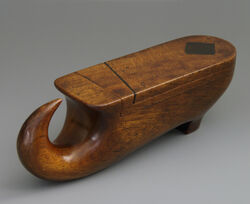
Au dix-neuvième siècle, il était plus courant de placer une serrure sur une tabatière. Si vous étiez négligent et laissiez la tabatière sans surveillance, l'illusion demeurait que personne ne savait comment l'ouvrir. Mais cette tabatière n'est pas aussi bien sécurisée qu'elle en a l'air, la serrure secrète étant plus une curiosité qu'une réelle efficacité. Une fois le système connu, l'ouverture de la boîte n'est plus un secret. Il ne faut pas tirer sur le couvercle, mais le tourner légèrement sur le côté pour pouvoir repousser le second et véritable couvercle et accéder au précieux contenu. La chaussure comme tabatière était un thème populaire au XIXe siècle. D'innombrables formes de chaussures et de sabots en bois, comme ici, ont été utilisées comme tabatières. Nous ne savons pas s'il y a une signification plus profonde à cela. Deux choses ressortent de cette tabatière. La première est sa forme particulière : le sabot a été stylisé à l'extrême et a donc acquis une apparence très solide et cubique avec sa grande boucle à l'avant. En outre, nous voyons un bel acajou qui a été poli si parfaitement qu'il conserve son éclat après un siècle et demi. Un élément particulier de cette boîte est la façon dont le pivot, qui permet aux deux couvercles de bouger librement, est camouflé par un insert carré en bois foncé contrasté. Il s'agit apparemment d'un ajout personnel du fabricant de cette tabatière.
Amsterdam Pipe Museum APM 24.685
PermalinkSoirée dansante exubérante
septembre 2023
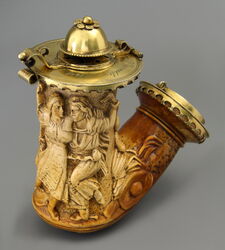
D'après la gravure sur l'anneau du couvercle, ce fourneau est entré en possession de Pertichevich Horvath en juin 1831. Son nom, qui ne signifie plus rien pour nous mais qui est encore un nom de famille courant en Hongrie, est gravé en lettres gracieuses sur le bord du couvercle. Dans un film enregistré près d'un siècle et demi plus tard, l'ancien propriétaire, le collectionneur suisse Jacques Schmied, a fait l'éloge de cette pipe comme étant la seule pipe en écume de mer avec un couvercle en or. Malheureusement, cela n'est pas vrai pour deux raisons. D'une part, le couvercle n'est pas en or massif mais en argent doré. D'autre part, l'écume était souvent considérée comme chère et était parfois dotée d'un couvercle ou d'une monture en or. Il n'en reste pas moins que le couvercle est un élément important de la pipe. Pour d'autres, en revanche, c'est la représentation sculptée qui prime. À l'avant du fourneau cylindrique, un homme et une femme dansent passionnément. L'homme, avec ses bottes à éperons et son chemisier ouvert, a l'air d'un Don Juan endurci. La musique de la danse est assurée par un orchestre de trois musiciens que l'on aperçoit sur le côté. Outre un violoniste et un violoncelliste, un troisième homme joue de la cornemuse. Grâce aux mouvements de balancier du couple de danseurs, la musique semble presque s'élever au-dessus de la cornemuse. Malgré la vivacité des figures et la douceur de la représentation, la sculpture ne fait pas preuve d'une grande délicatesse. C'est assez brouillon, habilement exécuté mais peu artistique. La finition de la scène, dans laquelle l'arrière-plan derrière les personnages est souvent orné de points, est ici aussi quelque peu hâtive et minimale. Un détail intéressant de cette pipe est que le dessous de la tige et le fond du fourneau présentent une belle décoration néo-gothique composée de quadrilobes. Cette décoration correspond à la date des années trente du dix-neuvième siècle, lors de l'éphémère renaissance du style gothique.
Amsterdam Pipe Museum APM 24.680
PermalinkTête caricaturée avec nez de cheval
août 2023
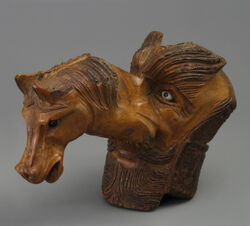
Certains morceaux de bois rustiques inspirent aux sculpteurs artistiques les inventions les plus étranges. Même le matériel de fumage n'est pas dépourvu de cet esprit artistique, comme le montre cet étonnant exemple. Un morceau de cerisier fantaisiste, scié à l'endroit où deux branches divergent, a servi de point de départ à cet artisan talentueux pour concevoir une pipe. Il a créé un portrait d'homme avec une moustache, une barbe et deux sourcils broussailleux, le tout culminant dans un grand nez qui se termine par une tête de cheval. Pour donner de l'éclat à la représentation, des yeux en pâte de verre ont été utilisés en blanc avec des pupilles bleu-noir pour l'homme et en rouge foncé pour le cheval. Ces yeux brillants donnent vie aux deux personnages. Le montage d'un tuyau droit ascendant, démontable en trois parties, complète la pipe. Des morceaux d'écorce de cerisier donnent des accents sombres au tuyau, tandis que le bois pelé s'harmonise avec la couleur vive du fourneau. La longueur du tuyau est de près d'un demi-mètre, ce qui garantit une fumée fraîche et sèche. Cette pipe grotesque date de la fin du XIXe siècle. À cette époque, d'autres pipes de ce type ont été fabriquées, toujours dans des modèles différents. Cet exemple est l'un des plus beaux. Il est possible que l'Alsace ait été le lieu de fabrication.
Amsterdam Pipe Museum APM 24.673
PermalinkBoîte de présentation pour cigarettes royales
juillet 2023
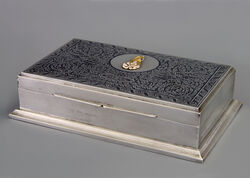
Cette magnifique boîte en argent est la dernière du genre à présenter les cigarettes avec élégance. Elle a été offerte par le roi thaïlandais Bhumibol, connu sous le nom de Rama IX, à l'une de ses relations suisses. Il s'agit d'une boîte solide, fabriquée de manière artisanale, à la fois pour un usage pratique et pour la présentation. L'objet présente un design épuré, mais avec un aspect oriental évident en raison de l'ornementation niellée flamboyante en argent gris-noir sur le couvercle. Au centre d'un cercle d'argent brillant, une applique dorée en relief représente le symbole du Noble Ordre de la Couronne de Siam, un ancien ordre de chevalerie thaïlandais. Ce motif était destiné à perpétuer le souvenir de l'éminent donateur. L'intérieur de la boîte présente un décor en ronce de noyer divisé en deux compartiments, pour deux types de cigarettes ou également un compartiment pour les cigares ? La boîte a été fabriquée à Bangkok dans l'usine bien équipée connue sous le nom de Thai Nakon Silverware and Nielloware. Pour un cadeau royal, cette usine est peut-être un peu trop ordinaire. En plus d'être un ustensile pratique pour les fumeurs de cigarettes et un cadeau diplomatique luxueux, cette boîte est aujourd'hui le témoignage d'une coutume en voie de disparition. Depuis que la cigarette est en vogue, l'un des gestes d'hospitalité consistait à offrir des cigarettes lorsqu'on recevait des invités. Un coffret impressionnant devait ajouter de l'éclat à ce moment presque sacré. Mais le prestige de la cigarette a rapidement changé : de l'aimable fumée fraîche à un dangereux objet de dépendance. Des décennies plus tard, la boîte de présentation des cigarettes a définitivement disparu de la table, et les cigarettes sont désormais fumées à la hâte dans la rue.
Amsterdam Pipe Museum APM 24.671
PermalinkOrteils crochus
juin 2023
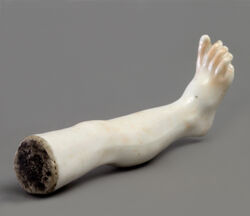
Le bourre pipe est un outil indispensable pour le fumeur. Il permet de maintenir une résistance correcte au flux d'air pendant le fumage, de sorte que le tabac continue à bien brûler. Tous les fumeurs de pipe savent à quel point c'est important. En tant que petit instrument maniable, le bourre pipe convient parfaitement aux conceptions curieuses, qu'il s'agisse de produits industriels ou d'objets artisanaux. Il n'y a pas un sujet qui n'existe pas en tant que bourre pipe. Ce bourre pipe en forme de jambe humaine nue a été fabriqué dans une usine de porcelaine allemande, probablement en Bohême, l'actuelle République tchèque. Une jambe de femme galbée avec une chaussure élégante est plus connue parce qu'elle donne une impression d'érotisme voilé. Les étudiants, en particulier, utilisaient ces instruments comme cadeaux, parfois même avec une inscription appropriée. Ce n'est pas le cas de cette jambe d'homme, surtout avec ses orteils horribles qui dépassent dans toutes les directions, ce qui fait de l'objet un article repoussant. Les restes mous de la couleur chair qui donnait à cette jambe son réalisme choquant révèlent que l'objet a été utilisé de manière intensive. L'entaille au-dessus de la cuisse offre une surface plane qui permet de trafiquer la pipe à sa guise. Au fil des manipulations, la subtile polychromie s'est usée jusqu'à devenir ce qu'elle est aujourd'hui. Cela semble prouver que le bourre pipe a été le favori de son propriétaire et qu'il a tourné cet objet des centaines de fois entre ses doigts.
Amsterdam Pipe Museum APM 24.668
PermalinkPipe de poche en forme de canoë
mai 2023
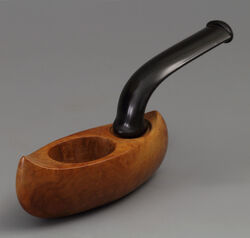
Cette pipe à tabac de poche, également appelée vest pocket, a un design original. Il s'agit d'une petite pipe courte avec un tuyau en caoutchouc dur, fortement incurvé. Tournée vers l'arrière, la pipe peut facilement être rangée dans la poche d'un gilet. La forme ronde et lisse de la pipe de poche est fabriquée par plusieurs fabricants. Un design qui séduit immédiatement de nombreux fumeurs, mais qui ne devient jamais vraiment un favori en raison du petit fourneau intérieur ovale. Le même principe avec la tête de pipe en forme de sabot a été populaire comme souvenir en Bretagne et aux Pays-Bas. La version représentée ici en forme de canoë canadien est un modèle atypique et le seul connu à ce jour. Elle a été conçue à Saint-Claude pendant l'entre-deux-guerres, mais n'est pas devenue un best-seller. Le foyer peu profond ne garantit pas le meilleur tirage et le tuyeau courte n'assure qu'un refroidissement modéré. Le fait qu'il s'agisse d'une pipe non fumée ne préjuge pas de sa popularité. Cet objet spécifique a été conservé dans une collection d'échantillons et est passé directement de l'inventaire de l'usine à la destination du musée avec nous. C'est précisément cet élément vierge et inutilisé qui confère aujourd'hui à l'objet son aspect particulier. En outre, malgré l'absence de marque, nous connaissons désormais le lieu de production.
Amsterdam Pipe Museum APM 24.657
PermalinkRaccords d'argent sur un pipe à eau
avril 2023
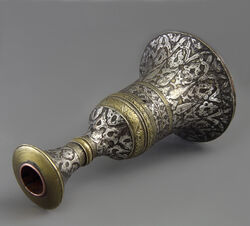
Ce fourneau est le couronnement chic d'une pipe à eau incontestablement huppée. Le matériau de base est le cuivre, décoré sur la face visible d'argenterie sciée et gravée et de laiton avec un motif ornemental de feuilles et de motifs géométriques. Les motifs sont en partie fixés au support à l'aide de clous, dans d'autres cas, ils sont soudés. La décoration est divisée en plusieurs zones, chacune présentant un motif différent d'intensité variable. Les cyprès, symbole de la renaissance, sont particulièrement frappants, entrecoupés de fleurs stylisées telles que des pivoines ou des roses, qui représentent la force et l'innocence. C'est surtout dans les détails que l'on voit clairement qu'il s'agit d'un travail fait à la main, comme les lignes ondulées formées à partir de fils de laiton. Cette technique laborieuse est caractéristique de l'ancienne Perse, l'Iran actuel, où la pipe à eau remplissait une fonction importante en tant qu'objet de statut pendant la riche période des Quadjars. Ce fourneau en argent couronnait une tige verticale qui reposait dans une bouteille d'eau en forme de goutte. Ce type de narguilé est appelé qualian. Outre la version en argent dont il est question ici, il existe des pipes de forme similaire peintes en émail coloré. Toutefois, la version en argent, sobre et chic, est plus élégante.
Amsterdam Pipe Museum APM 24.646
PermalinkPipe à tabac en marbre en forme de boule
mars 2023
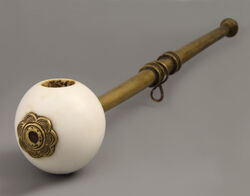
La collection de notre musée compte de nombreuses pipes d'un matériau exceptionnel, mais ce fourneau sphérique en marbre avec une monture en laiton est vraiment inattendu. L'objet provient de l'Himalaya où l'on trouve de riches rainures pour le marbre et d'autres types de pierres. Le crochet sur le tuyau suggère une utilisation par une tribu nomade pour laquelle le transport pratique de l'objet est important. Dans cette région, les pipes en forme de marteau avec un en pierre légèrement biconique sont courantes ; le tuyau en métal est toujours fixé à mi-hauteur du bol. La monture en laiton, souvent rehaussée d'un peu de cuivre rouge, apporte une touche attrayante. En outre, l'embouchure robuste en forme de bouton est caractéristique du Tibet en particulier, où elle se retrouve également dans les pipes en corne de yak. La forme de rosette à l'avant du fourneau, avec une gravure géométrique de lignes complétée par des hachures, est également typique et très charmante. La pipe provient de la région bordant le plateau tibétain, entre l'Inde, le Népal et le Bhoutan. La région d'origine exacte ne peut être indiquée, tout comme la datation reste un point de discussion. Le catalogue de vente aux enchères dans lequel cette pipe a été annoncée parle du dix-huitième ou du dix-neuvième siècle. C'est facile à dire, mais difficile à prouver. Outre l'usage personnel, de telles pipes servent également à la vente aux quelques touristes. Ceux-ci recherchent des objets de contemplation spirituelle, ce à quoi cette remarquable pipe à tabac répond parfaitement.
Amsterdam Pipe Museum APM 24.631
PermalinkDragon en bambou noir
février 2023
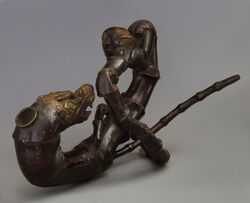
L'amour de l'Orient pour le bambou se reflète surtout dans l'adoration du bambou dit « noir ». Le bambou tel que nous le connaissons, mais en noir plutôt qu'en brun clair. Cette pipe présente un autre aspect qui ajoute à son attrait. L'objet n'est pas droit comme une lance, comme nous en avons l'habitude, mais a une apparence particulièrement ludique. Une tête de dragon a été sculptée dans l'embout le plus épais, avec une gueule ouverte et des dents pointues. La tête sculptée est recouverte de peinture dorée pour attirer l'attention. Le fourneau en laiton destiné à brûler le tabac est placé à l'arrière de la tête de dragon. Les Chinois auront admiré le corps fantaisiste et torsadé où le bambou se tortille dans toutes sortes de courbes inattendues en épingle à cheveux, ce qui correspond à l'amour des Chinois pour les formes inattendues créées par la nature. Par ailleurs, le conduit de fumée ne traverse pas l'ensemble de la branche de bambou torsadée, comme le suppose notre imagination. La fumée est déviée par une tige séparée qui sert à l'absorber. Il n'a donc pas été nécessaire de percer le reste du bambou, ce qui est techniquement impossible. Malgré les innombrables boucles du bambou, la tige proprement dite ne mesure que trente centimètres de long. De telles créations curieuses étaient destinées à se démarquer et appartiennent donc à la catégorie des raretés. Bien que cette pipe ait été fortement fumée, sa fonction première était sans aucun doute d'attirer l'attention et de susciter l'admiration de la nature. Elle doit dater de la fin du XIXe siècle.
Amsterdam Pipe Museum APM 24.620
PermalinkUn cheval et un poisson
janvier 2023
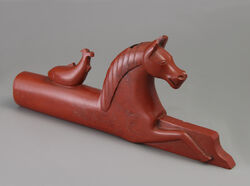
Le cheval est d'une grande importance pour les Indiens, pour le statut d'une personne et d'une tribu, mais aussi pour la chasse, par exemple au bison. Il n'est donc pas surprenant que le cheval soit souvent représenté. Le cheval volant, également appelé cheval courant, est l'un des préférés. Il s'agit d'un animal stylisé dont les pattes avant sont tendues vers l'avant, la tête et la crinière étant représentées dans un dessin lisse. Lorsqu'il s'agit d'une pipe à tabac, le fourneau est placé dans le cou et la tête de l'animal, les pattes avant dépassent alors le long de la tige allongée qui caractérise le calumet de la paix. Le motif du cheval a dominé l'art sioux pendant plus d'un siècle lorsqu'un autre animal est apparu comme motif vers 1900, à savoir le poisson. Cet animal n'a aucune relation traditionnelle avec ces peuples indiens, la représentation du poisson étant surtout considérée comme une représentation hautement commercialisable. À partir du moment où les Indiens doivent vivre dans des réserves, ils fabriquent leurs ustensiles décorés principalement pour le commerce et l'image d'un poisson s'avère rapidement populaire. Ce fourneau de pipe présente une combinaison des deux animaux. Le cheval volant domine le dessin de la pipe, mais on peut voir un poisson dans une pose presque acrobatique sur son dos. En examinant la surface de l'objet, on peut clairement voir des traces d'outils métalliques, ce qui confirme la datation relativement récente de l'objet en tant qu'art de réserve autochtone. La pipe est fabriquée par une sous-tribu des Sioux, les Nakota, également appelés Sioux de Yankton. Dans l'ensemble, cette image s'est bien vendue, notamment en raison de la couleur rouge frappante et presqu’irréelle de la pierre à pipe du Minnesota, mieux connue sous le nom de catlinite, qui est sacrée pour les Indiens.
Amsterdam Pipe Museum APM 24.600
PermalinkÉléphant à longue trompe
décembre 2022
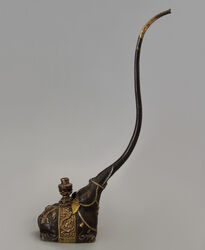
En Chine, la pipe à eau semble se limiter à un seul type. Les célèbres ensembles à fumer en paktong datent principalement du dix-neuvième siècle : une petite pipe à eau accompagnée d'un pot à tabac et de quelques outils de fumage dans une boîte, très pratique à emporter. C'était l'instrument de tous les Chinois qui voulaient fumer à l'eau. D'autres modèles ont existé, mais ils sont beaucoup plus rares. Les pipes à eau figuratives semblent avoir été fabriquées beaucoup plus tôt. Il s'agit de la représentation d'un éléphant couché dont la longue trompe, qui forme le tuyau de la pipe, est très élégamment courbée en forme de S. L'animal est décoré d'un harnais et d'une ceinture. L'animal est décoré d'un harnais à grelots et porte sur le dos un tapis de selle décoré en relief. La broderie montre une représentation très chinoise d'un dragon au corps frisé avec de longues franges sur les bords. Le tout est surmonté d'un vase dans lequel le fourneau de la pipe a été glissé en forme de fleur épanouie, avec une tige qui s'étend sous la surface de l'eau. L'ensemble est réalisé en laiton puis patiné en noir. Certains éléments ont gardé leur propre couleur et ajoutent un accent attrayant. Remarquez par exemple les défenses d'éléphant en argent sur le tuyau de la pipe. D'autres éléments sont dorés et rehaussent l'aspect de l'objet. La date de ces pipes est incertaine. Bien que la version légère du métal semble récente en termes d'âge, la littérature donne des dates très anciennes. La finition de cet exemplaire en laque noire en témoigne également. Compte tenu de sa grande rareté, une production au XVIIIe siècle est certainement possible, bien que nous manquions de preuves. D'autres exemples montrent une atmosphère du XIXe siècle, ce qui nous permet de conclure que la pipe à eau à éléphant a été fabriquée sur une longue période, bien que de manière éparse puisqu'elle reste un objet extrêmement rare.
Amsterdam Pipe Museum APM 24.613
PermalinkPipe totémique des Haïdas
novembre 2022
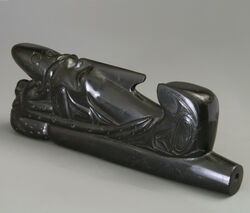
L'argilite se trouve sur l'île de la Reine-Charlotte, sur la côte ouest du Canada. Le mot est dérivé du mot français argille qui désigne une pierre argileuse et qui a une forte teneur en argile. Il s'agit d'une pierre noire proche de l'ardoise qui se coupe bien. La pierre se trouve principalement dans la carrière de Slatechuck Mountain, dans les eaux d'amont du ruisseau éponyme, sur l'île Graham. La sculpture haïda est l'une des rares formes d'art de la côte nord-ouest de l'Amérique qui soit la propriété exclusive d'un groupe culturel. Les Haïdas de cette région extraient cette pierre pour en faire des sculptures vendues aux marins et aux touristes. Ces sculptures artistiques, dont d'innombrables pipes à tabac, sont mondialement connues depuis leur création vers 1800. Cette renommée est en partie due aux représentations attrayantes, dans lesquelles toutes sortes de figures sont représentées dans un style reconnaissable. Les ours et les oiseaux sont très populaires, mais on trouve aussi d'innombrables représentations humaines. Les pipes haïdas sont principalement des pipes à panneaux, des plaques plates couvertes de figures. On fabrique également des totems, dont la conception tridimensionnelle est plus marquée, avec un accent vertical. La pipe actuelle ne présente pas les principales caractéristiques des deux espèces. Par exemple, la caractéristique plate de la pipe à panneaux n'existe pas, et la pipe ne suit pas non plus l'accent vertical du mât totémique. Il s'agit pourtant d'une véritable pipe à tabac, avec un fourneau relié à un tube à fumée se terminant par un embout, mais tout est caché dans les décorations. La particularité de ce produit réside dans le fait que les sujets sont exécutés dans différents styles qui, en termes de disposition, remontent à Picasso plutôt qu'aux Haïdas, ce qui rend cette pipe si exclusive. Nous voyons une tête de poisson stylisée et un autre animal à côté de têtes humaines ou de parties de celles-ci, tous les éléments passant de l'un à l'autre sans qu'on s'en aperçoive. La tradition de la sculpture sur pierre se perpétue encore aujourd'hui, mais cette merveilleuse création a dû voir le jour vers 1900.
Amsterdam Pipe Museum APM 24.603
PermalinkOiseau en vol
octobre 2022
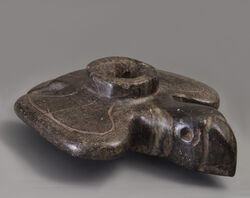
Avec une longueur de plus de vingt centimètres et un poids de plus d'un kilo et demi, cette majestueuse pipe à tabac est un bel exemple de pipe à tabac d'apparat. La réalisation d'une telle pièce a dû représenter un véritable tour de force. C'est en tout cas le cas si l'on considère que cet objet date de la préhistoire américaine, il y a environ mille ans, à une époque où les outils métalliques n'étaient pas encore connus. La pipe est un exemple de la culture du Mississippi, la dernière culture préhistorique d'Amérique du Nord avant l'arrivée des Européens. La société très hiérarchisée était bien organisée en plusieurs villes, dont il ne reste que les tumulus. C'est la raison pour laquelle ce peuple est appelé plus tard « bâtisseurs de tumulus » ou mound builders. Des pipes similaires ont été trouvées plus souvent par les archéologues américains. En général, ces pipes de grande taille sont fabriquées en stéatite, mais il s'agit d'une pierre plus dure. La piste de quartz qui court en diagonale sur le fourneau de la pipe a dû nécessiter beaucoup de temps de meulage supplémentaire. La pierre dure n'est pas facile à travailler, c'est pourquoi le dessin se concentre sur deux éléments : tracer les contours de l'animal et n'appliquer que quelques détails. Ce dessin est magnifiquement réalisé, stylisé mais puissant. Le créateur a eu plus de mal avec les détails. Par exemple, les lignes le long des ailes sont hésitantes et moins tendues qu'on ne l'aurait souhaité. Il n'en reste pas moins que cette réalisation force le respect à tous points de vue. Il existe plusieurs variantes connues de ce concept, identifié par les experts comme un faucon volant, de sorte qu'il semble s'agir d'un type. Bien que la pipe puisse être fumée à l'aide d'un tuyau en bois inséré dans la queue, il s'agit clairement d'un objet rituel, d'un produit destiné à une cérémonie funéraire. Au cours de ce rituel, la pipe était souvent enterrée et il a fallu des siècles avant qu'elle ne soit redécouverte. Il semble miraculeux que ce lourd objet ait été retrouvé intact, mais cela se comprend si l'on connaît la dureté de la pierre et si l'on considère l'usage rituel. De même, cette pipe est apparue un jour comme un artefact d'une tradition perdue depuis longtemps.
Amsterdam Pipe Museum APM 24.576
PermalinkSous la jupe
septembre 2022
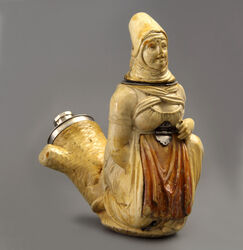
Les pipes à portrait sont intemporelles, mais la représentation d'une personne complète est moins courante. Peu après 1800, les pipes à tabac sont devenues populaires avec des représentations de personnes complètes, allant de colporteurs à un Turc assis ou même un chevalier en armure. Elles étaient taillées dans de l'écume de mer et, chose amusante, la tête basculait vers l'arrière à l'aide d'une charnière, ce qui permettait de remplir la pipe. Cette vendeuse du marché est l'exemple parfait de ce type d'objets : un art totalement folklorique, très attrayant en raison de son caractère reconnaissable, mais aussi un peu espiègle. Nous voyons une marchande assise avec un panier de petits pains frais à côté d'elle. En attendant ses clients, elle a glissé sa main sous les jupes et s'occupe agréablement. Vous le découvrirez en ouvrant le rabat caché dans les jupes. Comme c'est merveilleux, il existe deux versions de cette représentation, avec et sans outil ! En somme, il s'agit d'une représentation que l'on ne s'attend pas à trouver à cette époque. De telles pipes n'ont été populaires que pendant quelques années, les poinçons d'argent indiquant des dates entre 1805 et 1810. Après cela, elles ne sont plus jamais apparues sur le marché. Le fumeur en était-il gêné ? En tant qu'objet de conversation, l'invention était tout à fait inhabituelle et amusante, mais tous les fumeurs savent qu'une pipe en écume change progressivement de couleur à mesure que la pierre tendre s'imprègne de goudron et de nicotine. Avec ces pipes, l'espace creux sous les jupes garantissait que ce transport n'avait pas lieu. C'est pourquoi le fabricant pré-colorait le couvercle et le fumeur devait colorer lui-même la pipe en la fumant longuement. Ce n'est qu'à ce moment-là qu'une belle unité se produit. Pour de nombreuses pipes, cette coloration n'a été que modérément réussie, ce qui est l'un des facteurs de leur succès limité.
Amsterdam Pipe Museum APM 24.533
PermalinkTuyau de pipe en zigzag
août 2022
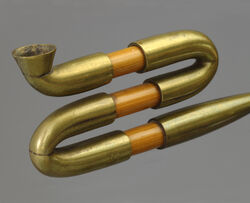
La pipe japonaise au nom mélodieux de kiseru est connue pour son très petit fourneau. La pipe a normalement un tuyau droit d'une vingtaine de centimètres. Le fourneau de la kiseru est en métal, de même que l'embout, tous deux montés sur un tuyau en bambou. À l'exception de la taille, il n'y a pratiquement aucune modification de cette uniformité. Exceptionnellement, il y a des découvertes imprévues. Ce kiseru japonais, dont la tige est constituée de trois morceaux de bambou en zigzag, est d'une conception merveilleuse. C'est une solution pratique pour refroidir la fumée avec un tuyau allongé, tout en restant capable de fumer une pipe pratique. Sans aucun doute, cette pipe appartient aux curiosités plutôt qu'aux ustensiles de luxe. Le métal en témoigne : le laiton utilisé est associé par les Japonais à une expérience gustative médiocre. En outre, ce design particulier présente un aspect négatif d'un point de vue technique. En raison des quatre pièces de métal avec un total de six soudures entre les différentes parties de la tige, il est difficile d'éviter les fuites d'air. Cela ne favorise pas le plaisir de fumer la pipe. Heureusement, les artisans japonais jouissent d'une excellente réputation, de sorte que la fabrication des raccords est étanche à l'air. Seul le dessèchement du bambou dû à l'âge peut entraîner un rétrécissement, ce qui réduit la perfection des raccords. À ce moment-là, la pipe n'est plus agréable.
Amsterdam Pipe Museum APM 24.507
PermalinkPipe en corail rustique
juillet 2022
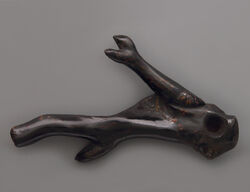
Cette pipe à tabac fabriquée à partir d'un morceau de corail noir n'est pas immédiatement reconnaissable comme une pipe, mais elle est vraiment spéciale. Dans la partie la plus épaisse de la branche, un fourneau semi-sphérique est percé, la souche de corail elle-même est percée pour le conduit de fumée qui se termine par une sorte d'embouchure à l'extrémité arrondie de la branche la plus longue. La couleur de ce matériau spécial est brun-noir avec des nuances plus claires en de nombreux endroits et parfois même des reflets dorés. Mais l'objet ne s'arrête pas là. Si l'on regarde de près, deux extrémités du corail semblent taillées en forme de poisson, dont l'une ressemble à une carpe tant les écailles sont explicites. En Asie, le corail noir est considéré comme une amulette ou un talisman contre les forces du mal, la maladie ou la malchance. C'est donc un matériau que les gens aiment porter sur eux. Il s'agit d'ailleurs d'une pièce exubérante, d'une taille considérable et d'un poids de plus d'une once. L'origine de cette pipe doit se situer en Chine, très logiquement dans l'une des villes côtières où l'on trouve du corail à portée de main. Malgré sa grande valeur en tant que porte-bonheur, le corail n'est pas très agréable en tant que matériau de pipe à fumer. Il confère une odeur et un goût désagréable au tabac, ce qui n'est certainement pas ce que souhaite un fumeur de pipe. Pourtant, cette pipe a été fumée intensivement, et le fumeur savait apparemment qu'il fallait tirer très doucement sur cette pipe pour ne pas laisser le plaisir de fumer être gâché par un goût rassis.
Amsterdam Pipe Museum APM 24.502
PermalinkBonnet pour fumeurs
juin 2022
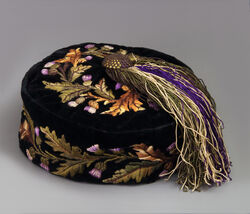
La grande importance du tabagisme au XIXe siècle se reflète dans les pipes à tabac exubérantes qui ont été fabriquées à cette époque. Mais la culture du tabagisme allait plus loin. Certains nicotinistes achetaient même un costume pour souligner l'atmosphère exotique de leur hobby, mais aussi pour des raisons pratiques. À la maison, il n'était pas nécessaire d'être habillé de manière aussi formelle et on utilisait donc une longue robe de chambre brodée. Un chapeau de velours plat et cylindrique complétait cette tenue. Tout ce velours absorbait la nicotine de la pipe et, plus tard, du cigare. Pendant le dîner, on portait un costume dite smoking, mais à l’époque dinner jacket, un costume habillé avec un nœud blanc. Pour boire un cognac et fumer, les messieurs se rendaient dans la bibliothèque, la salle de billard ou le fumoir, tandis que les dames se retiraient dans le salon pour prendre une tasse de thé. Les hommes remplaçaient alors leur dinner jacket par une veste courte en velours, proprement dite « smoking » et mettaient leur bonnet de fumeur. Ils savourent leur pipe, leur cigare, leur cognac et leurs conversations. À la fin de la soirée, ils changeaient à nouveau de veste pour que les dames ne soient pas gênées par l'épaisse fumée de tabac qui entourait les hommes. La tenue des fumeurs avait donc une fonction utile. La bonnet de fumeur, ou la calotte en français, est donc un chapeau spécial de forme cylindrique avec un sommet aplati et un grand pompon suspendu à un bouton décoratif. Il s'agit d'un dérivé du fez turc. L'importance du tabagisme au dix-neuvième siècle se reflète dans le fait que les chapeaux sont pourvus de magnifiques broderies aux innombrables couleurs sur tout le pourtour. Le fait que ces chapeaux étaient très appréciés se reflète dans la boîte à chapeaux en cuir spéciale dans laquelle ils étaient livrés pour être transportés et conservés. Le fait qu'une seule boîte à chapeau porte les initiales de son propriétaire prouve que ces boîtes étaient si courantes qu'il fallait les distinguer les unes des autres dans les lieux publics. Apparemment, elles étaient portées non seulement dans l'intimité de la maison, mais aussi dans les sociétés. Au club des gentlemen, il pouvait y avoir une douzaine de boîtes sur le portemanteau.
Amsterdam Pipe Museum APM 24.490a
PermalinkUn tubulaire avec des ailes
mai 2022
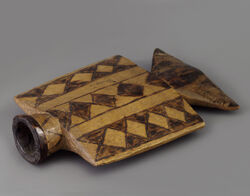
La pipe à fumer la plus primitive est la pipe tubulaire, un instrument de fumage principalement destiné à ceux qui veulent fumer en position allongée. On retrouve régulièrement ce souhait chez les Amérindiens, mais cette pratique existe aussi ailleurs dans le monde. Ce qui est certain, c'est que la pipe tubulaire est plus répandue en Amérique du Sud que partout ailleurs dans le monde. La spécificité des tubulaires méridionaux est l'embouchure en forme d'aile qui détermine l'aspect de l'objet. La pipe présentée ici, avec son embouchure triangulaire aplatie des deux côtés, en est un bon exemple, mais cette pipe a quelque chose de particulier. La zone entre l'embouchure et le fourneau n'est pas ronde comme d'habitude, mais fortement aplatie en un carré qui s'étend largement au-delà du tuyau proprement dit. En raison de cette forme dominante, la silhouette de la pipe est complètement différente de celle d'une pipe tubulaire standard. La décoration attrayante ajoutée à ce tuyau le rend également exceptionnel. Un motif géométrique identique a été peint de part et d'autre de la surface légèrement incurvée, consistant en trois bandes de carrés diagonaux reliés entre eux comme une chaîne. La coloration est ludique, en ce sens que la bande centrale présente des losanges sombres, tandis que les losanges extérieurs sont en miroir et se détachent sur un champ sombre. À la fin de la série, les diamants sont coupés en deux, ce qui accentue la continuité de la chaîne imaginaire. Cette pipe tubulaire est originaire du Gran Chaco au Paraguay et est donc connue sous le nom de pipe Paraquan ou Chaco. En termes de fonction, il ne s'agit pas d'une véritable pipe à tabac. Les Chaco utilisent la pipe comme un porte-cigare. Il n'y a donc pas de tabac pulvérisé à l'intérieur, mais le tuyau sert de support à des feuilles de tabac roulées serrées. L'art de fumer réside principalement dans le remplissage de la pipe, car lorsqu'onbourre la pipe, il est important de rouler les feuilles de manière à empêcher l'air de s'échapper. Cela demande un peu de pratique. C'est justement parce que le tabac brûle principalement à l'extérieur de la pipe que la pipe elle-même n'a pas été brûlée. C'est en partie la raison pour laquelle cette pipe est si bien conservée. Il est impossible de dire pour combien de temps, mais il s'agit certainement d'un siècle et demi.
Amsterdam Pipe Museum APM 24.446
PermalinkPipe coudé avec figure animale
avril 2022
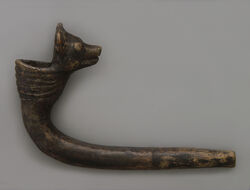
Avec les pipes à tabac des Indiens d'Amérique, l'association est vite faite avec les exemplaires en catlinite, la pierre rouge qui était principalement utilisée par la tribu des Sioux. Cependant, des pipes beaucoup plus anciennes proviennent des Iroquois, le peuple amérindien qui a habité l'est de l'Amérique du Nord pendant des siècles. Ils vivaient de l'agriculture et de la chasse et savaient fumer bien avant que les Européens ne s'y installent. Leurs pipes sont extraites de tombes dans lesquelles, en plus d'un simple bijou, l'instrument de fumage bien-aimé du défunt est remis. L'exemple présenté ici, ajouté à notre collection il y a plus d'un an, est représentatif des Iroquois. Cette pipe assez simple était fabriquée à partir d'argile roulée et modelée à la main, puis cuite dans un four de campagne. La fumée qui s'est dégagée pendant la cuisson a donné à l'objet une couleur brun-noir étouffée. La tige horizontale et le fourneau vertical sont reliés par une forme coudée, caractéristique de cette tribu indienne. À l'avant du fourneau en forme d'entonnoir aux anneaux concentriques, une figure animale est sculptée, parfois aussi une figure humaine. Ici, il semble s'agir d'un chien ou peut-être d'un coyote, le loup américain, qui regarde le fumeur avec la tête au-dessus du bord du fourneau. Le tuyau non lisse et les anneaux irréguliers de la pipe ont quelque chose de primitif. En même temps, la tête de l'animal est bien réalisée avec des formes simples, ce qui donne à la pipe un véritable caractère. C'est un type de pipe qui était particulièrement populaire aux XVIe et XVIIe siècles et qui a été remplacé par la suite par des produits importés d'Europe. Pour les Indiens, ces pipes à tabac importées avaient un statut plus élevé.
Amsterdam Pipe Museum APM 24.444a
PermalinkL'orientale avec ses bijoux
mars 2022
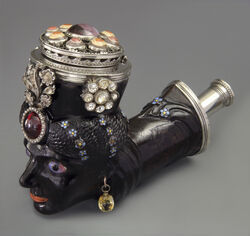
À notre époque où l'hypersensibilité à l'égard de la couleur de la peau est soulignée à maintes reprises, il est préférable de ne pas s'afficher avec la pipe représentée. À l'époque, elle était différente, elle attirait les regards et tout est fait pour en accentuer l'effet. Peu après 1800, lorsque cette pipe a été fabriquée, l'écume artificielle était un matériau nouveau et spécial. Comme cette pâte n'a pas la couleur idéale, elle a été recouverte d'une teinture noire brillante. C'est ainsi que cette femme orientale a pris l'apparence d'une négresse. Tout ce qui venait du Levant était populaire, le turban étant le symbole le plus emblématique souvent représenté. La curieuse combinaison de l'Orient et de l'Afrique rend la pipe encore plus exotique. Le matériau mystérieux aurait également pu être considéré comme de la laque noire à l'époque, avec l'éclat rare d'un Japon inconnu. Cependant, la tête du portrait n'est pas modelée très finement, le tige est trop lourd, l'ornement à l'extrémité du tuyau est une rocaille molle et le surprenant nez retroussé ne correspond pas bien à un Oriental. Mais ce qui frappe le plus, c'est la parure. Aucun effort n'a été épargné pour faire de cette pipe un objet de valeur. Les yeux sont en pierre de lune dans une monture d'argent et les lèvres sont en corail véritable. Les boucles d'oreilles sont des topazes taillées suspendues à une monture en or. L'épingle sur le devant montre une grosse pierre rouge vin sertie dans un cadre de paillettes transparentes, tandis que le panache est serti de pierres scintillantes taillées en brillant. Des deux côtés du tuyau, on retrouve la même monture argentée en forme de rosette, également sertie de pierres scintillantes. D'un autre ordre, le couvercle en argent contient huit pierres taillées en cabochon au sommet et une neuvième beaucoup plus grande au milieu. Il s'agit de belles pierres multicolores dans une variation attrayante. La surface d'argent permettant la circulation de l'air a été sciée en filigrane et comporte même une grande pierre décorative à l'intérieur. Cependant, l'or n'est pas le seul à briller. Les montures peuvent ressembler à du platine, mais ce n'est pas le cas, et les pierres taillées brillantes étincellent à en faire pâlir plus d'un, mais ce ne sont pas des diamants, mais du quartz taillé. Néanmoins, le fumeur qui a acheté cette pipe aura fait bonne impression en se présentant avec une pipe aussi étincelante. D'autant plus que le fourneau de cette pipe était monté sur un tuyau flexible en fil d'argent tressé. Nous ne connaissons pas l'origine de cette vanité et de cette vantardise. Il se peut qu'elle se soit trouvée en Russie, car la seule variante connue se trouve à l'Ermitage de Saint-Pétersbourg.
Amsterdam Pipe Museum APM 24.437
PermalinkArgent sur une forme de sac
février 2022
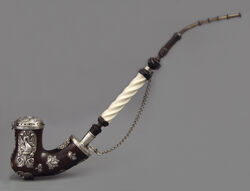
Dans le sud-ouest de l'Allemagne, dans la région de la Forêt-Noire, dans l'actuel Bade-Wurtemberg, le fumeur du XIXe siècle préférait se présenter avec une pipe à tabac ornée d'argent. La pipe représentée ici est un exemple typique de ce style. Bien que la coutume de recouvrir une pipe à tabac d'ornements en argent ait probablement été inventée à Ulm, elle s'est étendue à une région beaucoup plus vaste. Grâce à l'argenterie, la pipe représentée a certes l'air d'une pipe d'Ulm, mais la forme du fourneau ne l'est pas. Elle se situe entre la forme bien connue du sac et la forme hongroise, la première étant un modèle bas avec une forte convexité, la seconde un fourneau cylindrique haut et élancé. Les deux formes sont connues des pipes en écume austro-hongroises, mais on les voit rarement en bois. Bien que l'on sache que les tourneurs sur bois d'Ulm ont également fabriqué d'autres formes correspondant à un style qui prévalait ailleurs, l'apparition d'une pipe ornée d'argent d'un type autre que celui d'Ulm est plutôt inhabituelle. Ce que l'on constate souvent avec ces pipes décorées d'argent, c'est le manque d'unité. Toutes sortes d'ornements ont été cloués sur le bois, parfois presque au hasard, souvent selon un rythme agréable ou répartis uniformément sur la surface, mais pas toujours de façon cohérente sur le plan thématique. Il en va autrement pour cette pipe. Autour du fourneau, on trouve trois grands ornements représentant des oiseaux : à l'avant, un pélican avec ses petits, de part et d'autre, un cygne monumental en position d'attaque, les ailes déployées. La base et la tige de la coupe sont ornées de motifs décoratifs plus petits : palmettes, cartouches et couronnes, en partie dans le style néo-rococo. Comme à l'accoutumée, la tête de pipe est fermée par un couvercle à charnière, ici orné d'une rosette de fleurs tournantes astucieusement embossée et d'un cœur joliment hachuré. La plaque à pied lisse avec support de pied en argent se distingue par sa simplicité, de sorte que l'attention reste concentrée sur les autres pièces d'orfèvrerie. Dans l'ensemble, les ferrures en argent ont permis de transformer une simple pipe en bois en un objet luxueux. Le tuyau d'insertion s'inscrit dans ce cadre : un tournage artistique en corne avec une pièce torsadée de couleur ivoire entre les deux. L'extrémité du tuyau comporte une partie flexible qui permet de manipuler confortablement la pipe, munie de l'embouchure habituelle avec des nœuds. Dans l'ensemble, il s'agit d'une pipe d'exposition impressionnante et d'une excellente utilité.
Amsterdam Pipe Museum APM 24.394
PermalinkLe néo-gothique à son meilleur
janvier 2022

Il est surprenant de constater que l'histoire du porte-cigare n'est pas encore bien documentée. Alors que le fait de fumer le cigare était déjà connu en Espagne et au Portugal depuis la fin du XVIIIe siècle, les premières pipes à cigares conservées datent d'environ 1850. Au cours des premières décennies, le fumeur était tellement habitué à la pipe que pour fumer le cigare, on utilisait un modèle de pipe standard. Le cigare s'y tient debout. Ce n'est qu'en 1870 que le cigare descend à un angle de 120 degrés avec le tuyau. Ce porte-cigarette en écume est donc un bel exemple de la première forme. La pipe elle-même a une base ovale qui permet de la tenir confortablement. Le porte-cigare légèrement conique qui le surmonte a un diamètre intérieur correspondant à celui d'un cigare standard, car à l'époque, on ne fumait que de petits cigares. Cette forme ovale est répétée en écume de mer dans la tige. La tige est en bois tourné avec les nœuds habituels et se termine par une embouchure en corne de buffle. L'écume est fixée à la tige par une simple chaîne métallique. La surface de l'écume est exubérante, avec des ornements néogothiques qui donnent un beau rythme. Le style est basé sur la variante anglaise, le gothique tardif perpendiculaire avec une abondance de lignes. Cette décoration, composée de trilobe et quatre-feuilles , de diamants et de bandes tressées, s'étend jusqu'à quatre couches de profondeur. Grâce à l'étui, nous savons que le vendeur de l'époque était un certain Peter Keiss, qui tenait une boutique dans la chic rue commerçante Graben à Vienne. Nous ne savons pas s'il est lui-même le sculpteur de cette création remarquable ou s'il n'en est que le revendeur. Dans de nombreux cas, les adresses sont celles du commerçant, la fabrication ayant eu lieu ailleurs. La datation de cette pipe est tout à fait inattendue. Le style néo-gothique a été populaire pendant une courte période, surtout dans les années 1830, puis a rapidement disparu. Compte tenu de la forme, il faut en réalité voir dans cette pipe un porte-cigares précoce, pourvu d'une décoration néogothique à la mode. En l'espace de quelques années, ce style est déjà obsolète, ce qui fait de cette pipe une rareté.
Amsterdam Pipe Museum APM 24.337
PermalinkVitraux d'église datés précisément
décembre 2021
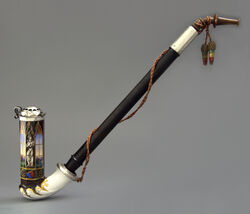
Il n'y a pas si longtemps, ce type de pipe, avec son haut fourneau polygonal et ses peintures de vitraux d'église, était attribué à la manufacture royale de porcelaine de Meissen et considéré comme datant du XVIIIe siècle. Aujourd'hui, nous en savons plus. L'ouvrage de référence de Morgenroth sur les pipes en porcelaine de 1989 indique le lieu de production correct, mais peu de collectionneurs l'ont remarqué. Il semble qu'il s'agisse d'un produit typique fabriqué dans la ville de Pirkenhammer en Bohême par l'usine Fischer & Reichenbach fondée en 1803. Cela signifie que ces têtes de pipes polygonales ne datent pas du Rococo mais de la période Biedermeier et qu'elles ne sont pas saxonnes mais bohémiennes. La fabrique de Pirkenhammer était connue pour produire ce type de pipe, mais elle n'apposait que rarement une marque sur ses pipes. Les fourneau hexagonaux ou octogonaux, disponibles en deux variantes de peinture, firent fureur. Fischer & Reichenbach introduit le motif gothique sur la porcelaine. La variante foncée comme celle-ci est peinte avec des murs historiques en pierre alternant avec des fenêtres d'églises gothiques, entrecoupées ou non de statues de saints ou, comme ici, de figures de chevaliers. Les fenêtres offrent une vue sur un paysage de montagne avec des châteaux fantastiques, de quoi faire rêver. Il existe également des versions plus transparentes avec un fond blanc et des couleurs vives, généralement avec plus de feuilles d'or. Cette pipe se distingue par un aspect. Dans l'espace étroit entre le fourneau et la tige, le décorateur de porcelaine a discrètement peint le millésime 1832. Grâce à cet ajout unique, il s'agit de la seule pipe à tabac datée de ce type en provenance de Bohême. Cette pipe à tabac, avec son couvercle à charnière en argent typique et son tuyau monté en argent avec le cordon de fermeture d'origine, est un exemple magnifiquement préservé. L'année peinte la rend datable et donc unique.
Amsterdam Pipe Museum APM 24.322
PermalinkDesign contemporain
novembre 2021
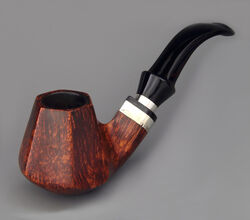
A partir du moment où la pipe de bruyère est fabriquée à la machine, différents acteurs déterminent successivement l'offre du marché. Dans un premier temps, la France donne le ton. De manière assez inattendue, l'Irlande fait son apparition à partir de 1900. Ensuite, d'autres pays, comme l'Angleterre, dominent. Le Danemark joue un rôle de premier plan dans les années 1970, principalement en raison de ses dessins libres, dite free-hands. Par la suite, les pipes italiennes se distinguent par leur qualité et leur design attrayant. La pipe de ce mois-ci est un produit italien et présente diverses influences qui la font correspondre à l'époque de sa création. Son apparence lourde est basée sur le goût allemand, où les fumeurs utilisent en moyenne des pipes à tabac plus grandes. Le système de filtre de 9 millimètres qui lui est appliqué provient également de ce pays. La tête hexagonal est un élément de tous les temps, mais son exécution est toujours différente. Il est rare de voir une forme aussi sévère et dominante qu'ici, puis une forme pyramidale appelée vulcano. Si nous regardons le montage, nous constatons là aussi une évolution. L'aluminium a longtemps été indésirable, l'argent ou le laiton étant préférés. Après l'an 2000, l'aluminium devient soudainement populaire. La deuxième bande de métal sur la section de la tige est bien sûr copiée sur la monture de l'armée qui a été inventée des générations plus tôt. Ici, la deuxième bande n'est pas utilisée pour la solidité, mais uniquement pour la décoration, bien qu'elle camoufle également l'espace de filtrage. Même le matériau de la tige a changé au fil du temps : le caoutchouc dur a été remplacé par l'acrylique. Il est plus brillant et reste toujours noir, mais il est malheureusement un peu plus dur et le fumeur s'en rend compte au niveau des muscles de sa mâchoire. Cette pipe a été fabriquée par Sir Del Nobile Pipes en Italie, une usine à l'histoire remarquable. L’atelier a été initié par la société new-yorkaise Frank pour la production de ses pipes de qualité supérieure. En fin de compte, le contrôle entre l'Amérique et la Toscane a posé des problèmes et la coopération a été interrompue. Quoi qu'il en soit, cette pipe est un bon exemple d'un beau produit artisanal de design international du début du XXIe siècle.
Amsterdam Pipe Museum APM 24.299d
PermalinkDu nord froid
octobre 2021
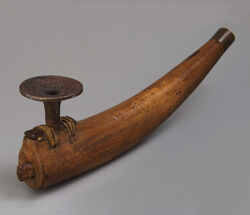
La culture des Inuits d'Alaska est caractérisée par la rareté et la simplicité. Il s'agit d'un peuple qui possède peu de biens matériels et qui, en raison du climat, doit se passer de beaucoup de choses. Fumer la pipe est un passe-temps agréable en Alaska, même si cela a longtemps été un luxe. Le tabac étant importé, il était rare et utilisé avec parcimonie. C'est également le cas des pipes à tabac des Inuits. Elles se distinguent par leur petit fourneau qui est toujours entouré d'un disque. Lors du remplissage et du nettoyage de la pipe, ce disque permet d'éviter que les miettes de tabac ne tombent et ne se perdent. Après avoir fumé, les cendres sont même tamisées sur les fils de tabac utilisables. La conception de cette pipe en bois simple est empruntée aux homologues en défense de morse. Dans ce prototype, un fourneau séparé est placé sur un morceau de dent qui sert de tuyau. La partie la plus épaisse de la dent se trouve sous le fourneau, la dent se dirige vers l'embouchure, tout à fait dans sa forme naturelle. La courbure légèrement ascendante du tuyau s'inspire donc également de la forme courbée de la défense de morse. Cette forme stéréotypée est restée inchangée sur cet exemplaire en bois. Le fourneau lui-même ne pouvait pas être en bois, c'est le fer forgé qui a été choisi. Cette pièce a été fabriquée par un forgeron local, peut-être même pas en Alaska, mais plus loin. Le fourneau en métal est fixé au tuyau par une simple couture en cuir. Le perçage de la tige était une question distincte. Cela se faisait par les deux extrémités, à mi-hauteur de la tige, là où les deux tubes à fumée se rejoignent, il y a même une ouverture, scellée par un couvercle en bois. Sous le fourneau se trouve un bouchon en bois qui ferme l'extrémité du tube à fumée. En retirant ces deux pièces de bois, le fumeur a pu nettoyer correctement sa pipe. L'embout en os s'est perdu avec le temps. D'apparence simple, il s'agit d'un bel ustensile de fumage ethnographique.
Amsterdam Pipe Museum APM 24.295
PermalinkMousquetaire en blanc-de-Chine
septembre 2021
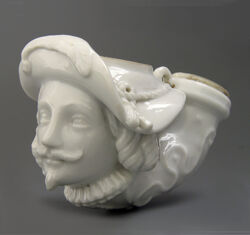
Le créateur de ce tête de pipe en porcelaine non peinte a donné au mousquetaire à moustache et barbiche une apparence typique du XVIIe siècle. Cette apparence est accentuée par un chapeau à larges bords avec une plume, des boucles de pipe sur les épaules et un modeste col à volants. Caractéristique de l'époque de sa création, la manchette à bord montant est destinée à fixer un porte-tiges en argent. De plus, on remarque que le cordon du chapeau se relève légèrement pour servir très subtilement d'œillet pour un cordon de securité. À l'origine, un mousquetaire désignait un garde municipal qui maintenait l'ennemi à distance à l'aide de son fusil à mousquet. À partir de 1844, le mot mousquetaire prend un nouveau sens grâce au roman du Français Alexandre Dumas : Les trois mousquetaires. Ceux-ci faisaient partie de la garde d'honneur du roi de France entre les années 1620 et 1640. D'Artagnan y tenait le rôle principal, aux côtés des mousquetaires Aramis, Athos et Parthos. Ce majestueux fourneau en porcelaine a dû être conçu au début de cet engouement, peu après 1844. Le motif global est typique du Second Empire, même si, dans les détails, on retrouve les caractéristiques de la tradition porcelainière du XVIIIe siècle, en particulier dans le jabot à volants. La taille et le décor de la tige, en revanche, sont caractéristiques de l'époque de création, comme en témoigne l'ornementation quelque peu imprononcée de la tige. La version Blanc-de-Chine est attrayante. Avec la peinture aux couleurs criardes des années 1840, une grande partie de la subtilité du dessin aurait sans doute été perdue.
Amsterdam Pipe Museum APM 24.286
PermalinkTête de personnage en écume de mer
août 2021
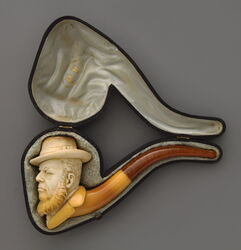
Le portrait de cet homme barbu coiffé d'un chapeau ressemble à celui de Paul Krüger, le président sud-africain qui connut une grande renommée internationale vers 1900. Il y avait donc toutes les raisons de fabriquer une pipe représentant son buste. Mais ce n'est pas le cas. En y regardant de plus près, on s'aperçoit que certains détails ne sont pas corrects. Par exemple, le chapeau est trop informel, Krüger portait un haut-de-forme standard, après tout il était le président de l'État. Le visage est également trop jeune et énergique compte tenu de la date de la pipe. Au lieu d'une personne existante, c'est un type qui est représenté ici. Il s'agit de la tête stéréotypée d'un fermier sud-africain, qui ressemble presque inévitablement à Krüger. Depuis la création de la pipe à portrait en écume, vers 1870, les races et les types font partie des images populaires. Cette création s'inscrit dans cette tendance, étant donné la finesse de la sculpture, qui a été réalisée par un ouvrier qualifié qui a su réaliser les bonnes proportions et créer un buste attrayant. Le fait que la pipe ait pu être offerte au fumeur sous le nom de Krüger dépasse l'intention du fabricant. Compte tenu de la marque d'étui avec les initiales P.F., la pipe semble destinée à être vendue en Belgique à une époque où la popularité de Krüger était déjà terminée. On ne peut que deviner ce que le futur acheteur a vu dans ce portrait à cette époque. Quoi qu'il en soit, le fumage a donné à la pipe une belle patine, avec l'anneau de barbe et les revers de couleur jaune-ivoire.
Amsterdam Pipe Museum APM 24.283
PermalinkRéservoir narguilé Bidri
juillet 2021
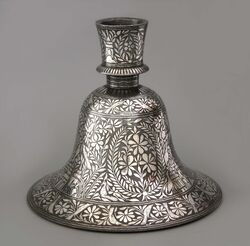
Cette bouteille en forme de cloche est la base du narguilé ou hubble-bubble. Avec son large fond plat et sa forte silhouette en forme de cloche, c'est un objet robuste. En outre, elle représente un objet de luxe en raison de la technique de décoration. Ce réservoir d'eau provient de la région de Bidar en Inde. Les artisans locaux fabriquent ce que l'on appelle l’art de Bidri, une technique métallique réputée depuis des siècles. Les objets en fer auxquels on ajoute un peu de cuivre et de zinc sont gravés sur la face visible. Cette décoration est ensuite remplie d'argent. Cela crée une belle nuance entre deux teintes de métal. Outre les vases et les pichets, la production de réservoirs de pipes à eau et parfois même de têtes de pipes a été importante. Cette bouteille en forme de cloche est la base de narguilé la plus courante en termes de type. En tant que forme, elle n'est pas rare, mais la riche application de la technique Bidri rend l'objet luxueux et très attrayant. La décoration est en horror vacui : toute la surface du réservoir est pourvue d'incrustations d'argent. Notez les bandes circulaires avec de belles volutes entre lesquelles on peut voir des oiseaux, qui constituent le cadre de la représentation principale. Le motif central est formé par trois médaillons debout remplis de motifs végétaux, l'espace entre les ovales montre quelques temples complétés par différents animaux cachés dans des branches de feuilles sur la ligne de base. Ce qui compte pour cette œuvre Bidri, c'est que plus c'est riche, mieux c'est.
Amsterdam Pipe Museum APM 24.278
PermalinkStaffordshire par paire
juin 2021
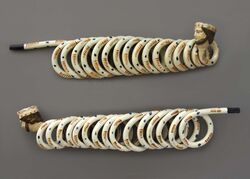
Les pipes à tabac à tige enroulée sont connues sous le nom de « Pratt ware ». Il s'agit de pipes en argile cuite blanche avec de longues tiges tressées ou torsadées avec art. Elles sont recouvertes d'une glaçure transparente accentuée par des touches de peinture aux couleurs vives. La production a eu lieu dans la ville anglaise de Stafford, un important centre de céramique. La tradition veut que les pipes ainsi tressées aient été fabriquées pour la première fois par les frères Felix Edward et Richard Pratt, qui dirigeaient ensemble la Fenton Pottery. En raison de l'enroulement des tiges dans toutes sortes de courbes inattendues, on parle aussi de pipes en forme de puzzle. La particularité des deux pipes présentées n'est pas l'enroulement des tiges, mais le fait que deux pipes presque identiques ont été conservées ensemble pendant deux siècles. Cela s'est passé dans une demeure anglaise jusqu'au moment où elles ont été mises sur le marché récemment. Les deux pipes suivent le même concept, mais avec de petites variations. Le façonnage à la main a entraîné des écarts de dimensions, mais un changement conscient est, par exemple, la position de la face du fourneau. Il ne fait aucun doute que c'est la même main qui a fabriqué ces pièces et qui a veillé à ce que l'exécution et la palette soient les mêmes, mais que les détails diffèrent. Bref, une fausse paire. Le fait qu'elles soient encore ensemble est une grande chance. Elles prouvent la production en série de cette poterie et montrent les petites nuances du potier. La datation se situe entre 1820 et 1840.
Amsterdam Pipe Museum APM 24.257a
PermalinkAnimaux mythologiques
mai 2021
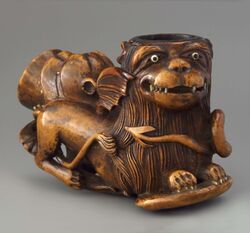
Le sculpteur a entrelacé deux animaux d'une manière particulièrement habile dans ce fourneau. Un lion couché domine, de l'autre côté on voit un animal mythique qui ressemble le plus à un dragon : un quadrupède nu avec une grande tête, des ailes hautes sur les épaules et une longue queue se terminant en pointe de flèche. Il s'agit en tout cas d'un animal assez hybride qui fait appel à l'imagination. Un dragon crachant du feu est la représentation la plus proche, bien que toutes les caractéristiques du dragon soient modérées. Le fait que l'animal crache de la fumée plutôt que du feu est tout à fait approprié à la tige. Sachant que les bois clairs sont largement utilisés pour les pipes à tabac en Scandinavie, cet objet doit également provenir de cette région. Il serait donc logique que les deux animaux représentent ensemble une histoire locale empruntée à l'un des innombrables mythes ou légendes locaux. Cette combinaison originale de deux animaux puissants qui semblent s'étreindre est habilement réalisée par le sculpteur sur bois. Le fond du fourneau de la pipe prouve qu'il s'agit d'une sculpture complète. Un ornement en forme de S est sculpté avec des traits très subtils de style Louis XV. Les modestes ornements de la volute donnent l'impression qu'il s'agit d'une véritable pièce du XVIIIe siècle. Cette datation précoce est également confirmée par la subtilité avec laquelle les détails des deux animaux, tels que les yeux, les dents et les ongles, sont incrustés dans l'os. Avec leur couleur jaune-blanc, ils tranchent sur la teinte brune de l'objet et apportent de beaux accents, tout en témoignant d'une grande maîtrise artisanale.
Amsterdam Pipe Museum APM 24.249
PermalinkStatue Ifugao comme fourneau de pipe
avril 2021
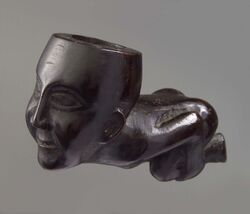
On pourrait qualifier cette pipe à tabac sculptée de primitive mais expressive. Le fourneau de la pipe est caché dans la tête du personnage représenté, le montage du tuyau est formée par un corps accroupi avec les jambes relevées, les mains tiennent les cuisses et bloquent sa position inconfortable. En raison de l’angle entre le fourneau et la tige, sa tête se trouve dans le cou, ce qui ajoute de la tension et du dynamisme à cette figure joyeuse. Cette jolie pièce sculptée provient des Philippines et a été réalisée par le peuple Ifugao, qui vit dans la province éponyme d'Ifugao, au centre de l'île de Luçon. Le mot Ifugao signifie littéralement « peuple des montagnes » et leur art et leur artisanat en témoignent également. Outre la vannerie, ils sont connus pour leurs sculptures sur bois. Les figurines du dieu du riz Bulul, généralement représenté assis, sont particulièrement caractéristiques. Cette pièce sculptée présente la même stylisation attrayante, mais aussi un détail subtil. Contrairement aux dieux du riz debout qui doivent provoquer une bonne récolte, l'attitude de la pipe est beaucoup plus enjouée. En fin de compte, la position debout est assez statique, tandis que l'attitude fantaisiste, entre ramper et s'asseoir, est nettement plus dynamique. Chez les Ifugao, l'artisanat fait partie des activités de la journée, après quoi il est temps de fumer la pipe. Un morceau de roseau ou de bambou est utilisé comme tuyau de la pipe. Le type de bois massif garantit la durabilité.
Amsterdam Pipe Museum APM 24.236
PermalinkUn baril de tabac personnalisé
mars 2021
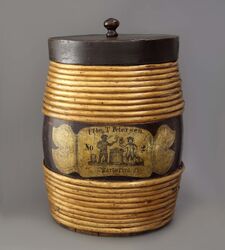
Ce baril de tabac est un objet tabacologique magnifique. Construit à partir de douelles et maintenu par de gros cercles de l’osier, un tonneau de forme robuste a été créé, fermé par un couvercle en bois noirci avec un bouton. Ces tonneaux étaient utilisés dans les bureaux de tabac. Ils contiennent du tabac fraîchement coupé, qui est versé dans des sacs ou des paquets pour les clients. Ce qui est intéressant dans ce tonneau, c'est qu'il ne porte pas les numéros habituels, mais une image peinte. Au centre du tonneau se trouve une vignette du commerçant Ubbo T. Petersen de Norden, une ville de l'Ost-Friesland située non loin de la frontière avec Groningen. Il s'agit d'une image caractéristique de l'emballage du tabac des siècles passés : un marchand de tabac à droite, un maure fumeur à gauche et un baril de tabac entre les deux. En dessous, on peut lire le nom générique du tabac : Portorico. Par une coïncidence miraculeuse, une vignette imprimée sur papier de ce marchand de tabac a été conservée, également dans la collection de notre musée. Cette vignette est nettement plus primitive que la peinture sur le tonneau et date d'une époque plus tardive. Le fait que Petersen recommande son commerce en néerlandais sur sa vignette indique qu'il faisait de bonnes affaires avec les Néerlandais. Par ailleurs, la peinture sur le baril de tabac ressemble fortement à une gravure, mais elle est en réalité peinte à la main. Cette dernière fait le charme de l'objet.
Amsterdam Pipe Museum APM 24.212
PermalinkCalao sur la tige de la pipe
février 2021
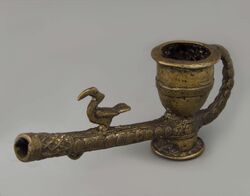
Du peuple de chasseurs de têtes des Naga, qui vit dans le nord-est de l'Inde, nous connaissons les pipes en bois décorées d'une rangée de figures le plus souvent décapitées. Le fourneau de pipe présenté ici provient de la même population, mais a été fabriqué par une autre sous-tribu, les Kuki. Il s'agit d'une pièce Naga tout aussi caractéristique mais beaucoup plus rare, provenant d'une région qui se prolonge en Birmanie. Cette réalité géographique se retrouve dans la conception de la pipe. Le bois n'est pas utilisé dans ce cas, mais le métal, ce qui rend la pipe indestructible. Les moulages en laiton présentent des caractéristiques similaires à celles des Batak de Sumatra et des Lanna du Myanmar. Le fourneau de la pipe est fabriqué selon la méthode de la cire perdue. L'objet est sculpté dans la cire, puis emballé dans l'argile. L'argile est cuite à un petit feu où la cire fond et s'écoule. Cela crée un moule primitif que l'on remplit de laiton. Une fois cette étape franchie, le manteau est brisé et le moulage en sort. Elle est finie et polie. Différents styles se côtoient dans ce fourneau de pipe. La tête de pipe en forme de bol sur une base conique est typiquement birman. Le tuyau carré avec une pointe merveilleusement continue qui se termine par une boucle sur l’autre coté du fourneau n'est pas connu dans les pipes d'autres peuples. La décoration du tuyau avec de fines spirales se retrouve également dans d'autres objets métalliques asiatiques. Enfin, l'oiseau assis sur le tuyau est le plus caractéristique. Il s'agit du calao au grand bec crochu, appelé Bucerotidae, qui vit dans cette région. La date de cette pièce est assez précoce, nous reconnaissons une exécution du milieu du XIXe siècle.
Amsterdam Pipe Museum APM 24.204
PermalinkUn train qui fume
janvier 2021
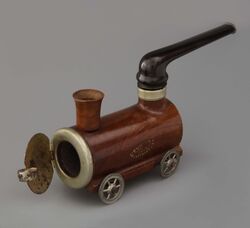
Dès le XIXe siècle, les fabricants de pipes en terre produisaient des pipes à titre de curiosité, par exemple avec un fourneau en forme de locomotive de train, muni d'un tuyau pour aspirer la fumée. Cette pipe en bois pourrait bien s'en inspirer. Il s'agit toutefois d'un produit de l'industrie de la bruyère qui s'inscrit dans une série de curiosités similaires. Le fourneau cylindrique est muni d'un couvercle métallique à l'avant, qui empêche la cendre et les miettes de tabac de tomber. En bas, deux axes d’essieux supportent des roues métalliques rotatives, de sorte que la pipe peut rouler sur la table et devient soudain un jouet d'enfant. Le tuyau est un élément moins logique, il est purement fonctionnel et fait de caoutchouc dur. Si vous ne tirez pas sur la pipe pendant un moment, un panache de fumée s'échappera de la cheminée de la locomotive, ce qui est bien sûr très amusant. Apparemment, le fabricant était fier de sa création : sur le côté de la locomotive, il a apposé sa marque d'usine, doublée d'or pour la rendre visible. On y lit le nom de Regad, fabricant de pipes à Saint-Claude, actif de 1875 jusqu'à la Première Guerre mondiale. En regardant de plus près la pipe, il est décevant de constater que du mastic a été utilisé à de nombreux endroits, le bois de bruyère est criblé de trous. Pour Regad, cette curiosité ne s'arrête pas là. En 1905, il lance la Peugeot Bébé, un modèle beaucoup plus élégant et réussi, sous la forme d'une voiture de tourisme de luxe. Ces deux créations sont aujourd'hui très recherchées par les collectionneurs de pipes en bruyère, mais aussi par les amateurs de trains et de voitures miniatures.
Amsterdam Pipe Museum APM 24.195
PermalinkFumeur de pipe assis des Kuba
décembre 2020
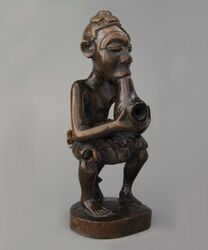
Cette magnifique sculpture en bois africaine représente un homme assis sur un tabouret et fumant la pipe. La statue a une hauteur de seize centimètres et un diamètre d'un peu plus de six. L'habile sculpteur a créé une œuvre d'art magnifiquement équilibrée dont la silhouette est attrayante de tous les côtés, ce qui constitue un élément important du charme de l'objet. En termes de travail manuel, l'accent a été mis sur la tête de la personne, avec la coiffe, les yeux et la bouche clairement dans le style Kuba. Plus bas dans la statue, les détails sont moins élaborés : le pagne, par exemple, est même taillé à la hâte, puisqu'une ceinture de fibres lui a été ajoutée par la suite. Dans la tribu Kuba, la coiffe confirme que la tête est la source du pouvoir divin. C'est pourquoi cette partie est montrée avec le plus de détails. Naturellement, l'accent est mis sur la pipe que l'homme fume. Sa forme ressemble beaucoup à la pipe en calebasse que l'on fume dans d'innombrables régions du Congo. Le fruit évidé sert d'espace de refroidissement pour la fumée, tandis qu'un fourneau en terre cuite est normalement utilisé pour brûler le tabac. La particularité de cette statue est qu'il s'agit d'une véritable pipe : son propriétaire l'a fumée à l'aide d'une paille insérée dans la tête du personnage en guise d'embout, et la pipe de l'homme était remplie de tabac. Une belle pièce décorative, mais certainement pas une simple pipe ornementale, l'objet a été fumé de nombreuses fois. Heureusement pour nous la pipe n’est pas fumé si souvent que elle s'est consumée. Le fourneau minuscule est quelque peu inattendu pour une région où le tabac est largement disponible. Nous connaissons d'innombrables pipes géantes du Congo, mais nous voyons tout aussi bien des pipes de petite taille comme celle-ci.
Amsterdam Pipe Museum APM 24.089
PermalinkTête de Turc de Gouda
novembre 2020
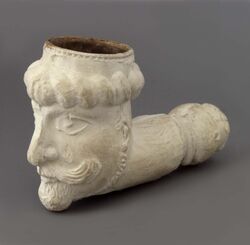
Vers 1700, le mouleur de Gouda Crijn Dircksz. Veverloo a conçu un fourneau de pipe en forme de tête de Turc. Pour l'époque, il s'agissait d'une création remarquable : une tête quelque peu primitive avec un grand nez, des yeux et des oreilles mal profilés, une simple barbiche et un turban marqué de rouleaux obliques. On sent que l'artisan a cherché une image sans avoir d'expérience. Le simple turban suffit à suggérer qu'il s'agit d'un Oriental, mais certainement pas d'une représentation artistique. À l'époque, l'invention était toutefois particulière, car il n'y avait pratiquement pas de pipes figuratives à Gouda. En fin de compte, sa création s'est avérée être une bonne idée, et la pipe est rapidement devenue populaire. Bien que nous ne sachions rien sur les clients potentiels ou sur la zone de vente, ce modèle a été fabriqué et copié dans d'innombrables variations. Il s'agit généralement d'une pipe à tuyau, comme la plupart des pipes en terre de Gouda. Il existe également une version à manchette, une tige tronquée comme celui-ci. Pour compléter la pipe, un tuyau de roseau est insérée dans l'extrémité de la tige. Cette façon de monter la pipe est inspirée de l'Europe centrale. Ce qui est inattendu dans cette pipe à tabac, c'est qu'elle ne porte pas le cachet de la marque habituel avec l'arbre de Veverloo, mais la marque du pipier, le lys. À l'époque, le lys appartenait à Neeltje Lamberts Verwint, veuve de Joost Pieterse de Meijer, un important négociant en pipes. Il est tout à fait exceptionnel que cette pipe, trouvée en surface, soit ressortie intacte.
Amsterdam Pipe Museum APM 24.086
PermalinkUne paire de tabatières coquilla
octobre 2020
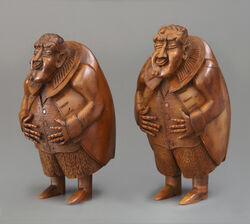
On sait peu de choses sur la production de curiosités fabriquées à partir de la noix de coquille dure. L'idée romantique selon laquelle ce travail a été réalisé par des marins portugais au Brésil dans l'attente d'un vent de retour favorable ne peut pas être vraie. Compte tenu de l'importance de la production, de la diversité des styles et du professionnalisme de l'exécution, il s'agit plutôt d'un objet d'artisanat européen fabriqué en série depuis plusieurs décennies. Les noix, apportées d'outre-mer des Antilles, étaient traitées par des coupeurs qui effectuaient ce travail quotidiennement. Ces deux tabatières amusantes prouvent que la production est plus sérielle qu'on ne veut bien le croire, car elles sont presque identiques. Le sculpteur a réussi à reproduire exactement l'image et n'a pas laissé libre cours à son imagination, seules les proportions sont légèrement différentes. Les deux personnages sont fabriqués à partir d'une noix creusée, les pieds et le couvercle à charnière à l'arrière sont découpés dans une autre noix et ajoutés. Il est étonnant que notre collection puisse présenter deux pièces aussi identiques et prouver ainsi la fabrication en série. Pour ceux qui sont prêts à relever le défi, je dirais : repérez les différences !
Amsterdam Pipe Museum APM 24.053a en APM 24.053b
PermalinkStyle Louis XVI pur
septembre 2020
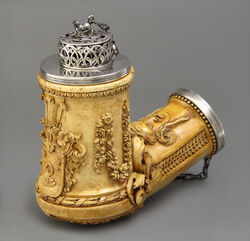
Sur cette fabuleuse pipe avec les armories personnels, toutes les caractéristiques de style sont vraiment Louis XVI. Cela s'applique non seulement aux différentes parties, telles que les frises à paillette et en perles, mais aussi à l'effet global. La période du style Louis Seize se caractérise par une relation exceptionnellement subtile entre les ornements. Simplicité, ordre et symétrie, mais en même temps force de détails. Cette pureté se retrouve de manière optimale dans cette tête de pipe. L'effet est toutefois assez inhabituel. Si l'on cherche des pièces comparables dans la littérature, on ne trouve pratiquement rien de semblable. La question se pose de savoir s'il s'agit d'un véritable objet du dix-huitième siècle ou d'un objet de la seconde période, c'est-à-dire du deuxième quart du dix-neuvième siècle. Dans un cas, il s'agit de la préhistoire de la pipe en écume, dans l'autre, il s'agit d'un autre exemple de l'époque de la production de masse. Ce qui plaide en faveur d'un sculpteur du XVIIIe siècle, ce sont les caractéristiques exactes du style. Il y a d'abord la monture en argent. Le couvercle se fixe autour d'un anneau. Chaque fumeur sait qu'un tel couvercle tombera facilement de la pipe, c'est pourquoi un couvercle à charnière est rapidement devenu la norme. Le chien sur le couvercle est également subtil, une caractéristique plus ancienne que tardive. Malheureusement, les poinçons de garantie estampillées sur le couvercle d’argent n'offrent pas de clé pour la datation. Pour l'instant, j'ose voir dans cette pipe, un objet rare, une authentique pièce de la fin du XVIIIe siècle.
Amsterdam Pipe Museum APM 24.020
PermalinkPêcheur breton
août 2020
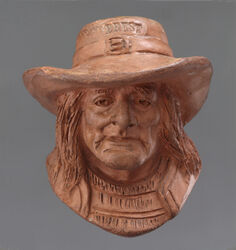
La Bretagne occupe une place à part dans la culture française. Là, surtout dans les villes côtières, un caractère national spécifique naît de la vie de pêcheur. Au XIXe siècle, le marin-pêcheur, le loup de mer, est devenu un type populaire. Il s'agit de marins endurcis qui risquent leur vie sur de petits bateaux de pêche. Leurs têtes sont habitées, encadrées par des chapeaux caractéristiques avec un large bord flottant ou un capuchon du Sud-Ouest. Il n'est pas surprenant que ces figures deviennent populaires dans le domaine de l'art et de l'artisanat. Les villes côtières pittoresques deviennent une destination touristique et les ventes de souvenirs deviennent rapidement importantes. La gamme comprend également toutes sortes de têtes de pipes figuratives. Généralement fabriqués en argile rouge, ils sont produits dans un moule puis modelés à la main à l'aide d'un couteau. Ils ressemblent à des pipes entièrement fabriquées à la main, ce qui fait grimper le prix de vente. Pour souligner leur fonction de souvenir, le lieu d'achat est souvent estampillé, comme ici Brest, plus souvent Boulogne-sur-Mer. Ces pipes fument confortablement, matériau est poreux et absorbe bien, elles sont aussi fragiles et donc peu ont survécu intactes. Celle-ci l'est !
Amsterdam Pipe Museum APM 23.986
PermalinkUne blague à tabac en brocart
juillet 2020
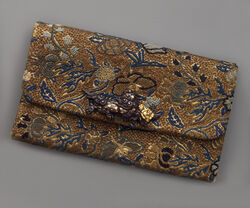
Ce sac à tabac en brocart du Japon est une magnifique pièce d'artisanat. Le brocart est un tissu dont les fils métalliques sont tissés. Dans le cas présent, il s'agit de fils de trame dorés qui confèrent à l'arrière-plan du motif un magnifique reflet. Le motif lui-même, exécuté en laine dans des couleurs automnales sourdes, représente des branches de feuilles avec des fleurs qui couvrent uniformément l'ensemble de l'objet. Pour conserver la fraîcheur du tabac, l'intérieur du sac à tabac est doublé de cuir. La plaque de serrure, qui au Japon est toujours fabriquée en plusieurs métaux, est un deuxième facteur de prestige de ce sac à tabac. Ici, la serrure est un lion de cuivre bruni avec une fleur dorée et quelques touches d'or supplémentaires. L'incrustation d'or constitue une belle répétition des fils d'or du tissu. Nous ne connaissons guère de sacs à tabac de ce type dans d'autres cultures. Au Japon, ils ont été couramment utilisés pendant plus d'un siècle, en tant qu'ustensile, mais surtout en tant qu'accessoire de mode luxueux pour les kimonos. Suspendus à la ceinture avec le porte-pipe en guise de contrepoids, ils étaient l'objet de statut par excellence.
Amsterdam Pipe Museum APM 23.965
PermalinkTsuge with gold windshield
juin 2020
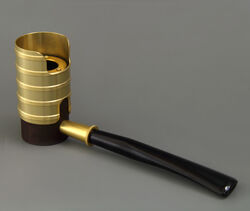
The earliest products from Tsuge pipe factory in Tokyo include ivory cigarette holders and even ivory tobacco pipes. The deluxe versions were given a decoration in colorful lacquer. After 1950, the images of smoking Westerners also sparked interest in European-style tobacco pipes in Japan. Tsuge then makes the top segment of briar pipes completely by hand. In the twenty-first century, the Tsuge factory took the lead in modern design. Optimal smoking comfort is always the starting point, a characteristic for the pipe shown here. The contemporary design labeled Tsuge Thunderstorm was created between 2008 and 2010, in this case in gold finish. The cylindrical briar pipe bowl is equipped with an aluminum jacket that can be slid vertically up above the pipe bowl and thus functions as a windshield. The screen can rotate in all directions to avoid accelerating the fire in the bowl. The pipe is also practical because of its small size and very light weight. Following the international market, the stem can accommodate a 9 millimeter filter. The consumer price in Japan today is 20,000 yen. The Tsuge pipes are now also available on the European market, there the price is just over 200 euros.
Amsterdam Pipe Museum APM 23.933a
PermalinkBoileau in mean colours
mai 2020
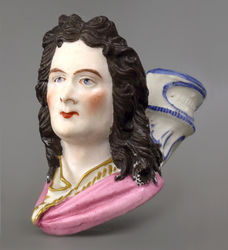
Certain pipe designs are highly valued by their expressive portrayal and monumentality. This applies, for example, to the portrait pipe known as Boileau, which the French company Gambier designed somewhere before the year 1840. With its sympathetic historical appearance and exciting, slightly sideways looking head, this is a successful creation that has been in circulation for generations. It is not surprising that other factories are trying to profit from such a successful design. A German porcelain maker copied the original design of Boileau without any change, but in a different raw material. Using the mysterious Parian ware, the maker tries to do justice to the sculptural aspect of the pipe. The fine marble-like porcelain is extremely suitable for imitating scuptures and busts. Unfortunately, the manufacturer has not thought that a tobacco pipe has, in addition to the aesthetic side, the user aspect. Every smoker can imagine that porcelain can never succeed because the material does not absorb moisture so that the pipe smokes hot. In addition, the product is single-walled, creating unexpected parts in the bowl where the tobacco does not burn. A remarkable feature of this pipe is the finish in a multi-coloured painting. The artificial plum mouth and the blushes on the poet's cheeks make the poet effemanate rather than toughThe wonderful black wig shows an unexpected and, above all, misunderstood ornament on the back of the head.
Amsterdam Pipe Museum APM 23.923
PermalinkWalrus tooth for a tobacco pipe
avril 2020
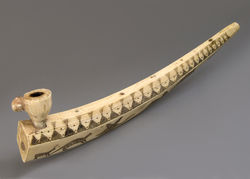
The West Inuit are the makers of this unusual tobacco pipe, cut from the tooth of a walrus. The choice of materials in the inhospitable area of Alaska is scarce and limited to dental and bone material. Characteristics of such pipes are the angular shape in the section of the pipe stem and the loose pipe bowl mounted on the top. For the Inuit, however, it did not stop with simple, unadorned products. They soon discover that they could offer their handicrafts as souvenirs to European whalers and gold diggers in the Bering street. Especially for that target group, the pipes are decorated with incised and coloured representations that do well with tourists. Especially the hunting scenes of this polar people with the local animals got popular. This pipe is a fine example with a reindeer, polar bear, walrus and birds, together with Indian wigwams. This pipe must have been made by the Inupiaq tribe in northern Alaska between 1890 and 1900. It found its way to England as a souvenir and was preserved as a memory piece in Bath, finally ending its travel in an Amsterdam museum collection.
Amsterdam Pipe Museum APM 23.893
PermalinkA press mould of a man with a turban
mars 2020
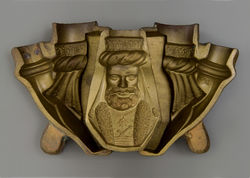
Press moulds for clay pipes are quite rare. Surprising on one hand, considering that thousands of them were in use in the nineteenth century. Yet it is also understandable, because the press mould was a means of production, so when there was no longer demand for a specific pipe design, the mould was simply melted down. The mould depicted here survived, being a rarity as an example of a multi-part figural press mould. The design shows the bust of the Moroccan sultan Abd-El-Rhaman in traditional North African costume. The design originates from the Gambier company in Givet where it is known as shape number 508. Pipe makers in the Belgian Meuse region imitated this popular pipe design. For example, before 1850 we find an image in the catalog of Wingender-Knoedgen from Chokier (shape 153). However, it did not stop there. This figural pipe was also supplied by Jean Jacques Knoedgen from Brée who assigned shape number 81. It is most special that the moulds from Knoedgen remained in the pipe making branch until the 1980s, including several transfers and were finally preserved for posterity. Given the still very good condition of the mould, the produced quantity of this pipe has not been very large. The mould is a wonderful proof of the highly skilled craftsmanship of the past.
Amsterdam Pipe Museum APM 23.717
PermalinkThe Igorot and their specific pipes
février 2020
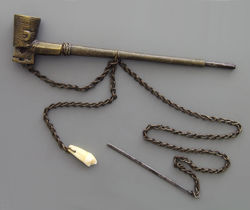
This tobacco pipe is an attractive ethnographic object from the Philippines. The northern islands of that country are home to six tribes, known under the collective name Igorot, that use different types of pipes. The most characteristic are the pipes made of brass with a small bowl and a straight stem. The upright bowl usually has a heel shape at the bottom, often with an eye to secure the separate stem with a chain to the pipe bowl. At this pipe nothing more than an eye was left of this heel. The lock chain often serves as a hanger for all kinds of curiosities as we see with this pipe. A wooden cleaning tool for the pipe is the first, with a cut edge. There are also two teeth mounted on ta ring, a reminder of successful hunting. The global pedigree of this item is special. In the 1970s this pipe was in the Ken Erickson collection in the United States. Benjamin Rapaport later published the pipe, falsely labeling it African. Eventually, in 2005 this object ended up in the famous collection of metal pipes of Felix van Tienhoven from Geldrop. With the bequest of his collection, handed over to our museum last year, the world trip of this tobacco pipe came to a final end.
Amsterdam Pipe Museum APM 23.545
PermalinkJapanese stage pipe
janvier 2020
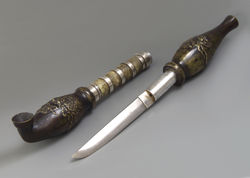
Coming from Japan this tobacco pipe or kiseru is special for multiple reasons. First the size, because the pipe differs from the refined conventional ones by being larger with more weight and a rather coarse decoration. You wonder if this pipe was made by a pipe maker. The shape of the pipe bowl with a heavy bowl wall is not characteristic for Japanese pipe makers at all. A unique feature of this object is that the stem slides open, revealing a dagger with a razor-sharp blade. The size in combination with this second function indicates that this pipe played a special role in the theater. Thanks to the large size, it is clearly visible from a distance, while the weapon function is a surprise that makes a big impression on stage. Notwithstanding its originality because of the size and the added function, if we look at the workmanship of this object, it is somewhat disappointing. Where the Japanese kiseru is characterized by refinement and subtlety, made with great craftsmanship, this pipe is, as noted, coarse and shapeless in design, while the decoration on the pipe is rather unclear. These characterize the fact that it is not a pipe maker, but a gunsmith who was unaware of the refinement of the kiseru. The fact that he was an expert in forging stabbing weapons explains the fabulous metal of the knife, for which the gunsmith may be applauded.
Amsterdam Pipe Museum APM 23.467
PermalinkA bird on the pipe bowl
décembre 2019
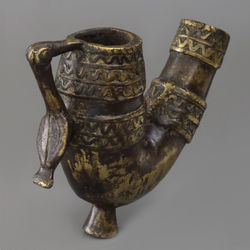
In the twentieth century, the Dogon tribe from Mali is known for their tobacco pipes made of cast brass. Why this tribe exchanged their traditional pottery pipes rather abruptly for those in brass is not clear. The pipe bowl shown here is a representative example of this new fashion. The object is made in the so-called cire perdue technique where a wax model was first formed. This wax model was packed in clay and heated. While the clay hardened, the wax melted and the empty gap was then filled with liquid brass. This specimen has an oval bowl shape and is provided with a heel, the stem rises and ends without a cuff. A simple decoration of zigzag lines has been applied around the bowl and stem to alternate with the smooth surface. What makes this pipe so attractive is that very playfully a stylized bird has settled on the pipe bowl with the beak on the edge of the bowl opening. Animal figures are more often depicted in pipes by the Dogon, although this attractive example witnesses beautiful, subtle modeling. The brass tradition lasts throughout the twentieth century, but the execution gradually becomes less detailed and therefore less attractive.
Amsterdam Pipe Museum APM 23.388
PermalinkEngraved gooseneck pipe
novembre 2019
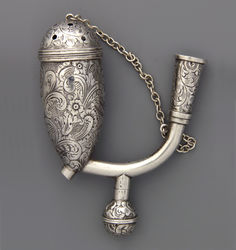
This silver pipe bowl is designated by collectors as goose neck. These have been particularly popular in the first thirty years of the nineteenth century, of course among the more wealthy pipe smokers. Only the upper layer of societie could afford to smoke out of a pipe made in silver, thus underlining its own status. This silver pipe is particularly precious because of its beautiful, accurate engraving that has been applied to the pipe bowl and stem. Over the entire surface is convered with a pattern of curled foliage, surrounded by c-volutes like whiteheaded waves; not only the pipe bowl but also the moisture trap and the stem are decorated in the same way. Such pipes were mounted with an upright wooden stem with a curved end piece of buffalo horn or amber. In an exceptional case, the stem was also made in silver. Because silver pipes give the smoker a hot smoke, the pipe bowl was covered on the inside with meerschaum paste or a pipe bowl of pipe clay was mounted in silver. This material cared for the absorption of moisture, the remaining moisture was entrained with the smoke, condensed in the stem and finally collected in the convex moisture reservoir at the bottom of the pipe. After smoking it could be unscrewed to drip out. A dome-shaped lid with perforations completes the silhouette of this posh tobacco pipe.
Amsterdam Pipe Museum APM 23.086
PermalinkUncle Paul cast in caoutchouc
octobre 2019
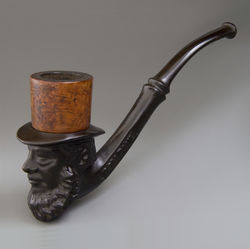
South African President Kruger, better known as Uncle Paul, was extremely popular not only in his own country, but also in Europe. As the fifth president of the South African Republic, he traveled through Europe to seek support for the problems in his home country, Transvaal. With his international reputation he was kindly received by, among others, Queen Wilhelmina. It is therefore not surprising that several tobacco pipes are dedicated to him. The present portrait pipe has the most modern looks of the series. Tobacco pipe figuration was no longer in fashion around 1900 and the emphasis shifted from the clay pipe to products made from alternative materials. This pipe is a good example of this new style. It is made of hard rubber or caoutchouc, a modern material that can be moulded. Because hard rubber is flammable, such pipes were fitted with a wooden or meerschaum pipe bowl. With this design, the characteristic Kruger top hat was turned into a pipe bowl, the hollow space underneath serves to precipitate tobacco moisture and also stimulates the cooling of the smoke. Modeling was an issue for the hard rubber manufacturer. That is clearly reflected in the somewhat schematic design, but because of his characteristic ring beard and top hat, Kruger is sufficiently recognizable. In addition, to avoid confusion, the inscription “OOM PAUL” was applied to the stem.
Amsterdam Pipe Museum APM 22.979
PermalinkSerene Etruscan female head
septembre 2019
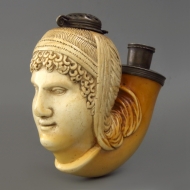
In the nineteenth century, portraits of people in Etruscan style have been popular for a short time. New archaeological discoveries in Italy were the inspiration for this vogue. This pipe bowl ties in with that fashion quirk from the second quarter of the nineteenth century. It is a large bowl with a height of more than ten centimeters that shows a serene Etruscan lady in historical dress. Characteristic is her slightly archaic smile along with her hairstyle with short curls around the face up to the hair band. The rest of the hairdo is corrugated and largely covered with a draped headscarf that hangs very elegantly on the stem. The lightly flattened overall shape is characteristic of the time of creation: when viewed from the side, the pipe is completely natural, but turned to the front the image appears almost two-dimensional. The preference for that flattened shape was left over from the Empire Style. A silver mounting with a dome-shaped hinged cover on the pipe bowl and a cuff ring with stem attachment emphasize the luxury of this tobacco pipe. Smoking has resulted in a beautiful colour gradient from ivory white to ocher yellow.
Amsterdam Pipe Museum APM 22.971
PermalinkAntler pipe with religious carving
août 2019
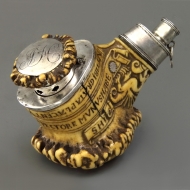
For the pipe smoker, the nineteenth century is the time of the imaginative, but equally monstrous creations. This pipe balances in between. It is made from a piece of stag horn that has a wonderful shape with its whimsical excesses. Unexpected natural materials were loved in the nineteenth century to turn into an original tobacco pipe. When antlers were used, it was mainly the gnarled crown pieces that give the end product a rustic look. We usually see hunting scenes on such pipes, all the more exceptional that the theme here is religious in nature, with textual predominance. In addition to the text bands, we see twice a somewhat unclearly designed griffin. As a surprise, a majestic portrait of Christ is depicted on the underside. Finally, the silver lid bears the gracefully engraved initials JH of the owner. He will have shown himself with pride with this pipe, as we can infer from the traces of smoke in the bowl. We can only guess about his connection with the depiction.
Amsterdam Pipe Museum APM 22.966
PermalinkCarved box for pipe tobacco
juillet 2019
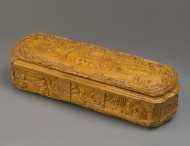
A magnificent piece of carving is visible in this German tobacco box. It is made entirely of wood, including the seven-part hinge, a true piece of technical craftsmanship. Within a frame of Louis XV motifs, the box displays an interesting scene with an encyclopedic background. On the lid we see a landscape with a stone mill building in the center with a water wheel. The cartouche on the top explains the function and gives the date 1780. Shown is an iron crushing plant where a heavy hammer is driven by hydropower. The front of the box is the further explanation of the lid, because there we see what happens behind the facade of the factory building in four stages. The bottom of the box shows the extraction of the iron ore, with a simple hoist high on a mountain, and next to it is a castle. The box refers to the iron production in the town of Gimborn on the Leppe river in what will later become Ruhr region. From the 14th century onwards, iron ore was mined on a small scale in North Rhine-Westphalia and melted with wood from local forests. Water mills were responsible for driving the bellows and crushing hammers. The scene with the full production run of the iron on this tobacco box is an exceptionally rare document about the pre-industrial history of Germany. It is quite conceivable that the tobacco box was made for Fürst Schwarzenberg, the lord of the Gimborn castle.
Amsterdam Pipe Museum PM 22.939
PermalinkHigh bowl from Big Ben
juin 2019
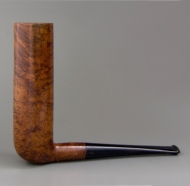
Every era shows extremes in design. They become the icons of that period, but are generally not the most common product due to their explicit design. Typical for the 1960s, for example, are striking tobacco pipes with an extraordinarily high bowl like the example shown here. With its strong cylindrical pipe bowl and relatively short straight stem these elements compete with each other, resulting in great tension in design. The birthplace of this unusual chimney shape is in Denmark. This specimen, however, is a copy, but a very good one, because here too the manufacturer sought the extreme. The design doesn’t go for the lean, thin line, but choose the sturdy massive. The name of the pipe is also appropriate: ‘High bowl’ which, together with the English brand name Big Ben, forms an perfect language unit; somewhat misleading, since the pipe is Dutch made. As noted, the extreme designs acquired an iconic value, although they rarely became bestsellers. Not surprising that half a century later this pipe has become an object of great rarity.
Amsterdam Pipe Museum APM 22.933
PermalinkChic snuff box
mai 2019
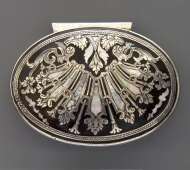
The craze of sniffing tobacco powder is a habit that has arisen from the desire for luxury and display, much more than smoking tobacco. It is not surprising that snuff taking involves valuable objects that were not in use by the pipe smoker. The snuff boxes are the most opulent examples of this vogue. This early snuff box from around 1720 is such a luxury item. It is a small oval, but still very flat silver box of which the largest size measures only eight centimeters. The origin is probably French, but English variants also occur. The silver hallmarks do not provide conclusive evidence for a maker. What makes this box so chic is the stylish inlay on the lid. A technique that is referred to in French as piqué posé, in England as hair-pique and in Dutch simply as Piqué werk. On the lid of this box we see a beautiful Louis XIV shell motif, with a solid plate of tortoise is engraved with a decor that has been filled in with silver and mother-of-pearl. To increase the fineness, the silver inlay has been embellished with engraving stitches. This created a impressive display full of contrasts. If you tapped the box lid a few times before taking a pinch - the fine powder could fall on the bottom - you had caught all the attention of the bystanders. Then one could only hope that others could not pull out a more posh box!
Amsterdam Pipe Museum APM 22.819
PermalinkFolk art figures
avril 2019
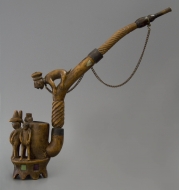
This month we present a wonderfully carved wooden pipe that bears witness to great craftsmanship, but at the same time it is also primitive and somewhat rough. The pipe bowl is supported by a weighted base with short legs, with around the base pieces of inlaid coloured glass. Particularly striking are the four stylized standing figures around the pipe bowl, all of which have the same posture. The faces are set with glass eyes, while they wear large hats that are carefully attached to their heads with a nail. The silhouette of the pipe is equally striking, with a slighty bending stem made up of different segments that slide into each other. At the center a monkey is hanging out of the stem, as the others with a headgear, in fact more like a barrister barret. A locking chain has been placed around his neck that extends to the mouthpiece with an intermediate ring. This mouthpiece is made of buffalo horn for durability. A little lower on that stem, four more pieces of inlay made of light and dark buffalo horn are arranged. We do not know who made such a product and what the meaning of the figures with those strange hats is. Certainly it is a French object from the nineteenth century, but unfortunately the maker and even the region are not to be determined. It is the amusing of the form and figures that makes this French folk object so intriguing.
Amsterdam Pipe Museum APM 22.790
PermalinkOpium box
mars 2019
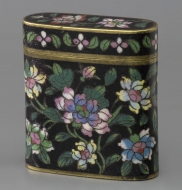
The precious and expensive opium was carefully preserved by the opium takers of the past. Designated boxes came into circulation that closed airtightly to keep the tar-like substance fresh. This is such a box intended to be carried in the pocket, hence the flat shape with the rounded outer corners. In order to be able to place the object stably during use, the bottom is kept flat, so is the lid for the right balance. The luxury of this object is in the finish. The outside is decorated with enamel cloisonné, a beloved Chinese method in which enamel is melted in compartments enclosed by miniscule edges of brass. After melting, the surface was smoothly polished and given a beautiful shine. Characteristic Chinese is decorating design showing branches with blossoming flowers on a black background. The result gives a rich colour contrast that has been applied on all sides. For practical use, the inside is also provided with enamel, in this case in solid blue. That enables easy cleaning. The dominant black colour can be associated with the popular famille noire porcelain, although that is not a logic comparison. With a date between 1880 and 1910 this box tes bears witness to the last flowering period of the opium paraphernalia, not much later the use of opium is definitively banned in China. Such boxes will be sold for a long time as a reminder of that typically Chinese way of smoking. If the demand persists, copies are made with a great resemblance to the original examples, but no longer for the purpose of opium taking.
Amsterdam Pipe Museum APM 22.788
PermalinkTobacco in a bag
février 2019
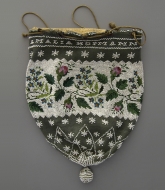
Tobacco storage shows an infinite number of fashion aspects. The greatest variation comes in the nineteenth century when traditional objects like brass boxes are alternated with new inventions. The tobacco bag is such a nouveauté, a flexible bag that is lined with suede on the inside to guarantee keeping the moisture of the contents. A drawstring acted as a closure. The outside could be embellished by using special fabrics, applying embroidery or beadwork. This tobacco bag belongs to the last category. In our hectic time, making beadwork is seen as the ultimate patience work and it is. Stringing the beads in different colours resulting in a regular pattern was a great challenge. A special technique was developed: bead knitting. With the help of four thin knitting needles you could make any pattern in colourful glass beads. Ultimately, machines were able to copy those patterns and became an unfair competitor of this noble handicraft. Along the border of this pouch we read "AMALIA HOFMANN AUS FREUNDSCHAFT", doubtlessly an inscription intended for a loved one. We do not know whether this item was actually made by hand in dedication, or delivered to order through the intervention of stringing machine. If you look at the wonderful regular work, it is hard to imagine that Amalia did this patience work without help. It is for certain that it is a typical German tobacco bag, as the German inscription shows. This bag would have been too large for a Dutch smoker, because the finely cut blond Virginia tobacco favoured by the Dutch would crush inthis wide bag. A tentative date would be between 1830 and 1860, a Biedermeier object in full bloom.
Amsterdam Pipe Museum APM 22.782
PermalinkSmoking figures
janvier 2019
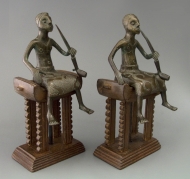
This beautiful pair of Fon bronzes from Benin shows smoking figures in a cheerful, casual design, sitting loosely and enjoying their tasteful long tobacco pipe. They are identical casts, but they differ from each other by the engraving of clothing. This pair is made for tourists, but originally the statues were placed in a shrine by the locals at home. Thanks to their serene equality, these statuettes brought the spirits of the ancestorsin a good mood. In this way the progress of the community was stimulated. This refined form of bronze casting is characteristic of the city of Abomey in Benin, the capital of the former kingdom of Dahomey. Depicted is the last king Gbéhanzin, who reigned from 1889 to 1894 and then be brutally knocked off the throne after which his country transformed into a French colony. King Gbéhanzin was an avid smoker and his images are known with pipes that in form refer both to the European clay pipe and to the coarser, long-stemmed local products. The dating of such souvenirs is between 1900 and 1920. Ironically, they were sold to the settlers who probably did not know that they took home in their luggage the portrait of the rejected king.
Amsterdam Pipe Museum APM 22.763
PermalinkPorcelain of famous origin
décembre 2018
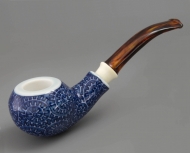
Porcelain from Arita has been famous for centuries for its refined shapes and especially the exclusive paintings. Yet from 1970 onwards this Japanese ceramic center did not go well economically. The hand-painted porcelain was too expensive for many customers, bulk goods prevailed. Manufacturers were therefore looking for new articles to increase the viability of their business, such as the tobacco pipe shown here. It is an innovative product that unites two cultures. The metal Japanese tobacco pipe or kiseru had almost disappeared in that period, making way for the European briar pipe. The Gen-e-mon faience studio designed this alternative tobacco pipe in the late 1970s, combining Arita's professional craftsmanship with the design of European briar pipes. What emerged is a beautifully balanced product in European proportions, but in a local material and with a locally conceived decor. Here, a delicate painting has been applied in a continuous pattern of toothed spirals that merge smoothly and that are extraordinarily professionally painted. The high quality of the porcelain is in harmony with the contemporary mounting with an acrylic mouthpiece. Downside of the pipe is the weight. Despite its hollow wall, the pipe is over 80 grams for a comfortable smoking pipe on the heavy side.
Amsterdam Pipe Museum APM 22.752
PermalinkPortrait of a black woman
novembre 2018
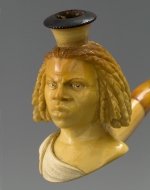
Popular as a subject for meerschaum pipes are portraits of exotics with their specific racial characteristics and special hairstyle or clothing. This cigar holder is a striking example of this vogue. What we see is a relatively small, extremely refined carved portrait pipe, showing the bust of a negro woman with the frizzy hair in strands. The bust is kept simple with a narrow pleat in the robe on one side. A slim trumpet-shaped cigar holder has been added for use, so that the fragile carving can never come into contact with the burning cigar butt. An extra attractive feature of this so detailed pipe is the treatment in so-called “double cire”: parts of the representation are finished with an impenetrable wax, so that they do not colour. The original white meerschaum colourcontrasts with the browning patina of the pipe, giving the eyes and clothing fold extra attention and thus livening up the depiction. The edge of the accompanying fitted case bears the mark of the well-known pipe sellers J.B. Vinche from Brussels. They were both manufacturers and importers, so it remains unclear whether the pipe is carved in Belgium or, for example, comes from Austria. The date of this small gem lies before the First World War.
Amsterdam Pipe Museum APM 22.703
PermalinkPortrait drawing
octobre 2018
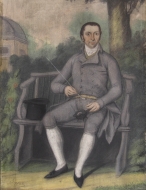
Rienk Jelgershuis was born in the Frisian town Leeuwarden, but lived and worked from different cities in the west of the Netherlands. He was primarily a portrait artist who did not operate from his studio, but traveled around. The accompanying chalk drawing was made on 10 August 1805 and is one of the many studies of a wealthy person. As so often, his work is frontal and in an appropriate setting. If the portrait were less successful, the environment was proof of the depicted sitter: a well-to-do man in front of his manor house. Interesting for us, of course, is that it is a pipe smoker, quietly placed on a double outdoor bench where he has lit a long Gouda pipe. He is holding a brazier in his left hand. Every single drawing in the remarkable oeuvre of Jelgershuis is consecutively numbered by himself. This chalk drawing bears number 7624 and dates from the last period of his life. Proof how active this itinerant artist has been. It would be a miracle if the inventory list of his artworks turned up one day. That would give us the opportunity to name all those stately depicted people. Until then, this smoker is anonymous, although the silhouette of the tea dome in the background may someday yield the name of the sitter.
Amsterdam Pipe Museum APM 22.680
PermalinkCarving example by Perron
septembre 2018
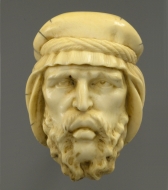
An absolute special find is this ivory sculpture in the shape of a massive pipe bowl. It is a design for a meerschaum portrait pipe and was made by Jean Perron. In the 1860s and 1870s Perron was a carver in meerschaum and ivory who was making walking stick buttons as well as pipe bowls. He gladly put his artistic qualities at the service of the then-growing Parisian meerschaum industry by designing beautiful pipes. After a light sketch on paper, he carved the figures into ivory as a perfect three-dimensional sculpture. These massive pieces of art were used in the Paris workshops as a example for the workers who copied them into meerschaum pipe bowls. This sculpture shows the portrait of an Arab with mustache and a beard in two inconspicuous points. He wears a headgear of sheet held in place by two cords. The rear of the object is smoothly ground and has a screw tap. A wooden stem was attached to it. The object must have been made between 1860 and 1875 and probably served a generation or perhaps even longer in the carving workshop of a pipe factory until it ended up as a curiosity at the pipe shop Au Caïd on the Paris Boulevard Saint Michel. It survived a century there before the historic importance was rediscovered.
Amsterdam Pipe Museum APM 22.655
PermalinkPorcelain hussar
août 2018
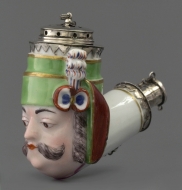
Early porcelain portrait pipes are a rare item. They were among the curiosities of the established porcelain factories and were never produced in a large quantities. This also applies to this bold portrait with a height of more than seven centimeters. Depicted is a soldier à la hussar. This indication evokes an atmosphere of fearless soldiers, although this chap looks quite harmless. The question is whether the smoker knew the hundreds of uniforms to see exactly which rank was shown. More important, however, is the political background, represented by a token of two circles on his hat with a raised panicle symbolizing the French kingdom. The painting of this pipe bowl was done in natural colours with the hat in green, the hanging flap showing the red lining. A scalloped purple border has been applied to the stem transition. The most successful colour, however, is the skin of the depicted hussar, which brings realism with its prefect shades of colour.. The pipe bowl still has the original mounting with silver ring around the edge, with a perfectly fitting lid without a hinge, that is secured by a a lock chain running to the cuff ring. The edges of the mounting on the bowl opening and at the stem end are zigzag, so that they can easily clamp. The pipe bowl was made around 1780 at the Royal Porcelain Factory in Copenhagen, although it is unclear whether it was sold on the local market or intended for the French smoker who undoubtedly liked the colors of the cockade.
Amsterdam Pipe Museum APM 22.652
PermalinkSpittoon
juillet 2018
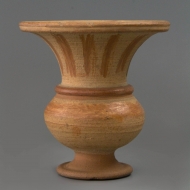
With a height of only eight centimeters, this spittoon is one of the miniatures. The object was not presented anywhere on the table or on the floor in front of the betel chewers, but was taken in the hand to spit in, in a way as civilized as possible. Hence the name hand spittoon. The silhouette of the object is similar to standard size spittoons, usually cast in brass. The broad flat neck was of course purely functional, the strength of the objects design was further in the volume of the convex belly and the ascending line of the foot. These balanced proportions are very well kept by the potter and give the object its beautiful shape. On the outside, this ceramic pendant of brass examples is decorated with red engobe in vertical stripes on the neck and in two horizontal rings on the shoulder. The origin of this object is known exactly, something that is an important addition to a museum object. Camille Eugène van Kappen, born 27 september 1856 in Batavia, later assistent-resident, donated this hand-spittoon to the forerunner of Delft Nusantara Museum in 1894 after his stay in the Dutch East Indies. Thanks to that gift, this fragile object was preserved for posterity, including the origin of Karawang in West-Java, also the production site. Because of that annotation, it is now the best documented spittoon in our collection.
Amsterdam Pipe Museum APM 22.613
PermalinkColourful opium damper
juin 2018
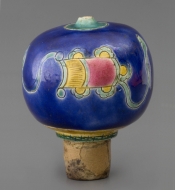
Every opium smoker knows that opium smoke tastes best in a bamboo pipe with a damper in Chinese stoneware. Yet there are countless variants in China, simply because it was cheaper to buy or nicer to look at. This opium pipe bowl is a good example of an aesthetically attractive object. It shows a spherical shape completely thrown from clay, the stem or socket in the same technique. The potter used a white-baking, soft and porous clay, more closely related to creamware than to pipe clay. A simple decoration was then carved into the leather-dry pipe bowl with smooth lines. In this case a circling ribbon with two symbolic objects. Subsequently, multi-colour glaze was applied whereby the ribbon with the gourd and the bamboo were coloured in pink, yellow and green glaze against a solid blue background. This gives a colourful result, technically better known as wu ts'ai or translated five-color glaze. Another interesting aspect about this opium bowl is that the origin is known. It was donated in 1892 to the Institution of Education in the Language, Land and Ethnology of the Dutch East Indies. This predominantly didactic collection was transferred in 1911 to the Ethnographic Museum Delft, the later Nusantara museum. With the closure of that museum, this special opium pipe bowl with its accompanying bamboo stem moved to our collection, where it forms a valuable addition as an atypical opium damper.
Amsterdam Pipe Museum APM 22.586bis
PermalinkHeil Hitler
mai 2018

The two beautiful wall cupboards of the Parisian collector Alain Demoly contained, in addition to an exquisite selection of clay pipes, a number of wonderful curiosities. That was the result of his broad interest in ceramic figural pipes. A pipe that always caught my attention was at the top of the left cupboard. It is a colourful portrait of a man with a striking lock of hair and a small mustache, doubtlessly the portrait of Adolf Hitler. The pipe was shaped in porcelain by a Parisian ceramist in 1974. Fully designed by hand and finished in natural colours, this is a creditable product. Unfortunately, we don’t know the intention of the maker, but the fact that the unlucky number "13" was pressed on the neckline indicates a negative connotation rather than adoration. Whatever the case, it remains a loaded subject, but this figure cannot be missed in a gallery of celebrities on the pipe. As Demoly stated, Stalin's portrait also had to be found for his collection. When his property went up for auction in Paris in 2016, this particular pipe was missing. The family found it inappropriate to go public with the sale of the Hitler pipe, especially at the time when terrorist attacks captivated the Parisians. So, the pipe remained off the auction. It was privately sold to our museum on special request, although it will remain in our storage for the time being.
Amsterdam Pipe Museum APM 22.558
PermalinkDying Zouave
avril 2018
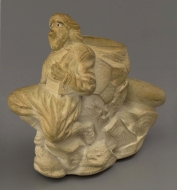
France has a long tradition with Algeria, although it has not always been a friendly one. From 1830 a special army unit fought in Algeria turn this country into a French colony. These infantrymen, so-called Zouaves, became known and not in the least because of their costume with well-known puff pants and close-fitting jackets with embroidery. The successes of this army unit also led to actions in the Ottoman Empire, the Papal States and even in the Civil War in the United States. These infantrymen even remained active during the French Second Empire. This pipe bowl shows such a Zouave sitting on a boulder while stabbing himself with a dagger in its chest. An action of suicide and therefore a bloody scene. The maker of this figure pipe is the northern French factory Louis Fiolet, which has been active since 1765 in the production of luxury clay pipes. Fiolet aimed to follow fashion closely and to always had an up-to-date range of pipes available for a broad target group. We do not know exactly when this item was designed. The Zouave army had different periods of popularity and continued to appeal to the smoker over a longer period of time. As far as the pipe is concerned: it has not been an easy smoker. The cubic representation is relatively heavy, which of course a daily smoking pipe should not be. The fact that the pipe never came into use, must be the reason that it survived the time. The traces of smoke that the pipe bowl carries, especially visible around the bowl opening, have nothing to do with pipe smoking. They were caused by years of exposure to clouds of tobacco smoke, perhaps even from cigars, while this pipe bowl was only flaunting and gradually discoloured.
Amsterdam Pipe Museum APM 22.524
PermalinkSimplicity and luxury
mars 2018
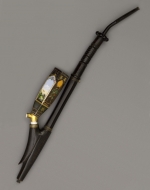
Porcelain pipes with paintings of church windows originate from the town Pirkenhammer in Bohemia, Germany, nowadays Czech Republic. They were conceived around 1830 and exploded into a craze that lasted for about 15 years. Such a pipe is depicted here with a six-sided flattened bowl of the usual, so-called stummel shape. Church windows are painted on the flat sides, transparent windows through which you can see a brightly coloured rural environment. These Gothic windows were often alternated with statues of knights executed in a dark palette, suggesting church sculptures. Alternating, both paintings give a nice rhythm of light and dark. What often happened with luxury goods is that their target group gradually declined. That is not surprising because the production in Pirkenhammer was so large that new customers had to be found all the time. For the smoker with the smaller purse, these luxury pipe bowls were mountedin a less luxurious manner, which considerably increased the clientele. This pipe is such a cheaper version. Although the pipe bowl is still completely hand-painted, the mounting is simpler to almost substandard. The moist trap below the bowl of the pipe looks like a blackened buffalo horn, but it is made of wood and finished with simple black paint. The rising stem has the usual quality, but the pipe bowl is never fitted with a hinged lid, another sign of simplicity. Despite of this appearance, this pipe will have had sufficient regard in the Biedermeier household, more a Sunday pipe than a daily smoker.
Amsterdam Pipe Museum APM 22.427
PermalinkSmoking from a wolf's head
février 2018
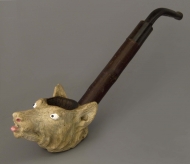
If you browse through the extensive catalog of the Gambier company in Givet, you will encounter in their wide range of designs only a limited number of curiosities. Gambier followed fixed design principles and few pipes deviate from that standard. One is Mère loup, a pipe bowl in the shape of a wolf's head with shape number 388. A striking feature of this design is that the pipe does not show any difference between the stem and the bowl, the entire pipe is the representation of a wolf's head. The separate wooden stem was pushed into the rear of the animal head to make it possible to smoke from this remarkable full sculpture. The neck cut is the bottom of the pipe bowl and is decorated with a beautifully shaped acanthus leaf. The question is how long such a design remained in circulation. With some creations, that is much longer than we expect. This wolf's head, for example, was designed before the year 1840. To our surprise it is still shown in the factory catalog in 1894. So, this design has been on sale for more than fifty years! Yet it is a pipe with limited popularity. All known copies come from the same press mould. We do, however, see that this mould has been updated once to sharpen the details. That would mean that only a few thousand copies were produced over a period of fifty years. It seems that production already stopped in the 1860s and that the remaining stock was sold out in the following decades. This hypothesis is strengthened by the fact that the "GAMBIER A PARIS" brand, which was standard on all pipes from 1865, is not present here. It shows us how important the phenomenon of a vast stock was for a pipe factory at the time. Thousands of boxes with leftover lots were waiting in the warehouse of Gambier until another order came for a single pipe. In this way the stock decreased gradually, albeit very slowly.
Amsterdam Pipe Museum APM 22.401b
PermalinkLumb of pipe bowls
janvier 2018
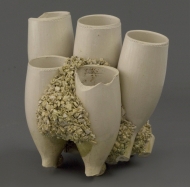
Gouda pipe makers developed an ingenious system for baking their clay tobacco pipes. The long unbaked pipes were placed in a high earthenware pot, a saggar with the bowls down. The pots were then filled with a grit of crushed pipes. That grit ensured uniform heat conduction and prevented the pipe stems from warping. The filled saggars are then delivered to a potter. This potter first placed the pipe pots on the kiln floor, after which he further filled the dome of the kiln with his own lead-glazed earthenware. When the kiln was fired, the glaze of the pottery melted and sometimes started to run and so it dripped onto the lids of the saggars. In rare cases this even leaked into the pot. The unintended result is this mess of glazed clay pipes that have been clogged together, including some crushed pipes. Such misfires naturally led to disputes between the potter and the pipe maker. Who was responsible for the damage? It is a miracle that this problem did not occur often. Such mis backed pipes are rare in Gouda as archaeological finds. The pipe bowls of this find still show the makers mark skater, at that time owned by Joris de Liefde. The production took place between 1760 and 1780. These misfired pipes were found in the Kandeelstreet in Gouda, a side street of the Raam. At the time, this was the pipe makers' center in Gouda with almost door-to-door workshops and a whole series of kilns for baking the clay pipes. Although it is not possible to determine in which kiln exactly this problem took place, this find is an demonstrative example of the potters’ practice.
Amsterdam Pipe Museum APM 22.375
PermalinkAn ingenious cigar case
décembre 2017
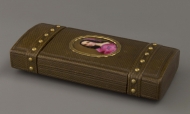
When the fashion of cigar smoking gets common in broad parts of the population, the flow of accessories will also increase. Cases in an infinite series are designed to serve as a gift item or as a practical utensil. This cigar case is quite a special one, as an elongated object made of papier-mâché. On the outside it is covered with brown paper that should give the impression of leather. This appearance matches the leather cases of the cigar pipes that were in use at the time. What makes this case chic is the porcelain plaque in metal frame on the front. It shows a hand-painted portrait of a beautiful Spanish woman in a seductive dress. She represents the ultimate beauty ideal from that period. The shape of this cigar case harks back to painted sheet metal cigar cases from the 1820s and 1830s made in Germany. This copy was clearly made a generation later. A special feature is the closing system whereby the two ends are pushed aside to open the central lid. Rather unexpected is the combination of the durable porcelain plaque and the delicate paper that is not resistant to tear and wear. To his disappointment, the owner would soon have discovered that. Fortunately this wear and tear passed by this cigar case, it stayed unused for more than a century to finally become a museum object.
Amsterdam Pipe Museum APM 22.366
PermalinkSouvenir from the First World War
novembre 2017
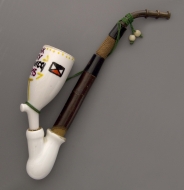
During the First World War there was sufficient time in the trenches to smoke a pipe. The personal tobacco pipe offered comfort to the soldier while smoking and was often a souvenir from home. From the English side, countless wooden soldier's pipes are now known. A rare example of a German soldiers’ pipe is discussed here. It is a practical pipe with an oval shaped porcelain bowl mounted in a moisture trap to collect the tobacco juice. Many rural people still smoked such pipes just beforethe First World War, although the object was certainly old-fashioned at the time. At the beginning of the nineteenth century, these porcelain pipes were painted extremely artfully, but a century later, that high-level craftsmanship is no longer as this pipe clearly shows. The pipe bowl shows a primitively painted inscription of a dilettant, made in a hurry just in time to to go to the font in the soldier's whip. With an overly thick brush, the bowl was labeled with an inscription dedicated to the Armee Korps XV that was stationed in 1914 in the Belgian town of Wervik. That regiment consisted of soldiers predominantly from Alsace and Lorraine. In October 1914 they occupied the tobacco town in preparation for poison gas attacks. The designation IR 126 on the pipe bowl stands for Infantry Regiment number 126 led by Grand Duke Friedrich von Baden. Wervik and the surrounding area sufferd a lot from the Germans, just as most of Flandres. This ugly pipe is a remarkable reminder of their presence. The question arises who was honored with such a misshapen product.
Amsterdam Pipe Museum APM 22.349
PermalinkA tribe with its own tobacco pipes
octobre 2017
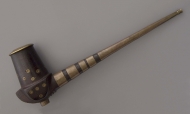
In Southeast Sudan in the upper Nile area live the Dinka, a population known as the tallest people in the world. The wooden tobacco pipes that they use were only created in the twentieth century. They are inspired by smoking pipes of the British missionaries who appeared with colonization. The pipes are lightweight and portable, understandable requirements for a nomadic people. Another characteristic is the occurrence of a heel shape under the pipe bowl. This indicates that manufacture must have started at the beginning of the twentieth century, since the heel on the pipe disappears during the First World War. Interesting is how the Dinka have adapted the pipe shape to their own taste and embellished it with geometric abstractions. The Dinka combine hardwood with brass, sometimes with shell inlaid. Initially European bullets or cartridge cases were used for this metal finery. We see brass bands around the stem, but also around the heel and the bowl. The combination of the characteristic hardwood with this sheet metal finery became a local fad in the second half of the 20th century. The fine contrast of the metallic sheet with the dark wood turns these pipes into a jewel for every smoker.
Amsterdam Pipe Museum APM 22.347
PermalinkCarefully repaired tobacco pipe
septembre 2017
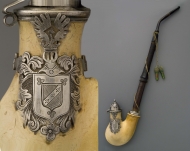
This meerschaum tobacco pipe has the shape of the popular pipes from the German town of Ulm, known under the name Ulmer Kloben. Characteristic is a cylindrical pipe bowl surrounded by an edge or spine that extends from the front of the bowl to the bottom of the stem at the cuff. Already conceived in the eighteenth century, this model remained popular until the end of the nineteenth century. The same wood shapes are also simulated in other materials, such as the example in meerschaum we present now. The silver hall mark stamped in the lid ring betrays the year in which this pipe came into existence: 1840. In that period, the heyday of the Ulmer pipe was just over, but production continued unabated. The owner of this pipe was Friedrich von Pelser Berensberg, who received the pipe at the age of 25 and kept it until his death. After he died in 1883, the heirs refurbished the pipe. Then a silver band was placed around the bowl with an engraving of the family crest and an inscription, which happened more than forty years after the manufacture of this pipe. The silver band was primarily used to camouflage a crack in the bowl, but also to turn it into a commemorative piece. At the same time, a new stem including a fresh locking cord was added. We don't know who the second generation smoker was, his son, grandson or other family member? The family crest certainly indicates that the pipe remained in use in the family. Most curious and unusual about this object is the fact that the pipe was passed on to a second generation, which occasion was recorded in silver engraving.
Amsterdam Pipe Museum APM 22.326
PermalinkUnopened for centuries
août 2017
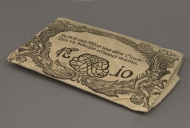
The term letter-tobacco refers to a specific package that has the form of a closed envelope. The type of tobacco was probably introduced as early as the seventeenth century and remained in circulation until the nineteenth century. Such a sealed envelope contained a small amount of tobacco for only a single tobacco pipe. It is clear that this is a fine and exclusive tobacco, if only in view of the large piece of paper compared to the small content. The luxury is also underlined by the attractively designed vignette printed on the front. At the center we see as a brand the mirror monogram of the supplier with an ingenious calligraphy of almost royal order. The number 10 refers to the highest quality. The German origin is evident from the inscription that says that this quality has been tested and appreciated in town and country, even overseas. The frame that surrounds the inscription fits tightly on the paper in its powerful design. Most appropriate as past of the decoration ar the tow pipe smokers in the lower corners, supported bya beautifully detailed acanthus along the bottom. The motifs on the upper half are less expressive. The clear rococo ornamentation indicates a date around 1750. At the rear, this package is closed with a drop of sealing wax on which the manufacturer stamped with his seal, again with a mirror monogram. There is no better proof of authenticity. That an object like this survived unopened for centuries can be called a miracle.
Amsterdam Pipe Museum APM 25.402
PermalinkA pipe case with a special inscription
juillet 2017
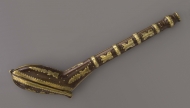
At first glance, this object does not look like a special pipe case. With its wooden core adorned with brass decorations, it is interchangeable for the countless pipe cases that were made almost industrially in the eighteenth century. Yet two things stand out. The first is its short length. The case measures 21 centimeters in total, which means that a standard clay pipe does not fit. Apparently this pipe case was intended for someone who would rather smoke pipes with shorter stems. In addition, the decoration on this object is particularly interesting because the engraving in Dutch on the edge along the flap shows an text dedicated to tobacco. Freely translated, it reads: "Tobacco comes from distant lands, let's burn it in a pipe, that's how we smoke like a hero, but who doesn't smoke is not in count". Unlike our present anti-smoking feeling, this rhyme fits in with the great popularity of smoking in the eighteenth century. The engraved date of 1783 leaves no doubt about the date. This year is consistent with the period in which such pipe cases were generally in circulation. The good condition of this object proves that this object has been a showcase rather than a daily utensil. Only when impression had to be made, it was worn in the pocket to light a pipe elsewhere. That appears not to have happened very often.
Amsterdam Pipe Museum APM 22.312
Strange pipe from the Aborigines
juin 2017

Little is known about the smoking habits of the native population of Australia, referred to as Aborigines. When smoking was introduced there and what their pipes looked like, are still unanswered questions. The specimen shown here is such a rare example of a local tobacco pipe. The pipe is made in mixed materials with a reed or bamboo plant as a stem. The bowl is made from a cartridge case, the narrowed section forms the bowl base, the pipe head itself is perfectly cylindrical. Brass is suitable as a material for a pipe bowl because burning out is impossible, on the other hand the bowl does get hot quickly which pevents a cool smoke. The pipe stem is painted in red, yellow and black in an attractive rhythm of concentric color bands. The dominant dark red color refers to the Cape York Peninsula region of Queensland. The special silhouette and the remarkable palette are in keeping with the sense of color of the local population there. It is hard to say what age this pipe can be. That this pipe also has a great similarity in shape with the Chinese opium pipe or its variants from the Indonesian archipelago must be purely coincidental.
Amsterdam Pipe Museum APM 22.289
PermalinkArt nouveau in porcelain
mai 2017
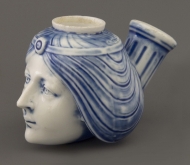
This porcelain portrait pipe represents an elegant female head with a special hairstyle that surrounds the head in a very charming way. A headband with a jewel on the forehead runs around the bowl opening. The stem has been fluted lengthwise. The pipe is made of liquid clay according to the hollow-walled principle, there is a space between the inner bowl and the outer shape where the smoke circulates and can leave moisture and tar substances. The s;ight porosity of the bowl wall in this space stimulates that function. Such designs were popular from the last years of the nineteenth century, especially in parian ware, the soft porous biscuit porcelain characterized by a matte appearance. However, this copy is made somewhat later date and from an ordinary hard porcelain. The white shard was washed with cobalt blue and then covered with a transparent glaze. In terms of modeling, this pipe appears to be from a later date, let’s say the years just after the First World War. You would expect the maker of such a relatively recent piece to be known, but unfortunately, there is no mark or any other reference.
Amsterdam Pipe Museum APM 22.275
PermalinkA trophy for a time smoker
avril 2017
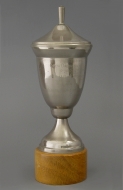
For the true connoisseur, smoking a pipe means rest, relaxation and time for contemplation. In addition, the phenomenon of competition smoking has been around for generations, which is in fact diametrically opposed to the comfort of pipe smoking. With four grams of tobacco in the bowl, the intention is to keep fire in the pipe for as long as possible. At official competitions, smoke observers even check whether the tobacco is still burning. The person with the longest hold is the winner. The competitive element of such meetings is underlined by the prize cups for the best smokers. Often provided with an engraved inscription of the place and date of the event, such as that of the Drenthe Championship in 1984. This trophy is the material proof that smoking in competition is a serious phenomenon. This example is one from the full prize cabinet of a smoker who has won at least a dozen. Because of the tradition of smoking competitions, that kind of memorabilia should not be missing in the collection of a pipe museum, no matter how ugly they are. Our genuine message about pipe smoking, on the other hand, remains that it is about enjoyment, that it should not have a competitive element and certainly should not be an addiction. And as far as the object itself is concerned: price cups are not characterized by beauty and craftsmanship as with the ancient Greeks. In the world of sports and other competitions, it's all about mass stamped metal cups on a simple wooden base. Their tinny appearance serves to keep the victory alive, but this stuff does not have any intrinsic value as is proved by the vanishing shine.
Amsterdam Pipe Museum APM 3.207d
PermalinkCigar holder in artful turning work
mars 2017
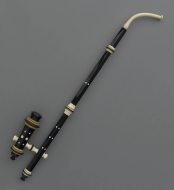
The cigar has been extremely popular since the mid-nineteenth century. That resulted in an enormous stream of new pipe designs to smoke the cigar stump. Meerschaum is the favorite material, not in the least because of the high absorption and the attractive colours after some time of use. Alternative products remain in the minority. They cannot compete with the positive properties of meerschaum. This cigar pipe ins oneof that category of alternative products. It is a rather unexpected example, both in terms of material and design. No natural raw materials were used at all for this pipe, as was customary in the nineteenth century, but plastic. This also points to a more recent date. In terms of shape, this cigar holder has been designed as a German so-called Gesteckpfeife, with a tall bowl that runs almost parallel to the long rising stem. The whole is composed of separate parts that are assembled into a pipe with screw taps. Main material is a beautiful glossy black plastic that is interspersed in two places with the same type of plastic in a light brown shade. In contrast parts in ivory are added, which further emphasizes the composition of the pipe out of several parts. The inlaid decoration on the pipe is in ivory as well. Everything indicates that it is not a serial product. Rather it is a piece of artful turning, made as a competition piece by an amateur craftsman or an object made at an arts and crafts course. Constructing a pipe from so many parts is time-consuming and therefore not commercially feasible. Moreover, it is mainly a curiosity than a practical utensil. The only downside of this product is the uneven placement of the dots on top of the stem that indicate a moment of carelessness during the noble handicraft.
Amsterdam Pipe Museum APM 22.224
PermalinkSquatting woman in nightgown
février 2017
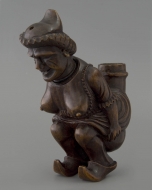
This striking wooden tobacco pipe represents a woman, crouched while she does her needs. The pipe shows a convincing carving and a slightly erotic or better scatological hue with a large discrepancy between the coarse woman with her tan features and her full breasts with fat teats dangling above a sloppy nightie. Striking details are the hat and the clogs that assume a local folk dress. To arrive at a full sculpture, the head of the depicted person has become very ingeniously the lid of the pipe bowl. All in all, this pipe has a bizarre appearance that looks more modern than historical. From a technical point of view, the product fits in with the wooden pipes from the German-speaking areas. Because soft wood was used, it had to be protected against burn-in. It was therefore common to coat the inside of the pipe bowl with sheet metal. Because that metal promoted condensation, a moisture trap was often made in the bowl bottom to get rid of the excess nicotine juice. This has happened in a very striking way with this pipe. The stop fits in with the figurative representation and makes the depiction even more banal. The woman does not produce an ordinary turd, but ironically pokes half a chicken or another animal. This bizarre characteristic is undoubtedly derived from a Central European folk tale or fairy tale in which scatology is part of the story. Unfortunately, we have not yet been able to find out the true history behind this remarkable depiction, but that the representation is meant ironically must be the case.
Amsterdam Pipe Museum APM 22.222
PermalinkTobacco jar by Tichelaar
janvier 2017
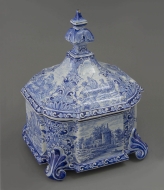
A century ago the Frisian people still had some preference for vainglory. This magnificent tobacco jar executed in Delft's palette, but made in Friesland, bears witness to this. This historicizing jar comes from the Tichelaar factory in Makkum, a Delft ware factory founded in 1699. The tobacco jar came about at a time when the traditional work, based on examples from times gone by, became popular with a growing group of gentlemen farmers and urban middle-class people. For this reason, Tichelaar kept the old craftsmanship alive with painter Jacobus ten Zweege junior as one of the most talented workers. Around 1900, Zweege supplied the most refined Delft style painting. The jar, a faithful copy of a silver Louis XIV jar, is decorated with rural scenes of a homestead, a shepherd, hunters and sheep in the field on the flat sides. The spaces in between are filled with beautiful ornamentation. The fine paintwork is Delft rather than Frisian in tradition, but the maker's mark with a TT monogram on the bottom of this pot clearly betrays the origin. This brand is not typically Frisian either, but is inspired by the factory brand of the famous Meissen Porzellan works. It is a wonderful and unexpected brand imitation that hardly had any interest for the Frisian consumer. After the First World War, this model of tobacco jar is still in production at Tichelaar, but the paintwork soon becomes coarser, while colour is added to the decoration. The Amsterdam Pipe Museum is enthusiastic about this jar because it represents the pinnacle of Frisian historicism in terms of shape and painting.
Amsterdam Pipe Museum APM 22.212
PermalinkMassim tobacco pipe
décembre 2016
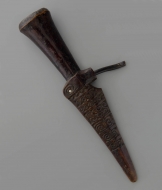
The area of the Sepik river in Papua New Guinea is the habitat of a people who are referred to as Massim. They are originally headhunters and cannibals, but nowadays those cruel habits have disappeared. Now they are mainly known as wood carvers, the largest objects they make are kept as shields, ancestral statues and masks in the men's house. Naturally, these large works of art also influence small art. This tobacco pipe is a fine example of the latter. With its funnel-shaped bowl and extension at the bottom, this shape is quite typical for the Massim. The silhouette has a pure dagger shape, the lower part of which shows the shape of the blade. This flat part is provided on both sides with geometric carvings in lines, with rows of s-motifs alternating with spirals. The pipe bowl itself is usually left unadorned, as is also this case. The separation of bowl and stem is marked with a modest, square cuff in which a short, hollowed-out twig is inserted as a stem. As a subtle ornament at the same height on the other side a stylized animal head is carved, the eye of which is accentuated with a white glass bead. After carving, the pipe is impregnated, sometimes also coloured with a red dye. During use, the object gradually loses its colour and becomes darker, until it has turned brown-black after years of smoking. In that condition, this pipe fell into disuse until it was sold as a collector's item. Only a generation later this fine pipe was added to our collection as an exotic item.
Amsterdam Pipe Museum APM 22.206
PermalinkUnexpected Polish freehand
novembre 2016
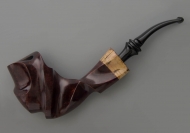
Even in the twenty-first century, the briar tobacco pipe can challenge the pipe makers. This is proven by, among other things, this design by the Polish maker Zbigniew Bednarczyk, to be precise from the place Przemysl. Starting from a traditional type of tobacco pipe, he created a new product characterized by unexpected geometric shapes. He got that result by swiveling around a thick-walled tobacco pipe, creating a completely new silhouette that makes the pipe different from every angle. To achieve an exciting contrast between tige and stem, a slightly tinted piece of driftwood was added as a fixation point between the dark red-stained pipe and the black acrylic mouthpiece. In the tige the pipe bears the ZIBI brand, as the pipe maker carries with the addition of freehand to indicate the style of the pipe. Zbigniew was clearly proud of his creation. Before the pipe was sold, various photos of it were placed in Polish magazines for pipe smokers. The fact that the pipe eventually ended up in a Dutch collection was mainly due to the pricing. This special creation was far too expensive for the average Polish pipe smoker.
Amsterdam Pipe Museum APM 22.200
PermalinkTobacco box in black lacquer with gold
octobre 2016
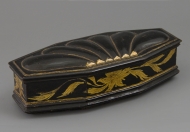
Oriental lacquerware was highly fashionable in the seventeenth and eighteenth centuries. Shiny objects with multiple layers of lacquer were typical status symbols for the rich, who wanted to impress their social circles. It is not surprising that this luxury imported from the Far-East was copied in Europe. This tobacco box is a great example of such a replica. The box has the shape of a traditional silver or brass box, but the material and finish are completely different. The material is oak, carved almost as thin as the metal example, including the curved lid that closes the box perfectly and almost airtightly. After the box was carved with much craftsmanship, it was finished with a black paint that strongly resembles the Japanese lacquer. An important difference, however, is the quality of the applied material that was made up of many layers lacquer in Japan. The European variant is only painted, in such thin layers thatit hardly obscures the grain structure of the underlying wood. A gold decoration was then applied over this black paint. Even the inside of the lid was provided with a fashionable representation. That gold decoration has characteristics of the rococo style, so that we can date the box in the third quarter of the eighteenth century. It is still a mystery where this article was made. Certainly a kind of industry has existed, because other wooden objects decorated in a similar way are known. We would nearly forget, that the attractive glossy surface with the playful gold decoration obscures the exceptionally clever method used by the woodworker to cut such a thin and lightweight object.
Amsterdam Pipe Museum APM 22.181
PermalinkPost-colonial representation
septembre 2016
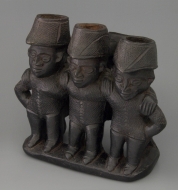
For the peoples of the Grasslands of Cameroon, the tobacco pipe is an important status item. In that area, the smoker carefully chooses his smoking instrument, that must be in accordance with the person's standing. But with the Graslanders, the tobacco pipe culture goes even further. Pottery makers are inspired to make showpieces, not meant to be used for smoking, but rather as a gift item for valued people. Such a pipe is shown here. The pipe has three members of European colonial forces standing next to each other, arms around each other's shoulders. It is not surprising that European soldiers are depicted. Cameroon was occupied territory from 1901, initially by the Germans, from the First World War by the French and English. These soldiers were often the subject of figured sculpted ceramics or bronze castings. It is a pity, of course, that we cannot see from the uniforms what soldiers are depicted. The local potters had no regard for that military status aspect. Finally, it should be mentioned that in Cameroon multi-headed pipes were intended for twins and triplets. Normally it is about functional pipes. But even this presentation pipe is usable because at the rear, the smoke tubes lead to one cuff, the traditional leak hole being provided at the base of the stem. It is almost unthinkable that this is a one-off piece, because the pipe is so perfectly constructed. However, a second copy of this remarkable show pipe is still unknown.
Amsterdam Pipe Museum APM 22.157
PermalinkA streetcar as a tobacco pipe
août 2016
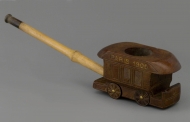
July 29, 1900 was a special day for the city of Paris. Then the first metro line was opened, designated by the Parisians as Métropolitain. This curious tobacco pipe in the shape of a train carriage was made on the occasion of the festive opening of this metro as part of the Universal Exhibition. Completely in line with the favorite nineteenth-century figural pipes, the pipe bowl has been modeled on a train set, including rotating wheels that are secured with brass tacks. Yet the designer did not copy the reality of that moment, but took the liberty of portraying the wagon as a nineteenth-century streetcar, horse-drawn tram or short horescar, including an open front and rear balcony. Even at the start of the underground, that construction would not have been possible. The inscription with golden letters on the top reminds the memorable opening with "METROPOLITAIN PARIS 1900". The mounting with a short bamboo stem ending in a buffalo horn bite as a reinforcement gives the pipe a sleek contemporary appearance. Although of a souvenir character, the pipe will have come from an established pipe factory. This is evidenced by the professional design and the smart finish. The town Saint-Claude is the most likely place of production, but a different origin is well possible.
Amsterdam Pipe Museum APM 22.152a
PermalinkAdvertising for Peterson's
juillet 2016
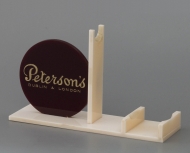
Articles to create product advertisements are often testimonies of the time in which they were created. This pipe stand is a proof of this statement. It is made in two colours of nylon that are glued together in strips to form a support. The object dates from the 1960s when minimalism was the trend: transparent, super simple in construction, the most modern materials and optimally functional. Apart from the fact that this standard supported the item to be sold, it also advertised the brand name on the circle shape that is part of the design. We read the word Peterson's and the importance of the Irish pipe factory is underlined by also mentioning the distribution office in London. Although a wonderful connection with time was found with this standard, it contrasts strongly with the traditional appearance of the Peterson's pipes of that moment. Since the end of the nineteenth century, the tobacco pipes of this company had not undergone any change so that their traditional appearance looked old-fashioned on this modern display. In the shop window traditional and modern came together in an unexpected way, a conscious choice made by the manufacturer. Don’t forget that after a few years the display standard was replaced by a newer one, but the appearance of the good old Peterson's pipe did not change to this day.
Amsterdam Pipe Museum APM 22.114
PermalinkSmoker's travel cassette
juin 2016
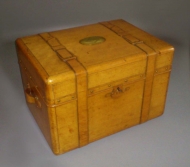
The spoiled person does not carry his luggage in a knapsack, but longs for forms of luxury that offer overview and practical use. This smokers' travel box proves that such solutions are not completely free of snobbery. With the shape of a twentieth century beauty case, the dedicated nineteenth century smoker was able to impress his friends. That game started with the appearance of the cassette. The outside of a lightly tinted type of wood has as surprise trompe l'oeuil belts with buckles that suggest supple leather, but are carved true to nature. The wooden handles on the sides also seem to be made of leather. After opening with a key, the inside is just as surprising. On a tray at the top we see a mosaic of four pipes surrounded by tubes for cigars and tobacco and two ashtrays. Typically a suitcase for someone who cannot or will not choose between smoking cigars or pipe. The balance seems to be decided here in favor of the cigar. When we take the inner tray out of the suitcase, a so-called cigar cellar, then called cave à cigares, appears with a square wooden tobacco jar at the front. The date is written in pencil in that tobacco jar and it quite unexpectedly mentions the year 1874, at least a quarter of a century earlier than we expect from its appearance. The case was made for the Antwerp architect Otto Geerling, his monogram appears on the lid, as well as on the cigar tubes in the box itself. The craftsmanship with which this object is made is simply breathtaking. For an architect, spun on form and proportion, this case must have been a feast for the eyes. Not only because of the perfect proportions, the ingenious layout, but also because of the great craftsmanship displayed. Nice to know that according to tradition, the chiboucq along the front edge was smoked when Vincent van Gogh visited the Geerling family in 1878. That fact adds the personal note to this exuberant luxury object.
Amsterdam Pipe Museum APM 22.111
PermalinkFolk art from Friesland
mai 2016
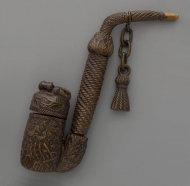
Nothing is more endearing than amateur workmanship, objects of hard work created during the evening hours. This tobacco pipe is a good example of this type of craft. It was carved by an industrious Frisian after a model of a luxury wooden pipe of German origin. Such so-called Gesteckpfeifen are made up by assembling parts of different materials. In this casethere are several parts, although it is only one type of wood. Our pipe has a cylindrical, so-called Hungarian bowl with an ascending stem. Everything about this object makes this tobacco pipe popular folk art. The over-decorated pipe bowl shows the symbols of life on farmland in light relief: the cattle, agricultural implements and above all the hard-working farmer's wife with yoke. These elements are arranged around the bowl, close together like a mosaic, without leaving a single millimeter of the surface unadorned. The relief on the lid is amusing: the farmer himself lying next to a loyal dog or is it his favorite cow? An example of true craftsmanship is the carved chain with strung wooden links out of one single piece of wood. The last link in brass with which the chain is attached to the stem proves that this did not work out completely. Very practical, the wooden tassel can also serve as a pipe stopper. The hinged lid also proves that making this pipe, fitted with a metal inner bowl to prevent burn-out, caused the maker the inevitable headaches. This lid can only be opened if the stem is first removed from the pipe. Not really practical. All in all, it is a sympathetic piece of carving that, given the minor traces of use, served primarily as a showpiece.
Amsterdam Pipe Museum APM 22.106
PermalinkTraditional Swedish tobacco pipe
avril 2016

Many countries or regions are characterized by the use of a specific type of pipe, typical in shape or material. The Gouda pipe is the best example for the Dutch smoking culture, the Stummel for the Bavarian. Such a characteristic local pipe is also known from Sweden, originating from Jämtland in central Sweden on the border with Norway.
These are simple tobacco pipes, named Jämtpipor after the region of manufacture. The base material used is sheet metal, which is cut into three pieces using a mallet. These three pieces are then soldered into a stem and a pipe bowl, completed with a hinged lid. The pipes are then finished by polishing the metal. The stems are made from reindeer bone and have a mouthpiece with knobs. Often the bone mouthpiece is much thicker than the metal of the stem and that gives the pipes a somewhat primitive, floppy appearance. The bowl size is usually smaller than a thimble. The pipe shape, by the way, has been copied from a type of clay pipe with a curved bowl imported from England, as they were in circulation in the eighteenth and especially nineteenth centuries. The metal counterpart, much smaller in size for easy transport, becomes the popular pipe for the working stand, both men and women. The men smoke from a pipe with a lid, while the women do not prefer that. The Jämt pipe is therefore a specific item that has been manufactured over a longer period, in an unchangeable technique. In short, a regional tradition that we find nowhere else in this form.
Amsterdam Pipe Museum APM 322b
PermalinkCigar holder with hunting scene
mars 2016
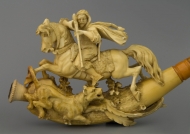
The second half of the nineteenth century is the heyday of the meerschaum cigar holder. As a result, colossal tobacco pipes disappear within a few years and these are interchanged for elegant holders in which the cigar can be smoked. The lavish cigar holder shown here is a wonderful example of a fashion that flourished for more than fifty years. A scene full of action has been created on a slightly curved horn-shaped stem. A lion hunter on horseback keeps a lioness or panther at gunpoint. The moment when the trigger is pulled is therefore the crucial moment of the hunt. The action is further enhanced by the waving Arabian clothing of the shooter. In the period of origin, wild stories circulated, in which those about Gérard le Tueur des Lions were the most heroic. The representation of this pipe must match the stories about that French hero. The smoker will definitely have made an impression with his fellow smokers with such a large-scale cigar holder. That this pipe is one of the more expensive, more artistic examples of fashion, is evidenced by the lifelike carving that has been artistically executed and worked out in detail. If you look closely at this object, you will see two other characteristics of the meerschaum pipe. Looking through the eyelashes, the original meerschaum chunck emerges from which this flamboyant pipe is cut and we see how the piece of raw meerschaum was used to the maximum. In addition, it is evident how ingeniously the carver has worked. Because of the robustness of this utensil, numerous connecting pieces had to remain between the parts of the scene. That happened in a totally natural way that makes it even unnoticed and proves the skill of the carver. The durability of this cigar holder has proven itself, the object has been smoked for a long time without damage occurring.
Amsterdam Pipe Museum APM 22.084
PermalinkPipe cleaner in a carved case
février 2016
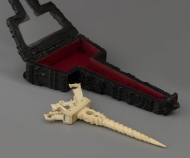
Characteristic for the Dutch northern provinces is this bone pipe cleaner. A typical piece of homework, made during the evening hours at the farm or by people in the city. The heyday of such cleaners is in the second half of the nineteenth century, although pipe cleaners in bone must have been used much earlier. The cleaner shown here is the most elaborate of its kind. The standard pin to clean the pipe is not different from the normal. However, the work that the maker has put in sculpting the top is special. On the top a toolbox is carved, with initials on the front. In that rectangular box, ten pieces of traditional Dutch carpenter's tools rotate around three axes. In this way the cleaner almost functions as a rattle when moving. What makes this item, rather a showpiece than a tool for use, truly unique is the accompanying wooden case. This is obviously a nice piece of homework as well. The case is decorated with carvings on all sides, even on the back. Two semi-circular pieces of brass have been fitted as suspension eyes for hanging this little show case. At the front you can see a hinged glass window that beautifully exhibits the pipe cleaner. After carving the entire wooden surface was covered with black lacquer, partially accentuated with gold. This created an unexpected showpiece. We can only guess about the background of this remarkable object. Was it a piece of work by a skilled carpenter who killed his evening hours? Or is it a gift from the family to a craftsman for some anniversary ? In any case, the initials indicate a specific person, that unfortunately we will never know by name.
Amsterdam Pipe Museum APM 22.078
PermalinkAn exotic pipe with a French stem
janvier 2016
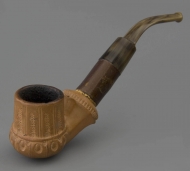
The nineteenth-century French pipe smoker was a great fan of exotic smoking equipment. In addition to the usual West European pipes in various shapes, he looked for products with an Eastern look, such as the pipe shown here. This is an Ottoman pipe whose design goes back to Turkish or North African examples. The basic shape consists of a cylindrical ten-sided bowl placed on a weighted base. On the outside the pipe bowl is decorated with geometric motifs with so-called ray eyes and stylized flowers above. Originally the bowl and stem were made on the turntable, glued together and stamped by hand. Production was more streamlined in the nineteenth century. Then these pipe bowls were pressed in a two-part mould after which the decoration was stamped. The maker's mark was also applied during the same finishing round, which, in addition to an Arabic text, gives the name "B. FUCHEZ CONSTANTINOPLE". Fuchez was a pipe trader who had pipes produced under license at various locations. Sales took place both in the Levant and in France and other European countries. The mounting with a contemporary cherry wood stem and buffalo horn mouthpiece means that this pipe was sold and smoked in the West. This happened at the end of the nineteenth century. In Turkey, such bowls were smoked with a much longer stem. After 1880 the West European smoker considered that as impractical and opted for the handy, short stem. The object is therefore a combination of the Eastern appearance with the Western smoking habit.
Amsterdam Pipe Museum APM 5.228
PermalinkSnuff rasp with bird
décembre 2015
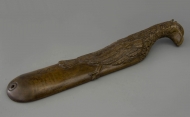
In the eighteenth century special habits were cultivated among snuff takers. Whoever wanted to use fresh snuff could best grate it himself. For that purpose pocket and hand rasps were in circulation that soon develop into rather exuberant luxury items. The rasp shown here consists of a wooden back in which a metal grater is fixed. The grater is no more than a thin metal blade with aligned rows of punched holes, both from the front as from the back. The burrs of the metal pulverize the snuff bread easily, while through the inward-looking holes the tobacco powder falls into the back of the object. At the bottom, the tobacco powder leaves the grater through a simple hole. Remarkable is the decoration of this grater, which shows a bird whose head and neck are in full relief and serve as a handle. The body of the bird is cut out on the flat base, here in a more modest relief. The lower part of the rasp back has been left smooth for the owner's monogram, engraved in swirling, typically eighteenth-century letters. When not in use, the grater can be hung by an eye in the head of the animal, creating the impression of being freshly shot. Thanks to this brass suspension eye, this grater survived its time hanging somewhere on the wall.
Amsterdam Pipe Museum APM 22.074
PermalinkA stone tomahawk
novembre 2015
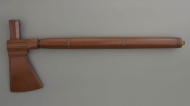
Among the Indian tribes of North America, the use of stone for the manufacture of pipe bowls is widespread. Most commonly used is what is called pipe stone or catlinite from southwestern Minnesota, characterized by a soft red colour. Traditional and best known is the ceremonial peace pipe or calumet made out of this type of stone. In addition to this peace pipe, there is the war variant or tomahawk. It is shaped like an ax with a pipe bowl on top, opposite the sharp side of the ax. The standard tomahawk is forged from iron or cast from brass and has a wooden stem pierced for the smoke tube. The pipe discussed here is an interesting and rare alternative: a tomahawk in shape, but executed in the catlinite typical for the peace pipe. Even the stem is made of the same stone. The pipe consists of two parts. The bowl part with a cylindrical pipe bowl at the top, the triangular ax shape at the base. This ax is faceted on the edges as if it was really meant for chopping. The stem, also made of solid stone, is decorated with a pair of bands with concentric rings. Bowl and handle are attached to each other with a piece of wood, at the end there is a wooden insert as a mouthpiece. This stone battle ax is absolutely unsuitable as a hatchet or throwing ax, which underlines its ceremonial function. It is even more likely that the pipe is made as a commodity, as a decorative pipe. This pipe must have been sold as a curiosity in the nineteenth century to a visitor to a native Indian tribe. Nevertheless, it has seriously served as a smoking pipe as evidenced by the considerable carbon deposition in the bowl of the pipe.
Amsterdam Pipe Museum APM 22.066
PermalinkSmoker in gold leaf
octobre 2015
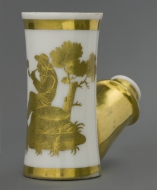
The quality of a porcelain tobacco pipe is mainly expressed in the painted decoration, having its heydays in the first half of the nineteenth century. The most beautiful hand painting is then produced in an enormous variety. In addition, sometimes special decorations arise that stand out in the usual paintwork. The pipe bowl shown here is such an example. There is no question of a polychrome painting, but the bowl has a decoration in pure gold leaf where two techniques are applied. The main image is in polished gold that was fixed with the help of mercury. After application, the minute details were drawn with an agate point. Although the picture is mainly recognizable by its contour, there are countless subtle nuances in the gold for those who look better, giving the figure optimum liveliness. In addition to the main motif there is a border and a stem with applied gilt. For this, gold amalgam was used that was also dissolved with mercury. This resulted in a contrasting, high-gloss gold, which, incidentally, is less durable. In addition to the gold decoration, the shape of this pipe bowl is extraordinay. Different from the usual oval-shaped stummel, we see a constricted cylindrical shape with a flat bottom and a short rising stem ending in a cuff. Thanks to a hollow-walled inner bowl, the moisture was able to collect at the bottom of the pipe so that the pipe smoked relatively dry. Another remarkable detail is that the silver stem mounting that was attached on the cuff in case it would had been a wooden pipe was taken over in porcelain, including the locking eye. An unusual but wonderful solution. The pipe shape is characteristic of the 1820s although this copy may be of a slightly later date.
Amsterdam Pipe Museum APM 2.885
PermalinkA pipe stopper with a shoe
septembre 2015
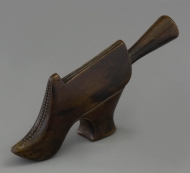
Pipe smoker's tools can be found in a wide variety of shapes, such as this original pipe stopper. Made of wood, it shows a stylized shoe with a conical stopper section on the heel side for pressing the tobacco into the pipe bowl. Pipe stoppers and pipe cleaners, the first to press the tobacco, the second to empty the pipe bowl, are often objects of popular art. Many examples were made as amateur handicraft in the evenings. Yet we we can easily be carried away in a too romantic feel about it. Looking more closely, we notice that, in addition to the genuine homework, many of those popular objects are in fact professional serial products, even if it remains 100% manual labor. The sophistication with which this shoe has been carved, with its special stylization and accents of stitching, certainly indicates that it is the work of a professional, who made use of his experience and repetition. He sold his craft through tobacconists or itinerant traders. Unfortunately, the origin remains unknown. Such stoppers with a conical stopper section are usually of English origin, but there is no certainty about that. The date must be somewhere before the middle of the nineteenth century.
Amsterdam Pipe Museum APM 22.052
PermalinkThe tabakobon
août 2015
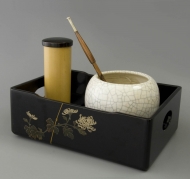
For the Japanese, pipe smoking involves almost as much ceremony as tea drinking. It is not surprising that the smoking utensils and the associated tobacco curiosa were made with great care. This tabakobon or smoking set is a good example of this extensive culture. In a rectangular box with lacquer decoration, various objects indispensable for the pipe smoker are brought together. Most notable is the ceramic stove with a solid white shard intended for the coal fire to light the pipe. This is equipped with white glaze that shows a beautiful gray crackle. The tobacco jar has a remarkable high shape and is made of white bamboo. It is closed with a blackened wooden lid and stands in a black holder so that it cannot fall over when moving the smoking set. We also get to know the status of this smoking set from the corresponding pipe. Copper and brass are combined in a technical perfect bond. Quite simple materials, even though the bamboo stem of the pipe is burnt in an attractive way that emphasizes luxury and tradition. All in all it is a representative piece, but not of the ultimate quality. The lacquer painting, for example, has characteristics of factory work and does not have the sophistication of the individual lacquer artist. The ceramic stove also has no signature as a sign of pride of a specific ceramist. The beautiful condition of the whole suggests that it is a recent object, but that is not the case. The object certainly dates from the Meji period or from before 1915 and therefore has an age of at least a century. It is the Japanese longing for prefection that keeps even a rather simple smoking set as this in perfect condition for such a long time.
Amsterdam Pipe Museum APM 22.049
PermalinkOrigami in a tobacco pipe
juillet 2015
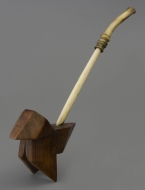
This elegant tobacco pipe is interesting for various reasons. Firstly, it is about the bowl that has the shape of a piece of Japanese paper folding. The name for that is origami. For a tobacco pipe, this design is quite remarkable and fits in with the European interest in Japanese culture in the years between 1880 and 1900. This briar wood pipe dates from that period and is therefore an early example of a briar pipe. Although an inconspicuous mark with the letters HFS is pressed in the wooden shank, it is still unknown where the pipe comes from. It is not so certain that this is a Saint-Claude product. In the early days of the briar industry there have been pipe factories in several other places that have achieved exceptional results. What makes the appearance of this pipe extra interesting is the mounting with a duck bone stem, which is so thin that the unusual elegance of the seemingly paper light pipe is emphasized once again. The mouthpiece of durable buffalo horn is attached to this bird's leg with a metal ring. Finally, the pedigree of the pipe is remarkable. The owner at the time was the well-known Amsterdam alderman Floor Wibaut. Incidentally, this was not a curio for Wibaut, but a real pipe for use. This can be deducted from the intensive traces of fire in the bowl, which has even become thin on one side due to frequent smoking. The special design certainly says something about the appearance of this alderman. After his death, his granddaughter inherited the pipe and cherished it all her life. When she passed away, the pipe entered the collection of the Amsterdam Pipe Museum.
Amsterdam Pipe Museum APM 22.045
PermalinkIvora pipe with dominoes
juin 2015
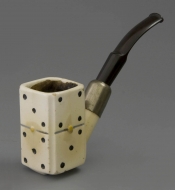
In the 1910s a flourishing production of slip cast pipes had started in Gouda, mainly under the leadership of Ivon van der Want. His factory located in the Kuipersteeg was generally considered as the oldest tobacco pipe factory, according to tradition dating from 1630. Nevertheless, Ivon did not want to associate his new production line of glazed pipes with the respectable factory history. He introduced the slip cast pipes to the market under the intriguing brand name Ivora. That name was primarily derived from his own first name, but for most people who didn’t know the director personally it also emphasized the beautiful ivory colour of the products. In the early years of the slip cast pipe that gave way to new design possibilities, numerous designs were launced to be taken from the market in short time. Apparantly they missed the connection with the customer because the Gouda factories had to discover experimentally what kind of pipe shapes the bourgeois class wanted. Many smokers felt too good for a simple clay pipe, but were not stylish enough to go for a real briar. In such case a slip cast pipe was a perfect alternative. The design shown here is such an attempt that was produced only shortly. It is therefore not surprising that this is the only known copy so far. The four-sided bowl shows four dominoes, the dots coloured with paint. It turned out that the smoker did not always understood the idea and saw two dice in it. The representation is certainly original, although the French company Fiolet introduced a similar pipe design to the market more than a generation earlier, but then as a moulded clay pipe. As noted, the domino pipe has only been produced for a short time, in contrast to the more simple dice version that remained in the range for more than ten years.
Amsterdam Pipe Museum APM 22.041
PermalinkGambier's Pasha
mai 2015
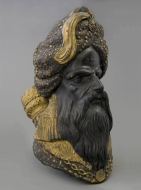
This shop window display pipe is a rarity, especially in this fine black finish. Originally, this large pipe bowl with a height of almost seventeen centimeters was marketed/offered as a giant-sized tobacco pipe. This happened before the year 1850, when the pipe was intended for the most dedicated Nicotinists. The motif of the Turk or Pasha has remained popular in the tobacco industry throughout the nineteenth century. The expression "He smokes like a Turk" still exists as an indication for a heavy smoker. Interestingly enough, this pipe bowl experienced a revival in the fourth quarter of the nineteenth century. Then it was moulded again as an advertising item or window display piece, even from the same press mould that had been preserved for half a century at the factory. As a result, the difference between the earliest copies and the later print run is not noticable, except for those who pay attention to minute details. In that later period it had become fashionable to bake pipes black, a technique also applied in this case. Smothered in the kiln, the white-baking clay turned deep black, sometimes even with a beautiful metallic luster. As if that wasn't enough, the product was finished in gold paint. In fact bronze paint has been used to give the pipe a more chic look and to enhance the expression. While the early specimens always bear a stamped maker's mark, this later product is strange enough not marked. Apparently that was no longer necessary. Around 1900, the Gambier company was the only pipe factory that was stillable to supply such a quality product. The other factories had run into financial difficulties and one after another had to close its doors. A detail not visible for the passangers of the shop window, nor on the photo is the beautiful Sater head surrounded by a grapevine at the bottom of the pipe bowl. That portrait completes the design.
Amsterdam Pipe Museum APM 22.014
PermalinkA traditional Touareg pipe
avril 2015
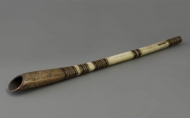
The Touareg nomad people from the Sahara are known for a specific type of tobacco pipes. For this people, which travels through the region on horseback, the smoking pipe must be small, lightweight and, above all, unbreakable. Their tobacco pipes are therefore made of metal and shaped as a so-called tubular, a pipe that has no clear separation between the bowl and the stem. Furthermore, a slight bending of the smoking instrument is characteristic, whereby the bowl emerges from the stem with a smooth line. Another characteristic is the beveled bowl opening, so that a kind of open container is created. Scarcity of tobacco made it possible to slide the often crumbly or crumbled tobacco into the pipe without spilling. Good for an economical user who doesn't want to waste anything. The craftsmanship of the pipe maker is clearly reflected in the pipe shown with contrasting metal colours interspersed with pieces of bone and wood. After the different materials have been applied around an iron core, the pipe is smoothed and then polished. Finally, the pipe maker provides some engraved zones. In total this creates a practical and yet elegant small pipe that is typical smoking instrument for the Touareg without comparison with pipes from any other region in the world.
Amsterdam Pipe Museum APM 22.012
PermalinkInfluences of Picasso
mars 2015
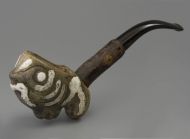
The French town Vallauris, not far from Cannes, is known for the peace temple created there by artist Pablo Picasso. Picasso worked there for years and encouraged other artists to visit. Not surprisingly, since the fifties, artisan ceramists came together here in the summer. Thanks to and under the guidance of their great inspirator Picasso, they made various types of painted pottery. And among these even some ceramic tobacco pipes. An example is this pipe made of slip cast clay by the artist Marcel Giraud. We know his name because he signed his products on the stem with Gem or Gema. Obviously in Picasso's style, Giraud created a figural pipe shaped like a fish, with the snout in relief on the front of the pipe bowl and the tail forming a sort of heel. Another characteristic is the painting in white enamel, which, after frequent smoking, contrasts beautifully with the dark-coloured background. Mounting with an cherry wood stem and a caoutchouc mouthpiece completes the object. As a sunny tourist town, Vallauris attracted many visitors during the summer who found a wide selection of handicraft items. This pipe was sold this way. Unlike the dishes by Picasso, these tobacco pipes do not yet represent a towering value. After all, in this case the artist is not world famous. Yet this pipe certainly radiates the ceramic intention of Picasso and is therefore an interesting phenomenon of its time.
Amsterdam Pipe Museum APM 22.010
PermalinkStummel with floral initial
février 2015
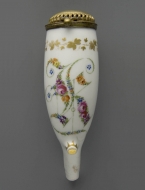
This pipe bowl is made in the famous Meissen porcelain factory. As a proof of origin two crossed sabers have been painted inside of the pipe bowl. Such an underglaze mark is an exception for porcelain pipes; most pipe bowls are unmarked. The front side of the bowl shows a hand-painted initial in multicolour, consisting of blooming flowers and leaves. To give the object extra cachet, a surrounding branch with gold leaf foliage is provided, while even the heel shows gold leaf. Decorated initials are of all times, although such letters experienced a renewed interest in the 1820s and 1830s. The pipe bowl in question dates from that time. For us, this painting looks sweet rather than masculine, but apparently the Biedermeier smoker had a different view. The painting of such an initial was done to order. It is a pity that we do not know whether it was the lover of the smoker who gave this order, but that would be most appropriate. Another characteristic of this item is the chic mounting, consisting of a gilded cast bronze hinged cover. A deepened circle with four oak leaves ornates the center of the top.
Amsterdam Pipe Museum APM 21.996
PermalinkSmoking with the king
janvier 2015
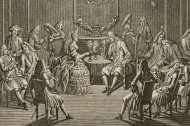
The most famous smoking society is undoubtedly the one founded by King Frederick I of Prussia. The reason is that his collegium was immortalized in a painting by Paul Carl Leygebe, a large canvas of 130 by over 160 centimeters that is now housed in the Neues Palast in Potsdam. The painting shows how the collegium functioned. The king and his wife are seated at a table in the center of the room. They are depicted at the moment that the king gets a fire for his long clay pipe from his consort. Their guests, all with a pipe, form a circle around them, but of course at an appropriate distance. Servants walk aroundin order to help lighting the pipe or pouring a drink, such as the man in Moorish dress. As a whole it looks relaxed and entertaining. This print in small size is inspired by the aforementioned painting. It was published in the Berliner Almanach of 1822, more than a century after the painting was made. A century later than Frederik, the tobacco collegium was still a common name for a smokers club. It should be noted that the print does not show the entire painting, but only the main scene. It is clear that engraver Bretzing was not one of the best. If you look at the faces of the guests you will see that the representation of the people could have been somewhat more powerful.
Amsterdam Pipe Museum APM 21.974
PermalinkFarmers hanging pipe
décembre 2014
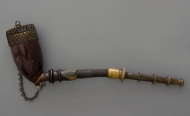
The peasantry uses a more luxurious pipe for the Sunday than during the week. From 1850 onwards, pipes with a porcelain pipe bowl were often put in a moist trap and attached to a long ascending stem. However, those of lower status or with less time to relax when smoking could purchase a hanging pipe as an alternative. In that case the bowl is standing as well, but with a short stem part that is more perpendicular and is mounted on a short mouthpiece of buffalo horn, sometimes even provided with a flexible piece, the so-called slap. To prevent burning holes in the clothing, these pipes were covered with a braided iron wire pipe cap or spark catcher, secured with a ring around the stem. Such a farmer's pipe is depicted here, finished in a solid dark brown glaze, not quite typical for porcelain. These pipes were used by thousands in the Dutch countryside, but the majority got broken one day so that relatively few of these are preserved. They represent a fine example of semi-luxury smoking utensils used in a specific environment that was almost never preserved because it was too common to bother.
Amsterdam Pipe Museum APM 21.960
PermalinkClay pipe with gold leaf
novembre 2014
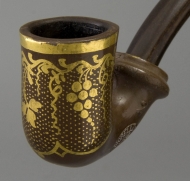
In the eighties of the nineteenth century, a technique was devised in Marseille to apply gold leaf decorations to clay pipes. The invention must be sought in the vicinity of the Morelli or perhaps Bonnaud factories. The pipe shown is a fine example of this technique. A gold leaf decoration that was quite durable was applied around the bowl. This was typically done with the brown pipe bowls, which were more luxurious than the red ones and had a finer surface structure, a requirement for a good adhesion of the gold leaf. In addition to geometric or floral patterns such as here, special inscriptions and advertisements were made in this technique. Cafés and beverage brands in particular have often made use of it. Their establishment or product was advertised with a name pipe. The mounting of such pipes consisted of a brown bamboo stem with a slight kink at the end, finished with a blackened wooden mouthpiece. If case of more luxury, the mouthpiece is buffalo horn and the stem is sometimes trimmed with a metal cuff.
Amsterdam Pipe Museum APM 21.952
PermalinkJapanese tobacco box with pipe holder
octobre 2014
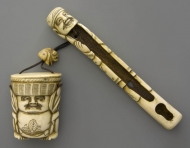
Two factors make that the Japanese smoking equipment is completely different from the Western European counterpart. The first is that the pipe, made of metal in Japan, has a very small bowl in which extremely finely cut tobacco is smoked just in a few puffs. Secondly, this smoking utensil is not stored in a pocket of the jacket or trouser, but hangs on the belt and for that purpose a special pipe holder and tobacco box are made, often with a clear show function. The item shown is a good example. It is made of carved bone and both the pipe holder, the kiseruzutsu, and the tobacco box, the tonkotsu, are shaped in human forms. The tobacco box shows in its low wide shape a short fat person with a basket on the head, closed by a flat clamping lid. This lid is held in place by a sliding bead or ojime that is also carved and has the shape of a sitting panda bear. With its long slender shape, the pipe holder shows a skinny figure dressed in a kind of kimono. In order to enhance the carving on both objects, the deepest parts are coloured with a black paint or ink. The two objects are carried on a black braided cord on the belt and served for the packaging and transport of cut tobacco and tobacco pipe, not hidden away but displayed ostentatiously.
Amsterdam Pipe Museum APM 21.955
PermalinkColumbus on the pipe
septembre 2014
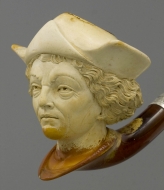
Portrait pipes of existing people in meerschaum are extremely popular among collectors. They prove the craftsmanship of the meerschaum carver whose task is to grasp the realistic features of a person. It was quite a task for the carver to come to a true-to-life resemblance, in contrast to the production of fantasy figures where facial expressions didn't matter so much. This portrait of Christopher Columbus is a fine example of a successful portrait, carved with the help of a history print, but cleverly three-dimensional. It is not surprising that Columbus was immortalized in a pipe, his role in introducing tobacco into the Old World has been essential. The mounting with an amber mouthpiece was common at the time. Later, when the amber got broken at the point of attachment, this stem got a silver band. That strap is provided with fine engraving and emphasizes that even during the time of repair the pipe was still seen as a luxury item.
Amsterdam Pipe Museum APM 21.940
PermalinkUnusual cigar holder
août 2014
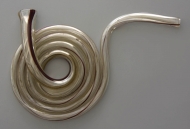
Although from the first introduction of the cigar in the late eighteenth century, all kinds of cigar holders were made, it was only after 1850 that there was a real boom in cigar pipes. Not surprisingly, during that period the habit of smoking a cigar becomes more common and a much larger group of smokers is looking for cigar pipes to flaunt to your guests. The glass cigar holder shown here is one of those curiosities that is certainly not intended for everyday use, but which is particularly suitable as a gift to the cigar smoker. The stem of this transparent glass pipe is wound in a spiral shape, the bowl for holding the cigar protrudes slightly from the silhouette, while the mouthpiece is bent at right angles and does not even have a button-shaped mouthpiece at the end. The glass is not completely transparent, the glass blower has subtly blown a slightly rotating dark red line into the spiral. In use, this pipe gives an unexpected effect. The cigars of the heavier Havana tobacco contain more tar and nicotine, and after just one smoking it sticks against the inner wall of the pipe, which quickly changes colour from tan to deep dark brown. Thanks to the precipitation of a considerable amount of moisture against the inside of the pipe, the cigar smoke does get a dry and therefore pleasant taste.
Amsterdam Pipe Museum APM 21.941
PermalinkRoyal coat of arms
juillet 2014
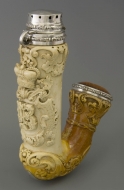
In the nineteenth century it was bon-ton to smoke a pipe with your own family crest or monogram, carved on special request. This pipe bowl with a high Hungarian shape is a fine example. At the center of the bowl is the crowned royal initial, surrounded by a circular form with leafwork, the back of the bowl is left unadorned. Actually, there is an ordinary ornamental decoration around the top, bottom and stem-end, but the way it is executed bears witness to a good sense of ornamentation, or in other words, it is clearly the work of a top class carver. This tobacco pipe was made for Fürst Fugger von Babenhausen from Augsburg and is executed in the then-beloved neo style. A silver rim has been nailed along the underside to protect the pipe bowl against scratches or other damage when standing in a rack. On the cuff, the manufacturer has pressed the letter N as a maker's mark so that we know that it comes from the company of Noltze, a famous meerschaum maker. As usual, the pipe bowl is finished with a drum-shaped silver lid and a matching cuff ring with a locking eye. This mounting demonstrates again understated luxury.
Amsterdam Pipe Museum APM 21.939
PermalinkStylized head of a beaver
juin 2014
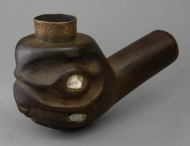
Tlingit, an Eskimo tribe with its own culture, lives in British Columbia, high on the west coast of Canada. Like so many peoples they are fanatic smokers and not surprisingly they have given their pipes their own characteristics. Wood is generally used as raw material, cedar wood being the most common. Because this type of wood is flammable, their pipes are provided with a metal inner bowl. Sometimes this bowl is made of brass or copper, in other cases iron from, for example, gun barrels is reused. The woodwork is decorated with traditional carving, of which this pipe gives an example. In terms of style, the depiction looks a lot like the more southern Haida, but the technology is unmistakably Tlingit. Around the pipe bowl is the stylized head of a beaver with details accentuated with pieces of mother-of-pearl. Some museums in Canada have fantastic Tlingit pipes from the first half of the nineteenth century. These objects are primarily sculptures, in which the pipe bowl has been given a place and where a hole gave the opportunity to attach a stem to the pipe. Our relatively late piece is based on a more standard pipe with a streamlined shape that is comfortable to hold. For this reason, this pipe cannot be compared with those early pieces. Yet this sculptural expression is a formidable example in its own right of the different styles and decorations that can occur in the world of tobacco pipes.
Amsterdam Pipe Museum APM 21.930
PermalinkSilver plated pipe decoration
mai 2014
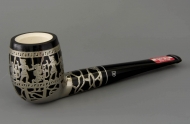
In the 1960s, a wonderfully decorated pipe was launched in America. We are talking about the "MEDICO STERLING", which has a silver-plated decoration on the bowl. The copy depicted here shows Scytian warriors on the frieze running around, edged along the borders with a sort of meander cornice. The mounting of these pipes was done with a nylon stem that was considered a nouveauté in those years. In short, with its silver decoration and modern stem an innovative product with which the smoker could impress. The most important seller was Sam Frank, who at that time controlled a considerable part of the pipe market with shop sales and in addition catalogs through mailings. The decorations were made by a Plating Company based on Broadway in Manhattan. The process was invented by a certain Joe Marco. The technique went as follows. The decoration was applied to a briar pipe with a screen print. The non-covered parts were then covered with asphalt, after which a silver paint dissolved in acetone was sprayed onto the pipe, which adheres to the non-asphalted parts. The asphalt was then melted and the pipe with the decoration kept in an electroplating bath for about four hours. These pipes were a resounding success on the market, but, as is often the case with novelties, interest quickly disappeared. Manufacturing started in the early 1960s, sales declined in the 1970s and when the silver price subsequently rose, production stopped definitively.
Amsterdam Pipe Museum APM 21.926
PermalinkBalancing with pipes
avril 2014
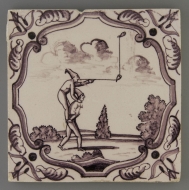
The fragility of the clay pipe made circus artists of the eighteenth century perform by doing tricks with the long Gouda pipe. This balancing with pipes is shown on this wall tile. The eighteenth century Rotterdam Magito family had a patent on these shows, they were famous as cord dancers who juggled pipes. Of course, the Magito family did not have sole rights. In other places, circus artists also qualified to amaze the public with their balancing skills. What is special is that such a forgotten trick has been recorded on this wall tile. In this case, it is not surprising that the tile shows the Magito family. The tile baker was in fact a Rotterdammer and therefore made a picture that was not entirely free of chauvinism. It is quite understandable that the clay pipe act has since disappeared from the circus. Since the beginning of the twentieth century, clay pipes have become expensive and by consequence unaffordable to train with these fragile objects. In this way a unusual piece of folklore disappeared.
Amsterdam Pipe Museum APM 21.911
PermalinkPipe case of unexpected material
mars 2014
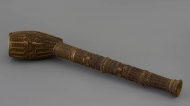
For the smoker the tobacco pipe is a precious instrument, especially a well-smoked pipe because it guarantees tasteful smoking. Not surprisingly, the smoker handles his smoking equipment with care and purchases a box or case for it to move the pipe safely. Many of these luxury pipe cases have been handed down because they quickly became collectors' pieces due to their carving or unexpected material. That also applies to this pipe case, made from coquilla nut, a tropical nut. Characteristic of these nuts is that they are soft when they are found, but after a few days harden to a rock-hard material. Because a fresh nut can be cut well, it is suitable for the manufacture of all kinds of decorated objects. However, a pipe case is not obvious. The long stem can only be made when different pieces of nut are attached to each other. Well, apparently the people who worked with this material had a great skill and indeed succeeded in fitting separate stem pieces together with a screw thread. In this way an exclusive pipe case was created that attracted admiration of most users because the material, which was very similar to wood, was not known and was surprisingly smooth and heavy by the high specific gravity.
Amsterdam Pipe Museum APM 21.908
PermalinkInspiration from the Indians
février 2014
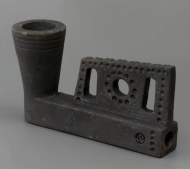
Every year there are people in the world who want to try their luck with making pipes. Such an example is the pipe in this image, made by Czech ceramist Bohuslav Husak around the year 2000. Husak calls his company Kurdejovska Keramika and for that reason he marks his products with a real pipe maker's mark of the KK monogram in circle. His range is quite diverse, but all products can be traced to examples from the literature about pipes that are available to him. For example, the pipe depicted here is derived from an antique American Indian pipe that he carefully copied. The funnel-shaped bowl contrasts beautifully with the square stem, the stem decoration of a geometric screen is characteristic of the Indians of the Chippewa. It is not surprising that Husak included the word kalumet in the naming of this pipe. Although his pipes are cast in a plaster mould, this pipe, originally made of natural stone, doesn’t seem casted. The edges of the design are so sharp that they appear to be cut out of stone. Thanks to reducing firing, an extra alienating character was obtained with an unexpected gray black.
Amsterdam Pipe Museum APM 21.832
PermalinkUnknown politician
janvier 2014
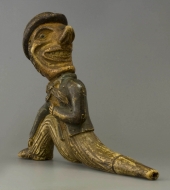
The pipe discussed here represents a reclining Janklaassen figure or Punch, facing to the left with the eye on the smoker. The depicted figure with hisupwardly curved nose wears a hat with an small brim and is dressed in a short jacket and striped pants. He holds up the right leg, the left forms the stem of the pipe and ends in a pointed mouthpiece. A wooden leg is suggested in this way. The product was made in a two-part press mould, the mould seams can still be seen along the outer edge. After baking, the pipe is covered with multicolour paint in blue, red, cream and black. Maker is James Wyse from Glasgow, who put such pipes on the market in the second quarter of the nineteenth century. Many of his portrayals have a relationship with the local politics of that time, although we can no longer understand the meaning. This also applies for this pipe. Wyse must have made a huge number of such pipes, otherwise there would not be copies left in collections nowadays.
Amsterdam Pipe Museum APM 21.774
PermalinkBust of the Empress Eugénie de Montijo
décembre 2013
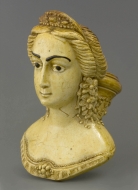
This pipe shows a somewhat primly but yet imperial portrait with naked shoulders and a conventional hairstyle. Depicted is Empress Eugénie de Montijo with hair put up in which a modest diadem, only the earrings with a flight of flower buds break the simplicity of the depiction. At the bottom, the manufacturer had the option of finishing the bust with something exuberant, but that didn't happen either. The base of the bust remains flat, with the modest contoured edge of her dress, which follows the shape of the bust. Apparently that was the way in which the empress had to be portrayed. On the stem the name of the factory and the reference to the city of Paris are embossed, the latter referring to the maker's sales office. In addition, traditionally the mark stamp has been pressed, the initials JG in pearl frame. The use of stamping a mark dates back to the time when references to the full factory name were not yet made. The maker is J. Gambier from Givet who brought this design to market under shape number 844. The finish in yellow varnish was meant to show like smoked meerschaum, further enhanced by the slightly brown coloured bowl opening. Rather disturbing are the brush hairs that are left behind in the lacquer giving black stripes on the face and bust. The pipe has survived the time undamaged because it never came into use
Amsterdam Pipe Museum APM 21.789
PermalinkStove with a long pipe
novembre 2013

Even before the pipe maker Georges Vincent-Genod became a maître pipier, he was already involved in the design of tobacco pipes. This pipe is the earliest example of his work. He carved this pipe, not in briar but from an unknown type of wood. The remarkable design is in the shape of a stove with a long stem with a mouthpiece that refers to the stove pipe. An original find of which till that moment no second example is known. Perhaps the minus point is that the pipe does not stand on its own, for that reason the young Genod poured some lead into the bowl, so that the pipe regained its balance. Because he did not yet have a brand stamp, the pipe bowl was given his initials with ink at the bottom. It is for sure that this item was made for a special occasion, but we do not know whether it was used for a local exhibition or as a sort of apprentice piece. Thanks to the signature and the fact that the pipe was preserved in the Genod factory collection, attribution can be given with certainty and we know that this pipe was conceived about a century ago.
Amsterdam Pipe Museum APM 21.737
PermalinkCover with hunting scene
octobre 2013
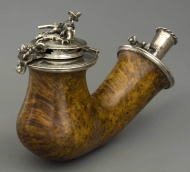
The shape of this pipe bowl is derived from the bag-shaped tobacco pipe of meerschaum that was made from the eighteenth century onward, throughout the nineteenth century. Although it is a typical meerschaum shape, it was copied in other materials as shown in this wooden example. The shape of the bowl changes over time, although it is not easy to determine exactly how the development is progressing. In this case a slightly tapered upper half of the bowl can be seen, more specific for Germany than for Austria wich makes a German origin of this pipe probable. However, what makes the pipe bowl special is not its shape, but the mounting. Bowl and stem are provided with a silver fittings with a sculpture on the lid. In this case a hunting scene: a proud hunter with a gun, in front of him lies a shot deer, his hunting dog is watchful by his side. The silver stub plate is also decorated, here we see a standing man, legs wide, arms extended. Although the silverwork is not very detailed, such representations are rare. For the smoker it was an attractive conversation piece to impress his friends after the hunt, although it added nothing to the comfort of smoking.
Amsterdam Pipe Museum APM 21.678
PermalinkBust of a black woman
septembre 2013
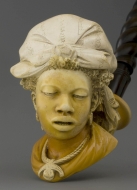
This beautiful portrait pipe shows a popular subject: a negro women, often depicted with a slightly opened mouth in which even the teeth can be seen as a test of skilled carving. She is shown here with earrings and a koti, a loosely draped fabric headdress with a bow on the front. The bust shows some simple clothing in which a double necklace with a pendant. This part of the pipe is made in so-called double cire. With that finish the meerschaum discoloured in two shades for an extra playful effect. Considering the quality of the carving, we tend to attribute this pipe to Vienna, but at the same time other well qualified carvers worked in other cities such as Paris. This makes identification of such late nineteenth-century pipes extremely difficult. Many elegant pipes had an amber stem in that period, but here a somewhat old-fashioned stub was used in which a separate stem was inserted. The pipe still has its original stem of brown-black buffalo horn with a twisted stem, crowned by a polygonal type of bell shape. The actual mouthpiece is bent with a kink.
Amsterdam Pipe Museum APM 21.674
PermalinkBlack-baked standard Gouda pipe
août 2013
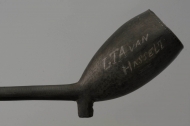
Of all Gouda pipes, the standard pipe has been the most general and also the most popular. With its long, delicate stem of half a meter and beautiful oval-shaped bowl, it was a worldwide trade success. This particular pipe was made by Jan Prince & Cie in Gouda, one of the most important nineteenth-century factories. A fish, flounder, in Dutch called both, is applied as a heel stamp, which is not Prince’s best mark, that are the milkmaid and the lion in the Dutch garden. Despite the somewhat lower status of the mark, the pipe is of optimum quality, with a beautifully balanced bowl shape that has been carefully stroke burnished and a perfect straight stem. Rare in this case is the black-fired colour, a more luxurious version than the white one because the saggars were filled with sawdust before firing, which caused the white clay turning black by nip and smolder. It is often claimed that black pipes were only intended for funerals, but that is not true. This pipe, for example, with a handwritten name on the bowl, stood in a pipe rack of a Dutch family. The gentleman of the house welcomed his friends and offered them a smoke, other than his own. The date is somewhere in the nineteenth century, at least before the year 1897 when the Prince factory closed its doors.
Amsterdam Pipe Museum APM 21.644
PermalinkBronze work with geometric ornaments
juillet 2013
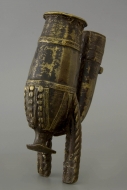
Beautiful in design and complicated in shape you could call this bronze pipe bowl. The oval-shaped bowl is no less than eighteen angled and ends at the bottom with a heel shape that again becomes a flat rectangular plate. The bowl opening has a flat protruding rim. The bowl itself is decorated with embossed bands all around, the most characteristic are rows of kauri, the sign widely used in Africa for money and wealth. But it didn't stop there. The maker has added two elongated flat legs, which are also decorated with geometric relief. The stem of the pipe is upright and ends without a cuff. A locking eye is provided in order to secure the mounting of the wooden stem. This pipe is made in Nigeria with the Igbo tribe. We can certainly admire the wonderful combination of form and the minimalistic application of decoration, resulting in a fine design,
Amsterdam Pipe Museum APM 21.578
PermalinkA flat cap to catch the sparks
juin 2013
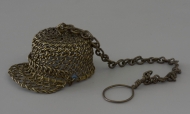
The braiding of objects from wire of iron, copper or brass has been a popular pastime in the eighteenth and nineteenth centuries. Not only for men but also for women. There is even a booklet with instructions for hobbyists in the braiding, specially meant for women of the higher class. Not surprisingly, therefore, that there are also objects made of silver wire and even gold wire. However, this pipe cap is simply made of brass wire, although it does have an original shape. It has been designed as a flat cap with a flap and will certainly have fitted well with a figurative pipe bowl, to provide a headgear to the represented person. In any case, there is pretty regular wickerwork with the original detail of two blue glass beads that are braided at the beginning of the flap. Of course, a safety chain with an eye is not missing, to prevent the pipe cap from falling off the pipe on the way and being lost. Thanks to the stem eye, he would dangle on the pipe.
Amsterdam Pipe Museum APM 21.602
PermalinkEuropean vision of the chiboucq
mai 2013
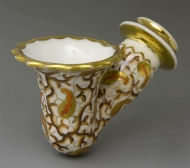
In the Turkish-speaking area, two types of pipe bowls developed that have been used indefinitely. Both listen to the name chiboucq, but there is a big difference in design. The best-known is a cup-and-saucer shape where the pipe bowl is placed on a flat saucer. This dish is missing in the chiboucq with the round bottom where the underside of the bowl is rounded off. The illustrated porcelain pipe bowl was inspired by the latter type. The design is unmistakably Turkish, including the multi-sided bowl with a serrated edge around the bowl opening. The multiple disc-shaped cuff is also typically Ottoman. What makes the pipe bowl European is, besides the porcelain as material, mainly the painting. On the outside, a repetitive ornamental pattern has been applied on the bowl and the stem in the colours brown and orange, heightened with gold leaf. The pattern is reminiscent of exotic fabrics and thereby emphasizes the exclusive oriental fashion. It is probably a French product.
Amsterdam Pipe Museum APM 21.560
A figure pipe as a portrait bust
avril 2013
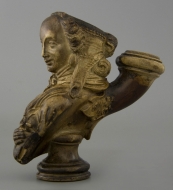
Duméril Leurs from Saint-Omer in France brought a set of pipe bowls on the market shortly after 1850 of a drinking man and a smiling woman, unmistakably a couple. A special feature of this set is that the pipe bowls are provided with a circular base on the underside so that they can stand as small busts. An invention that points to curiosities rather than practical use. The man's pipe bowl was added to our collection as early as 1980; finding the woman would not succeed. Recently the missing woman from the famous French collection of Daniel Mazaleyrat was purchased and we can finally show the set. Unlike the man, the woman, with loose hair and largely bared breasts, was popular. Perhaps that challenging image was the intention. The bowls are provided with shape numbers 1671 and 1673 and you immediately wonder what pipe bowl was placed on model number 1672. It is remarkable that both pipes are smoked and that undermines the idea that they are purely for ornamental purposes. Evidently, they are used as smoking implements, although the pipe, when fitted with a stem, will be out of balance and can no longer stand, so that the design is not really functional.
Amsterdam Pipe Museum APM 21.539
PermalinkHealth pipes in a pocket box
mars 2013
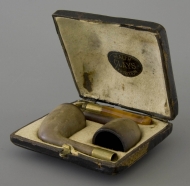
At the end of the nineteenth century, smokers more and more often discussed the health issue of smoking. It was gradually realized that smoking from dirty pipes increased the risk of lip cancer and that too strong a taste of tar did not benefit the aroma of the smoke. For that reason, pipe makers experimented with porous clays that absorbed tar and nicotine better. In addition, the interchanging of pipe bowls was promoted, with the best example being the café pipe that was sold in a box of six bowls with one stem. When the clay was saturated with tar, it was recommended to place a new bowl on the stem. The box depicted here must be seen in the light of that movement. Inside we find two pipe bowls and a loose screw stem with a luxurious amber bite. By alternating the pipe bowl when smoking, it has time to dry and thus gives a better taste. It is unexpected that the luxurious amber and the elegant case do not match the cheap clay pipe bowls. Case and mouthpiece are too durable for the speed with which the pipe bowls become saturated of tar and nicotine and should be discarded, if the clay doesn’t break in the first place.
Amsterdam Pipe Museum APM 21.334
PermalinkSnuff box with mother-of-pearl lid
février 2013
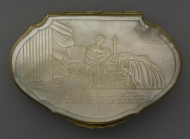
The representation on this gold-plated brass snuff box with contoured edges is typically Dutch. On the top of the mother-of-pearl lid you can see a folk-art scene. At the center a woman bearly dressed in a sheet stands nearby a table with a burning candle, on the left a chair stands aside a four-poster bed, a potty in front of it. It will not be a coincidence that the candle is phallus-shaped. Below the carving we read that the woman cannot sleep because she is stung by fleas. But, she says, if she had a man to have fun, she would no longer think of the fleas but would give the man her virgin rose. A naughty, somewhat erotic tinted snuff box. As it happens, this scene was carved after a popular print by Paul Oham the Younger, that was already in circulation in the mid-seventeenth century. In addition to snuff boxes like this one, elongated tobacco boxes with the same scene have been made.
Amsterdam Pipe Museum APM 21.351
PermalinkSnapshot of tobacco production
janvier 2013
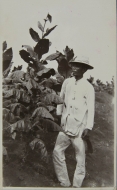
No matter how manifest tobacco-cultivation was on Sumatra when the Delimaatschappij was in charge, the Dutch people hardly knew this culture. Not surprisingly, photo reports were made in which tobacco production from seed to tobacco bale was recorded. That certainly happened more often when photography had well developed. A photo reportage allowed the planters in the Dutch East Indies to inform their family and friends of the proces in the plantations. In addition, such books also served to win investors for the good cause. The photograph shown here is one from a series of 78 that show the culture of the tobacco step by step and that are pasted in an album in chronological order, with handwritten notes. In the photo shown here we see a native who shows how large the tobacco plant is when it is ripe for harvesting. A bit of a misleading picture because the plantation workers were at least a head smaller than the settlers. This photo is halfway through the series because afterwards the fermentation and the processing into export bales are shown. This photo album was created in 1928 and is therefore a wonderful time document of tobacco production in those years and a valuable addition to our collection.
Amsterdam Pipe Museum APM 21.323
PermalinkPortrait pipe in steatite
décembre 2012
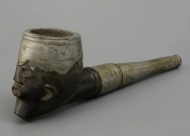
No greater variety of tobacco pipes is known as from the country Congo, and that is not only due to the size of that country. It seems that every tribe had its own smoking equipment and the variation is endless. The illustrated stone pipe is made by the Mayombe and is characteristic for that tribe. In terms of the use of materials, the pipe is one of the extremes because the Mayombe used steatite for the bowl and carved that type of stone into a stylized portrait pipe. The chin of the figure became very appropriately the heel of the pipe. Next, the bowl opening and stem were filled in with lead. The pipe is then mounted on a lead mouth piece, which is attached to the bowl with a wooden stem, ensuring that the two parts are connected airtight. That these pipes are primarily a status item and not a use pipe may be clear. Stone and lead are pre-eminently unsuitable materials for a pipe. They are heavy and, moreover, do not absorb moisture. In the worst case, the lead can melt by burning tobacco. However, such pipes are indeed smoked, as witnessed by a comparable, intensively used item in our collection. Interesting about this pipe is that it was preserved in Africa and only came to Europe a century after manufacture.
Amsterdam Pipe Museum APM 21.211
PermalinkMeerschaum with briar lining
novembre 2012
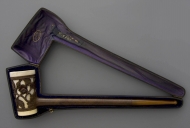
Interesting are tobacco pipes made from both meerschaum and briar, actually balancing between the two industries. Thanks to the meerschaum the pipe offers the advantage of a neutral taste and good moisture absorption, while wood provides the strength and durability. The pipe pictured here is a wonderful product of the interaction in both materials. Witness the stamped GBD brand it was made by Ganneval, Bondier & Donninger, a Paris-based firm. GBD is known for their tobacco pipes of superb luxury and unexpected design, initially in meerschaum. This product shows that they brought together the best of two disciplines. The long stem is made of wood with an amber mouthpiece. The bowl, on the other hand, is entirely of meerschaum, although it is encased in a fragile network of wood that has been carved audaciously showing fine branches with leaves and roses between two horizontal lines. This delicate woodwork deserves all admiration. The subject is not very masculine in appearance, which we see more often in pipes and apparently did not seem to bother the users. In terms of manufacturing technology, there is still a hidden gem. Cutting the wood so finely was of course a great art. After that the meerschaum bowl had to be mounted and if you look closely, you will see that the bowl insert had to consist of two parts, between which the wood carving clung. Conventional for luxury pipes from that period is the corresponding cassette to protect the object. Here too, the mark is stamped with the reference Paris, which indicates the early date of this pipe. An additional inscription with "EXPOSITION UNIVERSELLE PARIS 1889" illustrates the significance of the company as a participant in the world exhibition of that year.
Amsterdam Pipe Museum APM 21.195
PermalinkCire perdue snuff bottle
octobre 2012
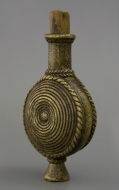
In addition to pipe smoking, sniffing tobacco is another widely used habit. Even in countries where the pipe is a dominant smoking instrument, this habit is alternated with the sniffing of powdered tobacco. This bottle, exactly eleven centimeters high, is a good example of the use of snuff in Africa. It is made of bronze in the cire perdue method. The original object is moulded in wax. This wax model is packaged in clay and after heating, the clay hardens while the wax melts and runs away. In this way a simple mould is obtained which, filled with bronze, results in this object. The geometric decoration is striking with on both circular bellies a beautiful spiral that springs from a button in the middle and extends to the outer edge where it merges into a cable edge. To preserve the aroma of the tobacco, the bottle is closed with a wooden stopper, which is still present with this specimen. In addition to these bottles, bronze tobacco pipes manufactured in a similar way are smoked in the same culture. Although it is said to be a typical object for the Grasslands of Cameroon, they are also attributed to the Vere in eastern Nigeria. This might count as a proof that items intended for a specific use are sold by traders to remote areas and are in the end appropriated there.
Amsterdam Pipe Museum APM 21.180
PermalinkA bird's claw in exotic colours
septembre 2012
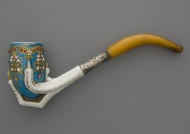
Although porcelain as a material is not particularly suitable for tobacco pipes, because it does not have a moisture-absorbing effect, it is nevertheless widely used. Not surprising, the appearance of porcelain is always fresh, even enhanced by enamel colours as this pipe shows. In terms of design, there is nothing special about it. The bird's claw at the bottom of the egg-shaped pipe bowl is a frequently used motif, presumably created by the clay pipe manufacturers, although it has also been worked out in other materials. A similar design of a claw is known from the Gambier company. In this case, the porcelain pipe is not a replica made by casting but produced after a new modeling. In terms of appearance, however, this pipe wins over the clay counterparts because here the pipe is finished in a stunning turquoise, which is then heightened with enamel dots and finally covered with gilt. It is clear that a striking pipe has been obtained. There is also luxury in the mounting. A silver band with engraving forms the zone between bowl and stem. Subsequently, no stem of caoutchouc or wood was chosen for the mouth piece, but the luxurious amber. Altogether, a new article was launched by the porcelain manufacturer for a wealthier category of smokers.
Amsterdam Pipe Museum APM 21.048
PermalinkPipe bowl as bust
août 2012
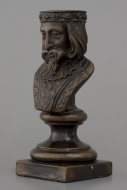
This remarkable figurine of pipe clay with the bust of King Solomon is made of a pipe bowl, which is completely filled in and got a base of pipe clay. The represented is depicted as a historical figure with mustache and goatee, medium length hair and a kind of crown on the head. The bust itself shows an embodied robe and pleated collar. The object is stamped on the back with the mark of the pipe manufacturer Duméril Leurs & Cie in Saint-Omer. To give the bust more the appearance of a statuette it is covered with bronze-coloured lacquer that is covered with a transparent lacquer. This gave a pipe bowl a second use as a decorative object. The company Duméril is known to have made more figures in pipe clay, which stand out for their high quality and fine finish. The question is whether such curiosities were profitable in production at the time, but it might be the reason why we rarely come across these articles.
Amsterdam Pipe Museum APM 21.043
PermalinkBroken stem
juillet 2012
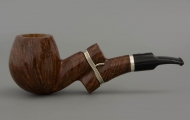
In addition to being a famous pipe design, this pipe is also a visual joke. The stem of the pipe appears to have been sawn in two parts and put back together with a piece of metal wire. An original design that was first applied in the 1930s by a pipe maker from Saint-Claude. Now the design has been taken back into production by Ser Jacopo Dalla Gemma, a maker from Pesaro in Italy who is known for his beautiful designs in high quality pipes. He brings this design under the name Inoanus. On the stem of the pipe we read his signature and also that it is a handmade object "SER JACOPO FATTA A MANO IN ITALIA". We see the quality of the pipe in the beautiful straight grain of the bowl and the subtle way in which the stem is made, seemingly in two parts but of course in one piece. To reinforce the joke, the onset of the stem bore is reproduced in the broken stem pieces.
Amsterdam Pipe Museum APM 21.359
PermalinkImperial visit to the city of Rennes
juin 2012
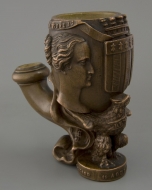
19 August 1858 was a special day for the inhabitants of the town of Rennes. The imperial couple, Napoleon III and his beloved ega empress Eugénie visited the city of Rennes with their son, the prince impériale. The local pipe manufacturer Alexis Picard availed himself to the opportunity to produce an occasional pipe that was even released in two sizes. Here you can see the large version, with a height of more than ten centimeters. The pipe has a vase shape and can stand upright independently. The bowl shows the imperial portraits on both sides, and on the stem side you can see the heir to the throne. The front is decorated with the city coat of arms of Rennes. The cities Brest and Cherbourg, visited by the imperial family on the same journey are mentioned en passant. At the base the pipe bowl is held by the imperial eagle with spread wings, with the signature "A. PICARD 19 AOUT 1858 A RENNES" on the base. The transition from the bowl to the stem is beautifully done with a playful motifs of foliage or maybe shell shapes. What makes this robust pipe bowl extra special is the finish. The white fired clay has been given an electrolysis bath, which gives it the appearance of a piece of bronze casting. As a matter of fact, a technique that was used more often in those days but certainly not done in the pipe making, but by a company that mastered the technique of bronzing. The luxurious finish of this pipe evokes speculation that this specific object might have been offered to the imperial couple.
Amsterdam Pipe Museum APM 21.027
PermalinkBag shape with rocailles
mai 2012
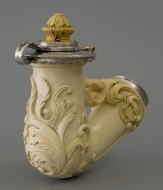
It is the dream of the collector of meerschaum pipes to find an early piece, a pipe dating from the eighteenth century or even earlier that confirms the evolution of the meerschaum pipe. This pipe bowl has that appearance because of the characteristic rococo style, but if you look closely you will see that it is a neo style. The pipe bowl is a conically raised bag shape with the usual slightly rising stem ending in a stub. On the front of the bowl, continuing on the underside, a beautifully shaped motif of feather-shaped leaves has been carved that most resemble a free and above all elegant interpretation of the acanthus. The ornamentation is closed on the left with a C-volute with a foam head that is characteristic of the rococo. An open-worked C-volute connects the stub with the bowl wall. Also note the lid that has a meerschaum insert and ends with a button. Although everything is executed in eighteenth century style, it is a nineteenth century adaptation which is betrayed by the details. The bowl is not convex enough, the top is too elongated, the c-volute between bowl and stem too stiff. No, the rococo style was a lot more flamboyant than this pipe bowl shows. In addition, the later dating is also confirmed by the silver hall marks, which testify to a date after 1870. Yet it is a fine piece made in a skilled manner in a leading Viennese workshop.
Amsterdam Pipe Museum APM 21.017
PermalinkPipe bowl from the Dogon culture
avril 2012
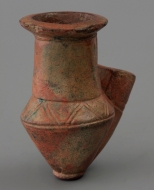
For many African cultures, no history has yet been written about their smoking culture and the pipes that they used. That applies for example to the Dogon in Mali. Although countless excavations have been made in that area in recent decades, little material has been published about their smoking habits. Finds in any case point to pipe bowls that are beautifully designed, such as the example shown here. The softly baked ceramic does not allow stemmed pipes, so that all examples have a stub stem, often it is square at the end without a stub, features that are the most characteristic for the Dogon's pipes. The pipe bowl itself has a beautiful shape, double conical with an oblique edge halfway. The opening is reinforced with an protruding bowl rim. After moulding on the turntable, the hand-shaped stem is glued to the pipe. As decoration, lines are scratched to finally dip the object into a bath with iron slip to get a nice shine. All these actions point to a well-developed pottery industry. Although countless pipes can now be recognized as Dogon, the chronology is yet to be determined. Some research into this aspect is due to be done in the coming years.
Amsterdam Pipe Museum APM 20.987
PermalinkAn Eskimo pipe with circle holes
mars 2012
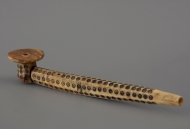
In the far north, the Eskimos or Inuït lack almost everything. Smokers have only limited access to tobacco and consume it in minimal quantities. Materials are also scarce, with the exception of bone that is widely available. It is therefore not surprising that many smoking pipes are made of bone such as this fine pipe. In terms of shape, it is a real Eskimo pipe with its upright bending stem and bowl with a wide rim to prevent tobacco crumb from falling out of the pipe bowl. The small bowl capacity also fits in with an area where everything is scarce. It is customary to decorate this bone work, with carved scenes being the best known. However, this pipe is decorated with a repeating pattern of circular holes that are made with a simple drill. They are then coloured with black dye to stand out better. With a length of only 15 centimeters, this pipe is one of the smaller smoking instruments of the Eskimo.
Amsterdam Pipe Museum APM 20.961
PermalinkGouda pottery pipe stand
février 2012
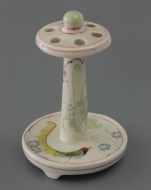
At the interface of the traditional moulded clay pipe and the cast pottery in plaster moulds, newly invented in Gouda in the 1920’s, a new product was created: the racks and stands for miniature pipes. So a connection was made between the old, traditional clay pipe and the modern product, the glazed and colourful Gouda pottery. Wall racks of such designs become extremely popular, while the stand, such as the one shown here, is quickly disappearing from the market. Not surprising, because the racks hang undisturbed on the wall, while the stands are free, easily knocked over, resulting in broken pipes. Even when just dusting the risk of breakage is there. The specimen shown here is such a rare stand, only 7.5 cm. in height. It is produced in Gouda matt pottery with a subtle Art Nouveau painting of delicate lines and a a kind of bird of paradise as the main motif. Pay particular attention to the fillet on the dish, where quite unexpectedly some zigzags have been made in the continuous line, characteristics of Art Nouveau. On the bottom the object is marked with an intaglio shape number, while the factory name "IVORA GOUDA" is painted in brown letters.
Amsterdam Pipe Museum APM 20.909
PermalinkDesign drawing for a presentation pipe
janvier 2012
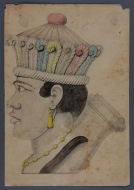
IIn the third quarter of the nineteenth century, a series of three drawings was made for a display pipe by the company Félix Wingender in Chokier near Liège. The pipe represents the head of an Indian with a feather headdress and nicely enough the pipe has a lid with button. The three design drawings executed in color show the three sides of the pipe bowl. However, we see unexpected differences between the drawings. The main thing is that the figure is depicted in two cases with mustache and goatee, the third version is beardless. That this last design is actually executed as a pipe is proven with a presentation pipe, known for years in a collection in Belgium. It is unexpected that the factory stamp on the drawing is also applied on the bottom of the pipe. What makes the drawings so unique is that they are the only surviving examples of clay pipe designs. It is special to see the difference between a two-dimensional pipe bowl and a real executed one. Then it turns out that the drawing is more beautiful. The pipe of the drawing is more elegant than the three-dimensional version. Because of its large size it is rather massive and primitive. Of course, the question remains whether the version with mustache and goatee is also designed as a display pipe. It would be nice if it would turn up somewhere in the future.
Amsterdam Pipe Museum APM 20.891c
PermalinkRoyal Copenhagen
décembre 2011
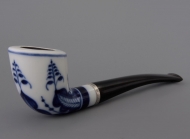
Porcelain is not a suitable material for a smoking pipe. Nevertheless, from the moment that porcelain was made in Europe, pipes have been made in that material. By making the pipe hollow-walled, part of the disadvantage, the development of condensation was compensated. The factory Royal Copenhagen Porcelain Co. Ltd. has released a series of pipes in the seventies of the last century. Popular shapes of briar pipes were copied for this purpose, mounted with a caoutchouc stem. Characteristic of that series is the blue underglaze in a hand-painted geometric-ornamental style based on stylized leaf work. The factory brand of three wave lines is painted at the bottom of the stem, where the porcelain changes in the mouthpiece. The pipes were never a success in sales. They were offered in luxury household stores, but also at the better tobacconist's, almost all over the world. However, the selling price was so high that most smokers did not dare to experiment and, surprisingly, some shapes remained on sale for decades. If we come across these pipes on the market today, they are usually unsmoked or used only a few times. That is not an indication of the smoking pleasure that the consumer experienced.
Amsterdam Pipe Museum APM 20.883
PermalinkTwo smokers immortalized
novembre 2011
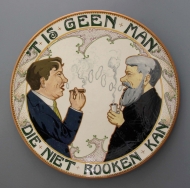
When this striking wall plate was painted in the 1920s, the habit of smoking had changed dramatically. In the nineteenth century the cigar made its entree and the sophisticated pipe smoker switched to this new way of smoking. This change is expresses by this illustration: a younger man with a cigar, an older man with a tobacco pipe, each blowing lustful circles of smoke. Only the traditional Dutch saying " HET IS GEEN MAN DIE NIET ROOKEN KAN" (it is not a man who cannot smoke) has remained unchanged. Yet the illustration is traditional as well because the cigarette, the smoking habit of the twentieth century, stays out of sight. The two smokers are framed by thin and innovative ornament work in the style of Art Nouveau. Special about this dish is that the artist is known. It is Jan Guérain, who was a painter at the Ivora works for years, the ceramic factory that originated from Gouda's oldest pipe factory, the WS factory. Guérain worked there for no less than 24 years and has left a wide oeuvre. In addition to thousands of smoker's plates and countless small objects, this is one of his majestic objects. The dish may have been intended for a tobacconist shop where itserved as decoration and advertisment.
Amsterdam Pipe Museum APM 20.856
PermalinkSnuff box in Meissen manner
octobre 2011
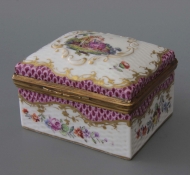
Taking a pinch is a culture that is surrounded with greater luxury than pipe smoking. Especially in the eighteenth century, unreal chic objects were created for this use. The countless golden boxes, whether or not inlaid with precious stones, are to be found in royal collections all over the world. The illustrated box is an example in the category of porcelain boxes, which were made in the best factories in ever-changing styles. The porcelain of this square box shows a subtle relief work in which cartouches of feather shaped scrolls separate a roughened surface from the smooth part that is meant to be painted. This subtle relief is the example for the painters who later coloured the box. Along the edges of the mounting, which enable a hinged lid, scaled leaves are paintedin a fashionable purple colour. The main illustration is in the cartouche on the lid and shows a man and a woman in a garden landscape. If you look closely at this box, you will soon discover that it is not really the fineness of Meissen painting. The paintwork lacks the details and is a bit lumpy. The slightly changed underglaze mark is also not characteristic of Meissen, where every sword in the mark has its own line. Here the two swords must share one simple line. Finally, the porcelain is slightly heavier in design and sloppy in the relief work. Nevertheless, this object is an interesting example of a snuff box that, as a matter of fact, will have served primarily for the show.
Amsterdam Pipe Museum APM 20.870
PermalinkStudent portrait with tobacco pipe
septembre 2011
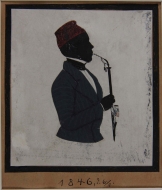
Pipe smoking was extremely popular among German students. Thousands of portraits were painted in the nineteenth century on which students are depicted with their favorite pipe. This painting is one of them. You can see a silhouette portrait of a smoker in a rather formal dress with a characteristic hat enjoying a tobacco pipe, the porcelain bowl of which is decorated with a coat of arms. Often these were pipes received as a gift from student friends since there was an elaborate culture in presenting pipes with special paintings such as portraits, family coats of arms or monograms. Many of those pipe bowls bear witness to this exchange of gifts by the names of the donor and the recipient written on the reverse. It has never been explained why German students had such a strong preference for porcelain pipes, while in many other circles the more comfortable meerschaum was preferred. Only the fact that appropriate decorations could be easily executed could have been the incentive.
Amsterdam Pipe Museum APM 20.860
PermalinkChibouque with tsar portrait
août 2011
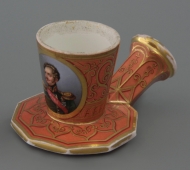
Many pipes seem easy to interpret, but on closer inspection appear to be full of mistery. This is the case with this special porcelain pipe bowl in the shape of an Ottoman chibouque with a dish shaped base. At first we see that it is an orientalistic piece of porcelain, but unmistakably from a European factory. Thanks to the shape with the octagonal dish and the conical pipe bowl, it seems that this is a follow-up to an early nineteenth-century Turkish chibouque. Because the porcelain cannot inform us about the origin, markings are non existent, hope is focused on the decoration. This could be either the style of the ornaments or the interpretation of the portrait oval showing the bust of tsar Nicolas I, who diend in 1855. Unfortunately, here too, there appears to be no information for a more precise determination, except that it concerns an object from the period between 1830 and 1850. It is even unclear whether it is French or German porcelain. Despite the riddles, the pipe bowl is an exclusive piece of porcelain, made in a limited edition or executed as a special commission. A second example in this design and painting style is not yet known.
Amsterdam Pipe Museum APM 20.577
PermalinkShow piece from a pipe shop
juillet 2011
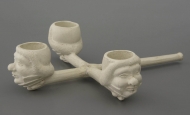
For years, the pipe factory of Martinus Nicolaas van Duijn was established on the Pepergracht in Gouda, a small company like there were many factories in Gouda for centuries. In 1885 Martinus had taken over the company from his father's legacy and continued the ancestral craft for forty years. At such small workshops, the actual pipe shop, workshop and family home merged. The store was located on the street with two shop windows on either side of the front door. The shop window advertised the sale of pipes for passers-by, smokers and tourists. There was a small counter in the store with supplies on a shelf behind. This three-bowled tobacco pipe comes from the shop window of Van Duijn, where, in addition to conventional pipes, there were also a few curiosities, show pieces to better advertise the business. This three-headed pipe was such an eye-catcher of which we do not know whether it was also in regular sales or was made just once for show only. When the company was dissolved in 1925, this pipe remained with the family as a souvenir, along with some pipe-making tools. Only a generation later did it change ownership and end up in a collection. This object has been miraculously preserved and, believe it or not, it is the only presentation pipe that remains of all the show pieces that were ever decorating Gouda pipe-shops. Of course, this is due to the high fragility of these types of curiosities. We will keep it safe for the next period.
Amsterdam Pipe Museum APM 20.543
PermalinkPetrified smoker from Costa Rica
juin 2011
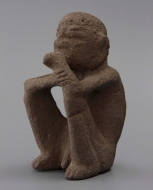
Magical is the depiction of early smokers from the time when pictures were not yet to be expected. This statuette of volcano stone from the Linea Vieja culture in Costa Rica, made between 900 and 1100, is one of that category. The figure is a medicine man or sukia who smokes from a tubular pipe as a primitive cigar. This is a representation of the Indian praxis to create a intoxication and to get a pleasant anesthetic with smoke. In addition, one can defuse evil spirits with tobacco smoke. The statue measures more than eleven centimeters and is compact in design. You can clearly see how the sculptor freed the seated person from the stone. There is therefore no question of a true three-dimensional representation. A good sculpture, when turned around, is equally attractive on all sides. In this case you can clearly see two very striking sides, whereas the frontal and rear zones are less appealing.
Amsterdam Pipe Museum APM 20.501
PermalinkNaked woman with flower pot
mai 2011
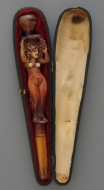
Towards the end of the nineteenth century, the tubular cigar pipe regained popularity. This new preference for simple pipes comes from smokers who have had enough of all those abundant decorations that were fashionable at the time. Those specific sleek products quickly inspire the meerschaum carvers into new figurations. They come up with pipes with a representation that, in terms of silhouette, follows the tubular shape but adds the decoration again. This pipe with its straightforward shape has been given an appropriate decoration by a standing naked woman holding a bowl with flowers above her head. The trumpet-shaped cigar holder is inserted between those flowers. As a matter of fact, such a naked figure was quite daring for the Victorian period and presumably this pipe only appeared in the men's room to be shown with pride to fellow smokers. The maker of this product is Ludwig Hartmann from Vienna, an established company founded in 1828. The Hartmann company developed into famous meerschaum makers, but they were also traders who had countless pipes made elsewhere in commission. This could be the case with this product, so we can not be sure of its origin.
Amsterdam Pipe Museum APM 20.452
PermalinkSouvenir painting on a wooden shoe
avril 2011
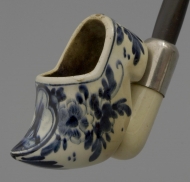
When the mystery pipe was developed in Gouda around 1910, this more luxurious pipe offers new opportunities for design, more related to briar and meerschaum pipes. This gave way to pipe shapes that never have been designed before. This wonderful souvenir pipe shaped as the typical Dutch wooden shoe dates from that period. A remarkable creation in terms of functionality because the inner bowl has a odd shape where a part of the tobacco can never be reached by the fire. That such a strange design gives the smoker a rather bizarre silhouette was apparently no problem but at least a unique selling point. Finally, over the top is the decoration of this pipe in a Delft blue palette. Typical Delft blue flowers are all around the clog, while a simple cartouche even depicts a mill on the top of the wooden shoe. The maker is the Ivora Plateelbakkerij, previously known as P. van der Want Gzn. from the Kuipersteeg in Gouda. Thanks to a stamped marking on the stem ferrule we can make that attribution.
Amsterdam Pipe Museum APM 20.433
PermalinkA pipe bowl in basaltware
mars 2011
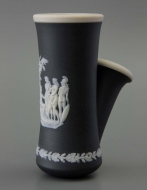
This cylindrical pipe bowl with constricted bowl is made from basaltware, stoneware with a matte black shard. This material is generally attributed to Wegdwood, but is also made in some other English factories. It is even unclear how large Wegdwood’s share has been in the entire production. Characteristic of the Wedgwood genre is working with appliques, embossed reliefs in contrasting clay colour, usually in white. On this pipe bowl we see the judgment of Paris depicted above a surrounding rim of oak leaves, with three standing graces posing in front of a seated Paris. The fact that no factory brand has been stamped gives the impression that the pipe bowl is made in Wedgwood style, but not by the factory itself. There were more factories in the Barlaston area in the nineteenth century that made these ceramics. Wegdwood was the inventor, but did not have sole rights. A pity of course that this manufacturer did not leave its name on the product, but of course this happened intentionally. To take full advantage of the original inventor's reputation, the product had to be without a brand name.
Amsterdam Pipe Museum APM 20.396
PermalinkAn English parliamentarian
février 2011
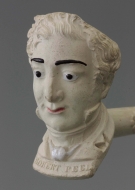
The Duméril Leurs & Cie company in Saint-Omer is the maker of this portrait pipe that was intended for the English market. Not surprising, because the person depicted, Sir Robert Peel, was known there as a Member of Parliament and was even elected prime minister twice. The pipe fits into a series of designs in which politicians are depicted from Robespierre and Danton to persons from the 1840s. Characteristic of the series of portraits is an embossed text line with the name of the sitter along the base of the bust. This makes it easy to identify the pipes. It remains unclear why those inscriptions were not placed on the stem, as was customary at other factories. Possibly this pipe is not contemporary, but from a somewhat later time fitting into a series of collectible pipes that have been expanded with a new copy each time. In this way, the Duméril company enhanced the customer loyalty of the politically engaged smokers, that could look forward to a new design. What makes this representation early in terms of dating is that the mouthpiece is still flattened and ends without a knot. After 1850 this disappears to make way for the standard node at the end of the stem. At the same time, the stem was shortened by more than a centimeter.
Amsterdam Pipe Museum APM 20.403
PermalinkWoman with cornucopia
janvier 2011
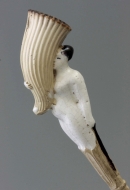
This early figural pipe shows along the stem a naked woman who embraces a ribbed cornucopia. It is a remarkable representation because the modeling is extremely primitive, but touching at the same time. The woman is shown to her knees, as it were, rises from four long pointed leaves that have been applied as a stem decoration. The stem end itself is flattened and without a knot which characteristic indicates a very early date for this figure pipe, perhaps even in the 1820s or 1830s. Another evidence of the early dating is the production in a two-part mould. Later such a complicated figure would have been made with a multi-part pipe mould, so that the details could be more refined. In accordance with the customs at the Belgian and French pipe factories, the result was embellished with accents in enamel paint. This is what happened here, albeit rather primitively: the white enamel is so thick and syrupy that the details of the woman have completely disappeared. In fact, the glaze hides the sexy naked woman, which the smoker would really like to see in detail.
Amsterdam Pipe Museum APM 20.411
PermalinkA hard rubber cigar holder
décembre 2010
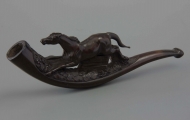
In the second half of the nineteenth century, caoutchouc or hard rubber became popular in the pipe industry. In addition to mouthpieces, it is also used for complete cigar holders. These can be made in this material because the last part of the cigar butt is so saturated with tar and nicotine that it is never completely smoked. As a result, the cigar holder does not come into contact with the fire and that shouldn’t do either, because para rubber is flammable. If it catches fire it gives off a very dirty greasy fume. The design of this holder is inspired by the popular meerschaum cigar holder, the horn-shaped pipe into which the cigar is inserted, decorated on the stem with a galloping horse in high relief. For this article, as we can see, not something original was chosen, but rather the most clichéd. Horses in the trot are simply the most commonly made. The manufacture of para rubber pipes took place both in France with Saint-Claude as the main city, and in Germany, where Ruhla is the most important town. Attributing these unmarked pipes to a specific maker or factory is extremely difficult.
Amsterdam Pipe Museum APM 20.378
PermalinkExclusive stone with a complicated stem
novembre 2010
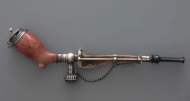
No doubt that this exceptional tobacco pipe with its attractive red-marbled stone pipe bowl, embodies luxury, except for those who have a mere eye for smoking comfort. Natural stone is not the best material for making smoking pipes. It absorbs heat poorly and there is no question of moisture absorption. In addition, stone has a largeweight so that holding a stone pipe between the teeth is not an option. Fortunately, the total materialization of this pipe compensates for these user-unfriendly properties. The stone is beautifully polished and the bowl opening is provided with a decorative hinged cover. Particularly noteworthy is the stem that starts with a spherical silver moisture trap, which acts as a drip reservoir and absorbs nicotine juice and condensation. The stem itself is made from a real hare bone that does have some porosity so that the last moisture is absorbed therein. Breathtaking is the mounting of the stem which is attractively encased in silver, whereby a pipe-cleaner shaped as a sword has been included along the stem. The short mouthpiece is made of dark buffalo horn. The shape of the pipe bowl clearly derived from the German stummel, that in its turn goes back to the Gouda clay pipe. In this case a familiar shape was chosen for a product with an exceptionally posh appearance.
Amsterdam Pipe Museum APM 20.368
PermalinkPlastic with meerschaum inner bowl
octobre 2010
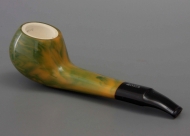
In the 1960s the Hilson company from Brée in Belgium developed the Hilson Fantasia, a pipe with a flashy appearance. The outside of bowl and stem was made of moulded plastic, in many cases in beautiful marble colours, but also in plain version. Because plastic is not porous and, moreover flammable, a tobacco pipe of that material can only be functional with a non-combustible inner bowl. It was found by applying an interior in pressed meerschaum grit. The stem of the pipe is made of the usual black hard rubber. As innovative as this pipe was, it is a follow-up of other plastic pipes from the same period, such as The Pipe, an English initiative by Falcon for a cast plastic pipe. However, the smoker was not very enthusiastic about the Fantasia. A bit understandable though, because the rubber mouthpiece turned out to be more fragile than usual, while the absorption of the semi-foam inner bowl was below standard. Thus the Fantasia became a short-lived fashion and not a keeper.
Amsterdam Pipe Museum APM 20.336
PermalinkTobacco pipe with cubic forms
septembre 2010
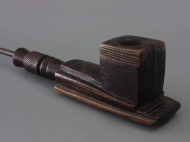
Congo is the country with the most diverse manifestations of tobacco pipes. The piece shown here is a nice example of a wooden pipe with such an unexpected design. The bowl has a perfect geometric shape that we could safely call cubist avant la lettre. The pipe bowl is square and rests on a flat rectangular platform, which has narrowed lines along the sides. Simple lines are carved along the rim of the bowl and stem, sometimes parallel to the main shape, sometimes as hatches at a certain angle. Finally, after a few geometric constrictions such as a cone, ball and cylinder, the stem turns into an iron tube for inhaling the smoker. Despite the unusual shape, this pipe cannot be placed in a certain culture or tribe, in absence of enough specific characteristics. However, it is a beautiful piece with an attractive age and a very well-kept finish.
Amsterdam Pipe Museum APM 20.306
PermalinkTable pipe in the shape of an eagle 's head
août 2010
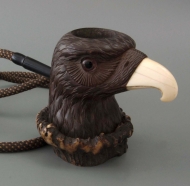
This pipe bowl is beautifully shaped as an eagle's head made of three materials. To begin with, the crown of a deer antler with its irregular surface gives a base or foot to the object, in addition to an exotic touch. The actual pipe bowl is made of a hard dark brown tropical wood. The carving has some Art Deco characteristics, such as the combination with an ivory beak, which in addition to the glass eyes, gives a lifelike accent to the bird. The pipe can be smoked by placing it on a table and using a flexible hose and mouthpiece. It is not known where this artistic object came into being, it can be anywhere, but at least in a place where people had great craftsmanship.
Amsterdam Pipe Museum APM 20.327
PermalinkSnobbish smoke set
juillet 2010
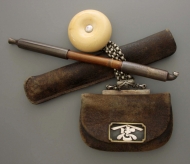
The Japanese smoker expresses his status with his smoking equipment, usually in a very subtile, understated way. This smoking set is quite different in this respect. It consists of a leather pipe case and a leather tobacco bag, both oversized. On the tobacco bag, especially the lock plate stands out, with a silver character mounted on a silver plate, the outer edge in contrasting brass. With a heavy set of silver chains both objects are attached to a large ivory button, which holds the smokers set between the belt. In terms of status, this object seems fit for a self-assured cow seller, an article without any refinement that is really only showing off. This is so out of the ordinary in Japanese culture where refinement is so highy valued. The same applies to the corresponding pipe. That too is large and coarse and has a strong straightforward form. However, it is equipped with a tiny, normal sized silver pipe bowl that contrasts nicely with the iron of the rest of the pipe. The bamboo stem shows at the bowl side how the knots were removed to get a nice straight stem. It is unclear whether that unpolished zone was deliberately kept visible or not.
Amsterdam Pipe Museum APM 20.219
PermalinkA primitive elbow pipe
juin 2010
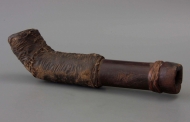
In addition to artificial tobacco pipes with a special design or artistic carving, there is smoking equipment that is rough or simple. This pipe is a great example of the latter. A simple earthenware pipe bowl is attached to a wide bamboo stem with a piece of leather. So, a large, robust pipe has been obtained with a silhouette similar to the early elbow pipes, but then much more explicit. The only decoration on the pipe is a band braided with plant fiber that is attached to the mouthpiece. This properly braided band prevents the splitting of the bamboo. The mouthpiece with a large diameter was intended to hold against the lips, unlike that of the European pipes where the mouthpiece is placed between the teeth. This tobacco pipe is not a product of great beauty, but it is a functional smoking implement that originated in an African culture in which showing off was not important.
Amsterdam Pipe Museum APM 20.217
PermalinkEarly pipe with extreme traces of use
mai 2010
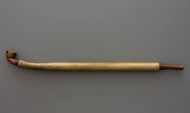
This Japanese kiseru is interesting for two reasons. First, the shape witnesses that it is an early example. It is an all-metal pipe, where the large diameter stem is made of brass, permanently attached on either side is the pipe bowl and the mouthpiece, both made of copper. The small pipe bowl and the specific onset of the stem, but also the slender cylindrical mouthpiece are characteristic of the early kiseru. Another remarkable feature is that the pipe has been used intensively for a long time and with Japanese pipes that means wear and tear. After smoking, the pipes are knocked out on the edge of a metal stove or ashtray. By doing this for years, the stem deformed through the hundreds of minimal dents which has given an unusual silhouette to the pipe. Here, there is no question of a luxury show-off kiseru, but an honest utensil that has found its mark through intensive smoking. It is the kiseru that the collector is usually not looking for, but that gives a good idea of the use of these pipes in Japanese culture.
Amsterdam Pipe Museum APM 20.227
PermalinkA devil's head made from coquilla nut
avril 2010
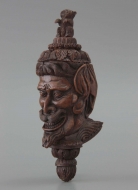
This remarkable pipe bowl is made from the exotic nut of the coquilla. It is a smart piece of craftsmanship that is made up of different parts. The most striking is the pipe bowl, cut in the shape of a fantasized devil's head. Particularly astounding are the large devil's ears, but also the strong features in the face, the gargantuan row of teeths, the mustache and long goatee fit into that sphere. A kind of geometric decoration of foliage forms a final at the bottom and a similar final as a cover on top, crowned with the figure of a sitting bear. The stem onset has leaf motifs. Several nuts will have been used for all these parts. We know coquilla nut carvers as highly skilled people who, in addition to a great imagination, also had a well-developed sense of form, proportion and decor, as this unusual pipe bowl examplifies. We are still in the dark about the manufacturing sites of these pipes. It seems most likely that the fresh nuts came from South-America to France and were processed into objects there. The wide variation in types of objects, motifs and the refined workmanship make it almost impossible that it concerns a foreign production.
Amsterdam Pipe Museum APM 20.210
PermalinkPipe and accessories from Bjarne
mars 2010
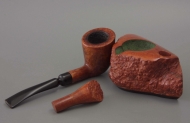
In 1973, Bjarne Nielsen, who until then worked at the Danish Ministry of Foreign Affairs, founded his own pipe workshop. Bjarne had been a pipe smoker since he was sixteen and would rather devote himself to the noble craft than to continue his office job. He focused on pipe shapes that were popular in the United States, such as freehands and large sizes. This pipe is an example of such a freehand with a beautiful straight grain nerve. The pipe is lightweight and extremely well-held. The luxury of this product is underlined by the fact that the maker supplied a hand-made pipe stand that holds even a briar wood pipe stopper. This stand demonstrates both the fleuron of the briar and the peculiarity of the longitudinal nerve. To complete the set a chic plinth of caoutchouc has been applied to the underside, a repetition of the caoutchouc pipe stem that protrudes so explicitly. Objects like these were hardly available on the Dutch market. The Dutch smoker has too little feeling for pipe designs and moreover does not want to spend too much money on his pipe. Not surprisingly, this example, from a Dutch smoker, was purchased in Interlaken. A serious purchase, because at the time just under five hundred guilders was paid for it.
Amsterdam Pipe Museum APM 20.132
PermalinkAn early effigy pipe
février 2010
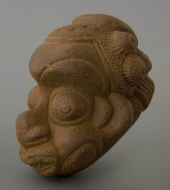
Tobacco smoking has not been known for so long among the people of the Grasslands of Cameroon. It was probably introduced there at the beginning of the nineteenth century. Pipes from that region are therefore rarely more than two centuries old. Yet this effigy pipe bowl looks centuries old and that is because it is an archaeological object. That the test of time had reined freely is mainly due to the soft-baked ceramics of which these pipe bowls are made. The surface of the object is quickly affected and therefore looks being much older. That is misleading because for the production of such portrait pipes with mature style characteristics, an industry certainly had to exist for a generation. Anyway, this pipe bowl is a beautiful early piece with mature style features that fits the Bamum. Characteristic are the round eyes with the circular pupils, the relief in the face, the small crescent-shaped ears and the specific mouth. Between the bowl and the stem end is a ceramic band, which is pierced and serves to attach a security cord to the pipe stem. Due to the soft ceramics, few of these early pieces have been preserved, but thanks to the strong tradition of pipe making, many styles are repeated endlessly later on. This pipe is proof of the primordial shape of many of these pipe bowls.
Amsterdam Pipe Museum APM 20.124
PermalinkPipe holder from a series
janvier 2010
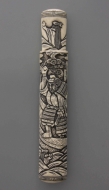
In Japan, the tobacco pipe, the kiseru, is stored in a case, the so-called kiseruzutsu. In addition to wood as a material, bone or stag horn is often used. This specimen is made of bone and consists of two sliding sleeves, the outside of which is extensively decorated. The scene shows a warrior in historical costume with a second figure in front of him, a fish in the water. We also see rocks, blooming flowers and a tree trunk. Part of the main show will extend on the cover section. Unfortunately we miss the meaning of this depiction. The carving is a bit scratchy and is then rubbed with black paint. There is no question of great artistic work, it is more the curio aspect that stands out. Interestingly, there is a series of six examples of this pipe holder that are very similar but all different. The set was purchased in 1888 by the Rijksmuseum voor Volkenkunde from a Leiden tradesman. The fact that the purchase took place over a 120 years ago is extremely unexpected. The kiseruzutsu developed a great refinement in Japan and at first sight these pieces would be labeled as 20th century souvenir pieces. However, the pedigree proves that it is different. The reason for the National Museum of Ethnology for deaccessioning these objects recently lies in their collection objective, but is not made public. For the Pijpenkabinet, they play a role in showing the variety of Japanese kiseruzutsus, although due to their lack of artistry they are certainly not the best examples.
Amsterdam Pipe Museum APM 20.088e
PermalinkFunnel shaped pipe bowl from Nigeria
décembre 2009
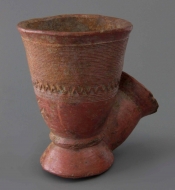
This large, well-shaped pipe bowl is reminiscent of the ceramic funnel beakers from prehistoric cultures in the Netherlands. Of course, that cannot be correct because it is a pipe bowl excavated in Nigeria with coincidentally similar characteristics. Note the rather elegant funnel shape of the pipe bowl, placed on a conical foot with a short ascending stem with stub on the separation of the two parts. Features, incidentally, that we also encounter in tobacco pipes in neighboring countries in West Africa, although the effect here is more stereotyped and exceptionally skilled. Beautiful about this object are the delicate incisions of concentric lines on the upper half interrupted by a zigzag band.Being excavated without any contextual background these generous pipe bowls give the impression that we are dealing with prehistoric African smoking equipment which is in fact a sensational thought. However, if we consider that smoking in Nigeria was introduced by Europeans in the early 1800s, we would rather expect pipes with a small bowl, here we are talking about giant bowls sizes with a height of up to ten centimeters. Although the material examples will contribute to the insight into the smoking utensils in unknown areas, unfortunately, for the time being the story behind these objects will remain veiled. Future excavations in the area will hopefully bring background information.
Amsterdam Pipe Museum APM 20.089
PermalinkA golden ducat in the lid
novembre 2009
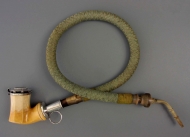
With many tobacco pipes, the lid is a status in itself. That certainly applies to this pipe, made of meerschaum with a constricted multi-sided bowl and flattened bottom. A historic gold ducat from 1803 has been added to the silver mounting in the lid. A wonderful curiosity that undoubtedly hides a love from the then first owner. There is plenty of speculation about this golden coin but unfortunately there is little evidence why this montage was made that way. That this pipe was found in the English antique trade does not explain anything. Moreover, there is a second feature that makes this tobacco pipe special and that is the original stem being completely flexible. Normally, a sturdy stem is mounted with a short flexible zone at the end for comfort to keep the mouthpiece between the lips. In this case, quite unexpectedly, a completely flexible stem was used. That seems practical, but the lack of firmness between the pipe bowl and mouthpiece makes this pipe a bit awkward in the hand. In fact, if the mouthpiece falls out between your teeth at an unguarded moment, you loose it. This mount is therefore rather a curious exception than a successful contriviance.
Amsterdam Pipe Museum APM 20.087
PermalinkTobacco stamp with history
octobre 2009
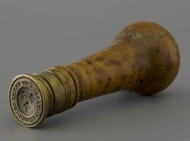
For the collection of taxes on certain services and goods, a contract was concluded by the French king with private tax collectors. They paid the state in advance an estimated amount of tax, which they then earned back during the year by levying impost and duties. One of the most important royal monopolies was that on tobacco, called "Ferme du Tabac". That had already begun in 1674. Under King Louis XV this system is simplified by placing several of these contracts in one what is called Ferme Général. The depicted wax stamp has been used by the head office. In the center we see the French coat of arms: a shaded shield with three lilies. Along the edge we read "FERME GENERALE DV TABAC L.XV". Believe it or not, this is one of the official stamps of tobacco control. The stamp was used under King Louis XV and can be sharply dated between 1726 and 1732. The wax stamp is a unique object that should never occurs outside of the French state archives or state museums. It has been in government possession for generations as a sign of the official tax authorities of the Ancien Régime. Later it was exhibited in the Paris tobacco museum, still part of the state monopoly, but miraculously from there it passed to our collection.
Amsterdam Pipe Museum APM 20.063
PermalinkSmoking from a nun's head
septembre 2009
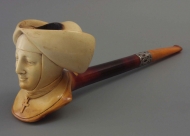
The appearance of this sturdy portrait pipe in meerschaum is really unusual. Overall, the pipe has a straight stemmed shape with a long tige and short amber mouthpiece. This is not common, because almost all meerschaum tobacco pipes were made with bent stems in those days. This curved shape says something about the friendly atmosphere that the smoker wanted to convey with his pipe. This unusual shape is much more austere and explicit in the smoker's silhouette. In addition, this pipe has an unusual representation. Depicted is a nun with a friendly and devout face and a beautiful folded hood on the head, a cross round her neck. The figure is serene in appearance, quite appropriate for a nun, but at the same time it is a large and robust pipe with a very dominant and explicit subject. Not unlikely, seen the shape of the pipe and the effect of the carving, this is a pipe made in a French workshop. A hypothesis that we may be able to answer someday with certainty, if more research has been done into the local pipe carvers.
Amsterdam Pipe Museum APM 19.903
PermalinkWith the gods at the table
août 2009
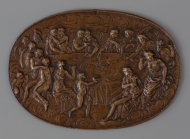
This beautiful bronze plaque certainly looks sixteenth century. However, that cannot be true because the people sitting around this table all smoke a long pipe. What is the case? It is based on a bronze plaque by Guglielmo della Porta who created various mythological representations around 1555 in a pure Renaissance style. Our artist based his scene on such a relief, on the understanding that he changed the subject and turned a banquet into a smoking gathering. He laid a bundle of fire on the centre of the table and provided all people with a straight stemmed tobacco pipe. What he meant by this ode to the smoking habit is unfortunately unclear. Certain is that it is a very early portrayal of a smoking company, possibly even before 1620 and that is what makes this plaque so special. The fact that it concerns reproductive art does of course diminish the artistic level of this so-called work of art, but the early date makes this plaque a great asset for a pipe museum. Mind you, it is the oldest image of a smoke company.
Amsterdam Pipe Museum APM 19.916
PermalinkAn amusing pig
juillet 2009
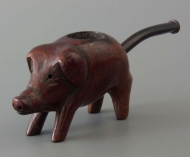
Original figural pipes in briar wood are not so common. When the briar industry comes up, the figurative era of the tobacco pipe is largely over. It is not surprising that the briar makers mainly focus on design they can make by using a machine driven lathe and not on decoration. Nevertheless, in the margin there is still a stream of curiosities, mostly supplementary to the market. This amusing standing pig is a wonderful example of this. Pontifically it stands with its legs on the ground and houses a tobacco bowl in the back. Just below the tail a caoutchouc stem has been set that shows a slight kink. The fact that the text "MODELE DEPOSE" is printed with a stamp indicates that the creator of the design expected a good turnover. However, the question is whether that has been achieved, this pipe design is nowadays quite rare.
Amsterdam Pipe Museum APM 19.840
PermalinkDrawing on a historical object
juin 2009
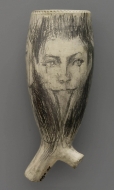
In 2009, visual artist and gifted draftsman Rodrigo Luff from Sydney visited Amsterdam and was inspired by Dutch painting. Armed with his sketchbook, he copied old masters in the Rijksmuseum and used his own inspiration based on historical compositions. His delicate miniature drawings are full of expression and were a reason to invite him to make such sketches on a Dutch pipe bowl. The fact that this happened precisely on a pipe bowl found in the cesspit of the Rembrandt House made the combination between old art and new interpretations even nicer. Flashing fast, Luff produced a miniature artwork with three portraits in the drawing manner of Rembrandt but coming from contemporary inspiration. His creation makes a link between the simple sketches that we sometimes find on historical pipe bowls, quickly drawn by a smoker, and real artworks with a delicate pen as Luff himself produces, (but which of course are also made by other artists) – maakt het onduidelijk.
Amsterdam Pipe Museum APM 20.080
PermalinkSpecial edition case
mai 2009
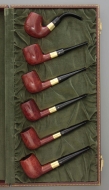
The 150st anniversary of the high-end pipe factory Comoy is the reason to release this remarkable cassette. In a wooden, leather-covered show box we find six briar tobacco pipes, all of the tried and tested classic shape. Particularly special is that they are mounted with an eighteen-carat gold band in stead of a silver one, which even more marks that it is an occasional edition. Out of the six pipes, five have a straight stem, only the top one is bent. In this way they reflect the sense of fashion of the pipe smoker from the 1970s, who had a strong preference for straight stemmed pipes, certainly when he chose classic English pipes. Of course, the sixth model was meant for use at variance, at less formal moments. 150 copies were made of this luxury case, say one for each year of the factory's existence. The show box is intended for the discerning customer who is able to buy his pipes per half dozen. Perhaps more common for that time than today, but only for the well-to-do pipe smoker. The shopkeeper who purchased such a cassette at the time without finding a customer for it, could sell the pipes separately in the end. After a few customers, the half-empty box no longer looked nice and will have disappeared to the attic. It is still an open question how many of these show boxes are completely preserved nowadays and how many of them still contain pipes in an unsmoked condition.
Amsterdam Pipe Museum APM 19.721
PermalinkPortrait pipe from Ruhla
avril 2009
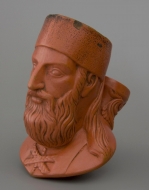
Not long ago, it was completely unknown where these brightly coloured pipe bowls came from. That lack of knowledge was marked by the use of the term terra incognita, which was used to indicate not only the unknown origin, but also the unknown material. We now know that the material was referred to as siderolith at the time and that such pipes were mainly produced in Ruhla, Thuringia in Germany. It must have been a considerable production that was born in the development of meerschaum pipes and pipes in imitation meerschaum. A special feature of these pipes is their hollow wall, which ensures that the smoke is cooled between the inner and outer bowl. The representations in these pipes are predominantly copies of pipes from French pipe factories. The portrait depicted, for example, represents Mehmet Ali, Viceroy of Egypt (1769-1849) and is inspired by a design by Louis Fiolet from Saint-Omer. The Gambier company later provided a very similar design that was brought under the name Omer Pacha. With these German variants, the size of the factories is proven by, among other things, the stamped shape number, for this pipe bowl mould number 151. We can still admire the strong red paint which is extremely durable
Amsterdam Pipe Museum APM 19.719
PermalinkGourd pipe with briar bowl insert
mars 2009
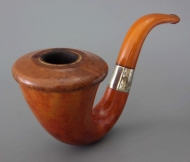
It is generally believed that Sherlock Holmes would have smoked from a gourd pipe. This specific type of pipe is characterized by an elegant, stongly bent funnel-shaped pipe bowl made from the calabash fruit. To obtain the perfect pipe shape, these fruits often grew in a wooden mould. A meerschaum bowl insert is later placed on the open top. The stem was originally made of amber, attached with a metal band. The pipe ran into a smooth line in the stem and it was precisely that line that made the gourd pipe so popular. The comfort of the pipe was that the meerschaum bowl insert absorbed the moisture, while in the generous space in the fruit the smoke cooled. Moisture could still be deposited there. Special about the depicted calabash pipe is that an insert of briar wood is used, which is again covered with a thin layer of meerschaum. Thanks to the silver marks on the stem ferrule, we know that the pipe was hall marked in Birmingham in 1912. With this the pipe dates from the high days of the calabash pipe. After the Second World War the calabash pipe becomes lighter and cheaper, then it is no longer common to use a real amber mouthpiece. An impoverishment in the product, which is as we know a characteristic for many objects.
Amsterdam Pipe Museum APM 19.516
PermalinkFemale nude under the moon
février 2009
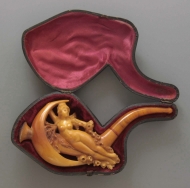
This meerschaum cigar holder is of interest in various respects. In addition to a beautiful patina and a good piece of carving, the subject in particular is remarkable. The portrayal of naked women was popular but not always unspoken. For the carvers it took a lot of craftsmanship to come up with an attractive result. As a matter of fact, that aspect has been successful here. The naked woman is depicted here in combination with the moon which probably refers to a well-known eighteenth-century chanson entitled Au clair de la lune. As we can see, the designer had to struggle with the final design. The standing woman and the moon fit well together in terms of shape, but for a proper connection from the cigar tip to the stem it was necessary to leave some meerschaum between the moon and the woman to allow the airflow to run through. This has led to a somewhat unclear zone in the depiction, consisting of a kind of tree trunk and some foliage that is not really functional in the scene. The pipe is mounted with a fairly strong bended amber stem that counterbalances the C-shape of the moon.
Amsterdam Pipe Museum APM 19.498
PermalinkQueu de Paris
janvier 2009
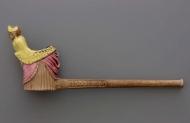
This pipe is a beautiful invention in terms of design. The bowl shows a standing woman, fashionably dressed in a pleated frock, a cloth draped over the shoulders. The posture of the person is that of an old woman slightly bent, precisely what makes the bowl easy to approach while tampering the pipe. No high-fashioned coquette is shown, that would be too flamboyant for a clay pipe smoker. Just the portrayal of an old woman makes this a pipe suitable for a unpretentious, aged man. On the stem the product bears the name of the maker, Jean-Jacques Knoedgen in Brée in Belgium. Yet he is not the inventor of this design. Knoegden bought the mould for this pipe from another manufacturer, who had engraved his factory name under the stem decoration. Knoedgen concealed this inscription with a simple relief, but if you look closely, you will recognize the shape of a name tag in these trivial motifs. From a preserved catalog we know that the Gisclon company in Lille had such a design in production. That could be the origin of this press mould. The enamel colours in yellow and pink are characteristic of Knoedgen in the old days.
Amsterdam Pipe Museum APM 19.458
PermalinkA portrait pipe for students
décembre 2008
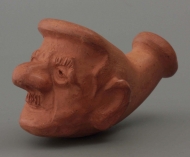
Shortly after the Second World War the well-known Parisian tobacconist Au-Caïd launched pipes for students who could expresse their social commitment. This portrait pipe, made by the ceramist Jerry, is a good example of this. Made in a limited edition, it represents the head of Edouard Herriot. Herriot was a radical politician from the Third Republic who has been Prime Minister three times. A special feature of this pipe bowl is the stylization of the portrait, but also the smooth manner in which the bowl turns into the stem. The fine terracotta colour of the new pipe has a light tint and will gradually turns to dark brown by using. The ceramist immortalized himself by scratching in his somewhat childish signature at the bottom. Unfortunately we do not know anything about the circulation, but it is certain that these pipes were only available for a few years. More than fifty years after launch they have are of great rarity.
Amsterdam Pipe Museum APM 19.448
PermalinkEgyptian portrait in parian ware
novembre 2008
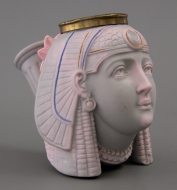
The first thing you notice about this stub stemmed pipe is its special colour. The pipe is made of the so-called Parian ware, a type of porcelain with a biscuit-like appearance, the colour of which can be changed from white to pink, blue or green by adding oxides. That colouring is done extremely well here, full of beautiful shades. Depicted is a fantasy figure inspired by the pharaoh masks but adapted to the fashion of the day in which the Art Nouveau style resounds. Those who wanted a real historical portrait had to resort to other pipe designs. That the maker mastered the porcelain in a playfull manner is also shown by the pink rosette behind the portrait. Only a few lines of colours were added. Porcelain is not a pleasant material for smoking. Not surprisingly, this product also uses a hollow-walled system, a space between the outer shape and the inner bowl where the smoke can cool. Parian pipes have clearly been fashion items. They were made in large numbers for a short period and exist in a series of different designs. Yet their production did not continue. In addition to getting out of fashion, they were too large in bowl and too explicit in shape for most smokers.
Amsterdam Pipe Museum APM 19.417
PermalinkA negro smoking cigarettes
octobre 2008
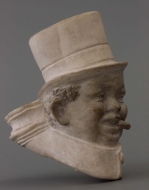
This portrait pipe shows a black man with a cigarette between his lips. The design is inspired by the Cigarette Johnson brand that was released in 1914. It was made by the sculptor-ceramist Rolland Coulon, working in Wasmuel in Belgian Hainaut. The negro with a top hat is well hit and fairly robust, on the other hand, the stem part looks somewhat primitive with circular rings. The portrayal gains a lot of expression because the face is lightly blackened, while the eyes have a somewhat bluish accent. At the bottom of the bust, the artist placed a few symbols. We see a bunch of tobacco leaves and a cigarette, furthermore an orbit with stars ending in a crescent moon. The last signs of course refer to the origin of the cigarette tobacco from Turkey and Egypt. It is unclear whether this item was an order from the cigarette brand or whether the item was designed independently and was intended for general sale.
Amsterdam Pipe Museum APM 19.418
PermalinkCigar holder as a vice
septembre 2008
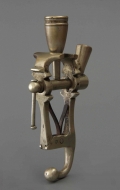
The second half of the nineteenth century is the time when the most remarkable cigar holders came into existence. The cigar is highly fashionable and many pipe smokers leave their traditional tobacco pipe and opt for the cigar. This pipe is a very special example of a cigar holder. It looks more like being made by an instrument maker than by a traditional pipe maker. The object has the appearance of a vice and does actually function. The tool has been made perfectly true to nature, including the springs that must keep the jaws of the screw open. The actual cigar holder is clamped between the jaws of the vice, the stem attachment is arranged on the cam of the crank of the screw. Thus the object became functional. Also pay attention to the tail of the vice, which normally stands on the floor to be able to hammer on the instrument. Here it has been given an elegant turn, of course to make the pipe more practical to handle. White metal was used as the material, an alloy between iron, nickel and perhaps zinc. We can’t say where such an object was made, but most likely it came about with an instrument maker, who was a fanatic cigar smoker and enjoyed creating it. Probably for his own use.
Amsterdam Pipe Museum APM 19.263
PermalinkA brass pipe from North Holland
août 2008
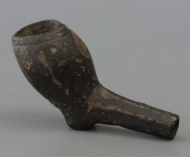
A great deal of research has been done into the clay pipe in recent decades. As a result, we are now able to correctly identify clay pipes and date them sharply. The is different with pipes from alternative materials that are as well used as smoking equipment. Metal is an underexposed group. That is why the discovery of this brass pipe bowl is important. The object shows all the characteristics of the clay pipe and can therefore be dated relatively sharply in the 1620s. In order to stay as close as possible to the example, it even shows a milling and on the heel a maker's mark. There we see a grid of filed lines. This product, by the way, is not a broken pipe, but a complete object that has been smoked with the help of a separate stem made of wood or other material. This prevented heat transport and gave the pipe an unexpected appearance. Furthermore, we must remember that when it was new, the object would have shined between brass and gold, nowadays it has been oxidized resulting in a dark green colour.
Amsterdam Pipe Museum APM 19.265
PermalinkAn unexpected image of the devil
juillet 2008
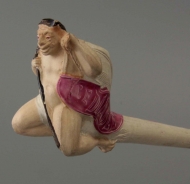
The Louis Fiolet company in Saint-Omer was a master in designing pipes and many products from its factory have a great deal of originality. This also applies to this figural pipe, the bowl showing a devil. But not an ordinary devil, of which only the portrait is depicted in the pipe bowl. This is a seated figure, depicted from the front and represented with a long staff and a text vane that can be seen over his left shoulder. The show is finished in two ways. First, a red-baking engobe has been used to tint the face and naked body of the devil. In addition, enamel paint has been applied in pink, white and black to make the appearance of the pipe more cheerful. A nice time document is the label glued onto the stem with "France" printed on it. This indication was mandatory for goods that were transported to the United States. They point to a date around 1890 and were stuck over the stamped brand marking to complete the brand. Soon afterwards the country of origin would be included in the stem intaglio.
Amsterdam Pipe Museum APM 19.273
PermalinkMill, farm and haystack
juin 2008
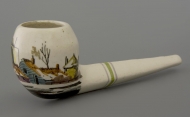
When a rubber scarcity arose during the First World War, the Gouda pipe factories ran into problems. Their successful ceramic pipes were sold with a caoutchouc stem but due to a lack of stems, orders were missed. In that period the pipes were changed and got a stem of clay. A simple solution but not a pleasant one. The glazed stem end was not comfortable between the teeth, it was too smooth and too hard. It is therefore not surprising that these pipes were only produced over a short period. When the war was over, they disappeared as quickly as they had come. This pipe is such an example, but it is also an example for something else. On the bowl it shows a painting of a landscape with a mill, farm and haystack. A picture more for the tourist than for the Dutchman and therefore in Holland never highly valued. How fully undeserved. If you look closely at these pipes, you will see how skilfully such pictures were painted. In a limited colour palette and with a minimum of lines, they suggested the complete landscape, in this case even a winter landscape. Such impressionist scenes demand for the painter much more than a little craftsmanship.
Amsterdam Pipe Museum APM 19.149
PermalinkGroom's pipe in wall cabinet
mai 2008
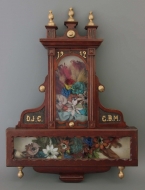
The habit of offering a groom's pipe during the wedding day was an important event, especially in the Dutch countryside. At the party that followed the official wedding, friends of the groom offered a nicely stitched up clay pipe. It was smoked for the first time during the wedding party. After the wedding the couple ordered a wall cabinet from the local carpenter that was hung in the best room as a reminder of the happy day. It was often common for the pipe to be smoked again on the anniversary of the wedding. This example comes from the Achterhoek and shows the bridal bouquet as well as the groom's pipe. That custom came into being at the end of the nineteenth century and remained in use until about 1930. At that time, many cabinets were made by a carpentry factory and therefore have the same appearance. However, this example is a one-off made by a local craftsman. Nice here is the carving on the frame mentioning the initials of the spouses and the year of marriage. The year of origin corresponds to the light art deco characteristics. Specifically here is that the numbers and letter are incised and that turned buttons are applied. These are the characteristics of a specific carpenter. That it is a kind of folk art is shown by the wood imitation painting of the cabinet that is reminiscent of mahogany but painted over simple pine.
Amsterdam Pipe Museum APM 19.207
PermalinkFrog on a leaf
avril 2008

Amusing and quaint at the same time is this clay tobacco pipe from the Gambier company. It is one of the few designs from that factory that displays an Art Nouveau style wich is surprising. The modern styles we usually do not find in clay pipes, that were mainly intended for the simple, more bourgeois smoker. With this design, however, Gambier has gone beyond all limits and achieved a figuration that was unparalleled. A pipe only suitable for a flamboyant smoker who has the right flair to amaze his circles with an extreme smoking pipe. The stem of this pipe is an elongated leaf, the pipe bowl is formed by snail that is carried on the back of a frog sitting in the middle of that leaf. It is not the details that make the pipe, but the fuzzy manner in which the figures are modeled. The factory brand also fits in. sharp stamps with the factory name and place of origin on the stem as usually done, would stand out against the over-all design. So, only very subtly the word Gambier is printed in writing on the underside of the leaf. As systematic as the factory was organized, a shape number was included on the stem to facilitate ordering.
Amsterdam Pipe Museum APM 19.135
PermalinkTobacco cultivation in Amerongen
mars 2008
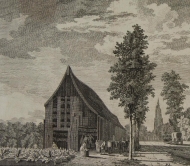
This beautiful topographical image is made in the area of Amerongen, shows the cultivation of tobacco. Particularly characteristic are the high barns, in which the harvested tobacco leaves hung on sticks to dry. For an optimal drying process, valves were fitted in the outside wall of the shed, which could be opened to intensify the air flow. This way, the drying of the tobacco leaves was provoked. A real tobacco field can be seen on the left in front of the high barn, the crop planted in rows. The fact that the plants there are not yet very high could have been caused by the sand gournds of Utrecht that was far less suitable for the tobacco cultivation as was the West-Indies. The road that takes our view into the distance where the farmers bring their cart loads of tobacco leaves is a nice Dutch scene. In short, the print is an instructive picture for a disappeared culture. The engraver is Paulus van Liender, who cut this illutration into the copper plate in 1759.
Amsterdam Pipe Museum APM 19.116
PermalinkBloody hunting scene
février 2008
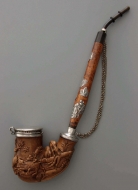
A gorgeous hunting scene has been carved around this wooden pipe bowl, displaying a pack of dogs with the tongue out of the mouth attacking a boar, a deer and a bear. In the stem corner, always a somewhat difficult place for decoration, we see two animals that bite each other in the tail or in the flank. The representation is very swirling around the pipe bowl, but the charm of the object is mainly defined by the fine carving. This is not an over-decorated piece in horror vacui, but it is in fact the unadorned background that brings power into the scene. In addition, the shape of the pipe is perfect, balancing between a bag shape and the higher Hungarian. It is difficult to trace the origin of such pipes, but if the stem with the silver fittings is a genuine part of this object, the city of Ulm must be the place of manufacture.
Amsterdam Pipe Museum APM 19.092
PermalinkNapoleon on horseback
janvier 2008
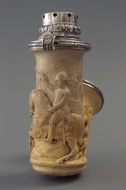
Tobacco pipes with a decoration related to Napoleon were made by the thousands. Napoleon appealed to the French imagination, but he also enjoyed great respect in Germany. This high, so-called Hungarian pipe bowl shows on the front a heroic Napoleon on horseback, the sword raised. Not a representation of a specific battle, but a general heroic scene. The date of this pipe is not to be determined by the main depiction but by the side of the stem, where some ornamentation with volutes in Louis XVI style have been applied which points to the 1840s. The hall mark on the silver mounting accounts for the year 1844. The maker is Heinrich Schilling, a Viennese workplace for meerschaum pipes. Even the silversmith is known by name, a man named Gross who, incidentally, specialized in pipe mountings, a lucrative activity in Vienna at that time.
Amsterdam Pipe Museum APM 19.100
PermalinkWoman with woman syringe
décembre 2007
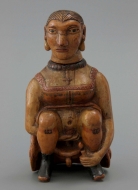
A wonderful show can be seen here. This wooden pipe bowl represents a squatted woman, which in a simple way, sitting on a pisspot using a woman's syringe. The woman's head acts as a lid for the pipe bowl and is removable. Also note the stem, which consists of a duck's head, whose beak pecks in the woman's back. Clearly there is a naive portrayal carved in a not very flexible style but therefore extremely moving. See also how her hairs are trapped in a hairnet giving her very common looks. Her clothing is just as simple and a necklace with a Christian cross as a pendant disclose a catholic background. The soft wood is finished with a lacquer, after some colour accents have been applied on spots. The signature S. Sidaine is written under the hem of the skirt in beautifully lettered red script, more of a French than a Scandinavian name. Nothing is known about the origin of this remarkable pipe. Although found in the antique trade in Copenhagen, the makers name is more French, while such white wooden pipes are more characteristic of the southern Balkan countries. In short, we are still completely in the dark about the origin. It is even more difficult to figure out who could have been the smoker of this pipe.
Amsterdam Pipe Museum APM 19.054
PermalinkA Gambier advertising tile
novembre 2007
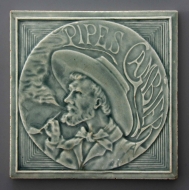
In the 1890s, the Gambier factory was expanding with a new branch. In addition to refractory earthenware, wall tiles made of pressed clay came into production, on the visible side provided with an under glaze decoration. It turned out to be a successful article with which a good turnover was achieved for around twenty years. Not surprising that promotional material was made for the promotion of this tile industry. For instance a large red-glazed tile dedicated to the Carreaux Gambier. For the pipe industry, a counterpart was designed, a green-tinted tile fitted with Pipes Gambier with the image of a smoking man under a wide-brimmed hat, a short clay pipe in his hand, gently blowing clouds of smoke. The representation is placed in a circle, the corners are filled in with simple lines. Especially in the letters we recognize art nouveau influences. Interesting is also the back of the tile, where in addition to a roughening of blocks and stripes for better adhesion in the wall, there is a mark. Central is the initial mark JG, which is still important at that time, although a radiant sun has been placed between them. During that period this mark was used as well for briar pipes. Along the edge of the brand name we read the words Givet and Paris, respectively the production site and the city where the trading office was located. It is still unclear for whom this tile was intended: a promotional gift for customers or an item for sale, although the target group is unclear in the latter case.
Amsterdam Pipe Museum APM 19.007
PermalinkName pipe for a German farmer
octobre 2007
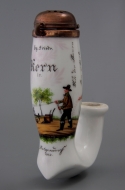
This type of porcelain pipe bowl is a the so-called bag stummel. A bag shaped reservoir is moulded to the oval pipe bowl where the moisture collects. Such designs have been a variant of the normal oval stummel and the haydays are the mid-nineteenth century. The pipe with the reservoir is fairly common in the 1840s. They are painted in commission and generally carry fairly elitist representations such as a family crest or special inscription for students. This pipe bowl dates from 1862 and is painted in a folk aft style, intended for a new, lower target group. This points to the gradual decline in status of this object. This is a name pipe dedicated to country life. We see a farmer behind a plow with behind him a woman sowing. At the back a saying about plowing, not very understandable, is written. Because of the theme of the scene you could classify the pipe in the category with professions. The reason for making this pipe is not mentioned, it can be an anniversary gift or a present for reaching a certain age. Sometimes such a theme is written onto the pipe bowl, but in this case it is not.
Amsterdam Pipe Museum APM 18.991
PermalinkPasha with lid
septembre 2007
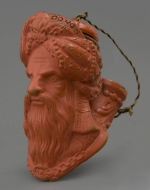
The design of this pipe bowl comes from the Gambier factory in Givet. It was produced in two sizes, a normal pipe bowl and a large size, the latter primarily intended as a presentation piece. Both pipe bowls are almost identical, although only the large version has a sater head with a grapevine at the bottom of the bust. However, the red-painted pipe bowl shown here was not made by Gambier, but came from a competing company in Ruhla in Thuringia, Germany. It is not a copy in the sense of a cast, but a new modeling with some altered details. Although this bowl is practically the same as the small version of Gambier, this version has the sater head of the large version on the bottom. This portrait head is also enclosed by a grapevine although a wonderfully large leaf has been applied to the top that does not occur with the original. The shape number 43 is pressed on the stem in intaglio. A variant from Ruhla is a fraction larger and shows shape number 172, while in the same city also the large version of Gambier was copied, even including their mark stamp JG. Particular for the Thuringian versions is that they were often sold with an earthenware lid that was attached to the pipe bowl with a thread or chain. That lid was more curious than functional, because it didn’t hold. Such a lid usually got broken quickly.
Amsterdam Pipe Museum APM 18.842
PermalinkPress mould for a cafe pipe
août 2007
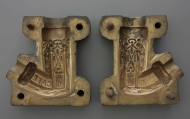
The cafe pipe of Kaffeehauspfeife is a special pipe design that became popular in Austria in particular, but is widely smoked throughout the German-speaking area. Characteristic is a high hexagonal bowl, often decorated with relief representations related to tavern life. The truncated stem has a cuff in which a long cherry wood stem is mounted. Cafe pipes were sold standard in boxes of six bowls. The idea behind it was that people had to smoke from a clean pipe bowl and had to replace it regularly, using the same stem. The production of cafe pipes has never taken place in the Netherlands, it is primarily a German activity. This mould is intended for the manufacture of such cafe pipes and comes from a pipe factory in the German Westerwald. The last user is Theodor Tries from Baumbach, but before him there was another owner as witnessed by the erased marks in the stem of the press mould. It is mainly the outer shape, the so-called mould box, that betrays the origin of a press mould. Gouda press moulds, but also Belgian and French ones, show a greater elegance in their outer form. In Germany, the exterior is much more tough and robust. The later moulds in particular were made suitable for clamping in a semi-machine production unit.
Amsterdam Pipe Museum APM 18.968
PermalinkFashionable stem
juillet 2007
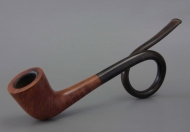
The shape of the stem of this pipe is very unconventional. It is a reading pipe with an extra long stem that has been turned into an elegant curl. Sold as Lorenzo Postillon, this pipe does indeed give the impression of a post horn. Lorenzo is an Italian factory with its own design line and especially a particular way of finishing. The pipes are characterized by something pure, often somewhat larger and heavier, and usually in a mat finish with a light orange-brown hue. This pipe meets this in all respects, although it is more modest in design than we are used to with this maker. It is clearly a fashion item from the end of the 1960s. At that time the reading pipe was once again brought to the attention but now labeled as a television pipe. It became a short-lived quirk that didn't really catch on with the pipe smoker. That certainly applied to the special stem shapes of which this is the most extreme, in addition to a comparable model that could stand upright and had an S-shaped stem. A few years later the shopkeeper showed again reading pipes and these dated, joyous objects were never seen again. Nice to know that the consumer price in that period was between twenty and thirty guilders. A price that now makes us smile.
Amsterdam Pipe Museum APM 18.717
PermalinkGrotesque portrait with hunting scene
juin 2007
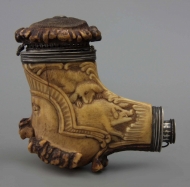
This remarkable pipe bowl with a grotesque face is made from deer antlers. This tough material is not easy to work with, but it also sets its limitations. The bark-like exterior requires great inventiveness from the carver to suitably incorporate it into the decoration. Not surprising that people cut that barky surface away and started with the bare antlers. In the nineteenth century it became customary to include the grainy structure in the decoration. With this pipe, the maker succeeded exceptionally well, although the result is somewhat bizarre to us. On the front of the pipe bowl the face of a human being emerges, the coronet of the antlers is used to form the nose and mustache. On the other side, facing the smoker, we see a hunting scene with on one side a wild boar attacked by a hunting dog, the other side two deer, again with a hunting dog. This creates a considerable difference between the visible side and the side that the smoker faces, the bizarre versus the depiction of the exciting moments of the hunt. This contrast perhaps fits with the pipe smoker, being somewhat introvert, who keeps the world at bay with such a bizarre mask and wants to stay in the atmosphere of hunting with a view of the hunting scene for himself.
Amsterdam Pipe Museum APM 18.764
PermalinkStandardization of the briar pipe
mai 2007

When we talk about modern wooden pipes made from briar wood, it seems like a twentieth-century product. Those who do more research, however, will discover that also in the second half of the nineteenth century huge numbers of briars left the factories in Saint-Claude and other places. The artifact shown here proves that a great standardized production of pipes already took place around 1900. After the pipe shape had been designed, a mould plate was made in zinc, which was used to set up the machine. This was also used as a control during production to ensure standardization. A turned pipe had to fit exactly in the metal gap. The two circular holes were used to control the stem diameter. Stringed together are two stages of the pipe and a plug to even check the inner bowldiameter. Finally, there is a para rubber mouthpiece that was specifically designed for this pipe. Thanks to a miraculous coincidence, several copies of such plates, or even complete sets, have been preserved that give us an idea of the working method in the factory but also of the shape development within the high degree of standardization. The shape shown, a Dublin bowl with a heel, was originally a clay pipe that was often executed in meerschaum at the end of the nineteenth century. It is remarkable that examples of this rather popular pipe shape executed in briar are hardly preserved. They were literally burnt by the smokers.
Amsterdam Pipe Museum APM 18.677
PermalinkA bizarre freehand
avril 2007
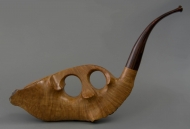
The career of Pierre Morel junior from Saint Claude is as varied as his products. Morel is the son of the pipe maker Pierre Morel senior. Already as a ten-year-old boy, he assisted in his father's studio, but subsequently worked for years alternately independently or in the service of other companies. He visited Denmark where he was employed by the Larsen company. Back in his own home town, he worked for Chacom, among others. His oeuvre is exceptionally divers, although Morel specializes in giants and bizarre freehands. He learned how to make unique pieces, entirely made by hand, from his father who introduced them to Saint-Claude. Morel continues that tradition in which he creates every pipe acoording to the material, without making a design drawing beforehand. The tobacco pipe from Morel shown here is characteristic of his freehands category. A whimsically shaped pipe has been created from a disk plateau bruyère. The fleuron of the briar runs along the lower edge of the pipe and is accentuated with dark stain. A beautiful flame grain is visible on both sides of the pipe. Along the top of the pipe, a briar standing ridge has been pierced with finger holes in two places. Some modest sculptual volutes have been applied around these openings. Morels’ favorite mouthpieces of cumberland is used with this pipe as well.
Amsterdam Pipe Museum APM 18.604
PermalinkA cafe pipe from France
mars 2007
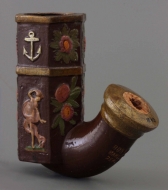
This café pipe is beautifully executed and thus goes beyond the copies from the German Westerwald, made by millions there. The bowl of this pipe is a fraction smaller and sharp in modelé. On each of the six sides around the bowl two images have been made. Instead of the usual tavern motifs such as the symbols from the card game, a mug, cones or billiard balls, in this case flowers and two dancing figures can be seen. The engraving of this work is also much finer and less obtrusive than with the German counterparts and that makes this object a highlight. Finally, this pipe bowl is not made of the common white backing clay, but made of brown clay. After baking, the relief work was painted and then the pipe was covered with transparent varnish. The horizontal bands were furthermore accentuated with bronze paint, which resembles the much more chic gold. That finish was the most luxurious that the smoker could get at the time, of course due to the labor-intensive painting of the pipe. The maker is the Bonnaud company from Marseille, which stamped its factory name on the underside of the stem.
Amsterdam Pipe Museum APM 18.413
PermalinkA Bacchant as a table pipe
février 2007
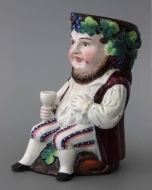
This tobacco pipe, intended to be placed on the table and to smoke with a flexible hose, is one of the most out of the ordinary pipes. It is made of porcelain and shows a impressive multi-coloured painting. A Bacchant is seated with a wineglass in hand, around his convex head is a vine. With its open jerkin, three-quarter pants with stripes and a ring beard under the chin, it has a pleasant, but at the same time very common appearance. Although such objects are referred to as Porcelaine de Paris, in this case that is wishful thinking. In the nineteenth century, the French factories, lead by the extremely gifted maître porcelainier Jacob Petit, devised beautiful porcelain objects. They are characterized by a colourful painting, but the shard of that material was much more refined than with this heavy-duty table pipe. In addition, the palette was not that intense. It is not yet known where this pipe was made, although German origin is more likely. Yet in the time of its creation, this was a luxury item with an unusual appearance. Only the motivated pipe smoker would be tempted to purchase, at least if he was in for a curiosity. The serious smoker rather sought a more comfortable tobacco pipe. It is therefore not surprising that so far only two copies are known.
Amsterdam Pipe Museum APM 18.400
PermalinkA Japanese smoking set
janvier 2007
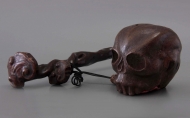
This somewhat rustic smoking set that consists of a tobacco box or tonkotsu, together with a pipe holder or kiseruzutsu is remarkable in its kind. It is an article characteristic of the Japanese smoker from the time that a kimono with a belt was worn. This object hung between that belt. The tobacco box has the shape of a rather naturalistic human skull with a coarse denture, a macabre picture. The box opens at the bottom with a freakishly shaped lid that is covered with red lacquer. The accompanying pipe holder is rustic and looks like a rough branch with a disc at the end. The design hangs between a piece of natural stag horn and a mushroom. To get a nice even colour this kiseruzutsu is covered with brown lacquer. This object emphasizes the whimsical design of nature. Both objects are held together with a cord and attached to it is a so-called ojime, a closing bead or sliding bead. This bead is cut from a fruit seed and displays a rocky landscape with plants, with a figure in an openwork area. The carver also applied his signature in the form of three Japanese characters placed below each other. Between the flat rectangular leather tobacco bags and the tubular pipe holders that are the most common, this object is one of the more surprising examples.
Amsterdam Pipe Museum APM 18.374
PermalinkJapanese style vesta box
décembre 2006
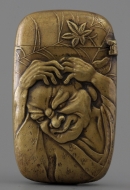
This beautiful, small object was used by the smoker for storing his matches. It is a so-called vesta box, named after Vesta the Roman goddess of fire. The short wax matches had to be kept dry and for that purpose a box with a good closing system was needed. On the inside of the hinge we find a kind of clamping spring to keep the box closed. Such boxes were extremely popular between 1890 and 1920 and were produced in large numbers in an infinite variety. Characteristic of the vesta boxes is the slot provided with grooves that are usually placed on the underside. This part is meant to strike the match. With this box, however, there is a simpler roughened zone, which is placed on the curve of the box. They are real pocket boxes and some vestas even have a ring to wear on a watch chain. An attractive feature of this mechanically printed box is the beautiful representation that has been applied on both sides, inspired by portraits of Japanese actors. Thanks to the tint of the brass, this almost resembles an exclusive lacquer decoration.
Amsterdam Pipe Museum APM 18.359
PermalinkTobacco pipe with curl
novembre 2006
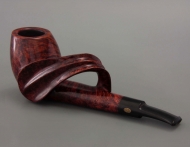
Some briar pipes are so prestigious that the functionality is put on the second plan. In my opinion, the same goes for this design by Horry Jemeson, who worked at GBD factory for many years. He is considered to be one of the greatest pipe makers of all time on the basis of the uniqueness of his designs and their perfect execution. This pipe is a spectacular example from his hand. It is a beautifully shaped briar with a large bowl and straight stem with saddle mouthpiece. This perfectly balanced shape has elegantly retained a bow from the original ebauchon, which springs from the stem and ends with a beautiful arc at the base of the bowl. The visible side of that bow has two longitudinal millings. An addition without functionality, unless as a smoker you pinch your fingers through the loop, because then the pipe rests certainly better in the hand. Yet this design is so exciting that viewed from whichever side it always looks different. The GDB factory has been a prestigious company, from the time of its creation as a meerschaum factory in Paris to the English period, with production taking place in London. Their elitist history and prominent locations are emphasized by the elegant packaging box of the pipe: "Famous since 1850" and "London made" are two commendations printed in gold, pontifically on the inside of the lid. In addition to the brass plate that is inserted into the mouthpiece, the pipe is stamped on the stem with the same mark including "UNIQUE" to underline that this pipe is a one-off. The GBD factory apparently did not consider mentioning who the designer was.
Amsterdam Pipe Museum APM 18.331
PermalinkHand with pipe
octobre 2006
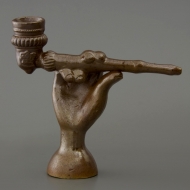
This pipe is a wonderful object between an ordinary consumer item and a sculpture. Horizontally we see a simple clay pipe with a straight stem. The pipe bowl is decorated with a geometric border along the bowl opening, a thick band of rolls and a crown on either side of it. The clay pipe is held by a human hand, loosely with two fingers on and two fingers under the stem. Downwards this hand turns into an oval-shaped cuff that broadens into a simple pedestal. A curious pipe, therefore, and rather a showpiece than a smoker’s utensil, although the pipe can certainly be smoked. The object was pressed in a two-part mould and covered with a brown salt glaze after a biscuit fire. This kind of pipe goes by for Wieldon ware, named after a famous ceramist. As so often, that is an indication for the collector, because it is highly questionable whether the brilliant potter Thomas Wieldon has had anything to do with this object. Rather, it will be stoneware from a London factory or from another English production site where this brown glazed good was made en masse. The collective name London saltglazed might therefore be a better designation.
Amsterdam Pipe Museum APM 18.097
PermalinkMephisto cigar holder
septembre 2006
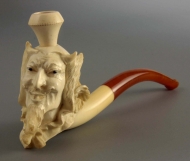
This expressive cigar holder portrays the head of the demon Mephistopheles as the literature and the theater world often depicts him. A man's portrait with a narrow, skinny face with a mustache and long goatee, two horns on the forehead. His skull is covered with a fur-lined executioner hood with some playful feathers on the left. Special about this pipe is the insert with glass paste eyes, which make the portrait a lot more expressive. Mephistopheles has been depicted more often over time, but by the end of the nineteenth century this design was the most popular. The pipe aimed at a more literary target group, the well-read smoker who at least read Goethe's Mefisto. The simple version of such a pipe could also have been chosen by a more bourgeois person, judging that it represents just a devil which is of course another interpretation. This beautiful pipe is in sublime condition because it has never been smoked. The pipe is still in its original case, marked on the inside in gold leaf with "CROWN PIPE", including the initials of the maker or seller. The addition "VIENNA MADE" does not guarantee that the pipe has actually been carved in Vienna, although the quality is such that it is very well possible.
Amsterdam Pipe Museum APM 18.057
PermalinkMore graceless is not possible
août 2006
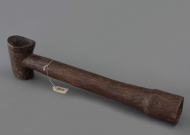
The Mangbetu, a people living in Congo, is responsible for this tobacco pipe and it is without a doubt the least elegant pipe from the collection of the Amsterdam Pipe Museum. The object is made of insignificant tree wood, the straight stem and the thickened mouthpiece being the best parts. There the wood is relatively well straightened and the shape still shows a certain elegance. The bowl, on the other hand, springs from this stem like a hammer head and is completely shapeless. Here the carving, which goes against the grain, is also downright choppy and uneven. Moreover, this bowl is too small for the large thickness of the stem. Apparently the maker did not feel the need to smoothen his product in order to improve the shape. The soft wood has been burned on the inside, although this does not indicate intensive use given the soft nature of the wood. Yet this shapeless object is a perfect example that a tobacco pipe does not always/necessarily have to be an expression of fine craftsmanship. That this object has been preserved is due to the fact that this pipe was retained in a monastic collection for decades, making it now a rarity. It is the poor counterpart of a comparable but much larger pipe in our collection that is well designed.
Amsterdam Pipe Museum APM 18.013
PermalinkGrotesque pipe with clown heads
juillet 2006
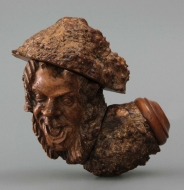
This pipe bowl is made from rough briar root, the unique structure of the bark is still visible. Such a texture is also called bois brulé in the antique trade, but in fact that is not a good indication because the wood structure has not become so by burning. Three root tubers have been used to make this pipe, each of them have retained their rustic appearance. Two clown faces are carved on the sides of the largest, which forms the pipe bowl. Cleverly done, they display almost the same whimsical structure as the bark of the root itself. Both portraits are extraordinarily expressive and suggest the cheerfulness that a clown's face could create. The pipe stem is made from a second root tuber and is provided with a twisted smooth cuff. What makes the pipe so complete is the lid of a third piece of root, sawn flat on one side and with an air hole in the central point. It is difficult to say where such folk art was made, although it seems to be a French merit. Especially in France such grotesque folk art enjoys great popularity.
Amsterdam Pipe Museum APM 18.000
PermalinkA chiboucq in meerschaum
juin 2006
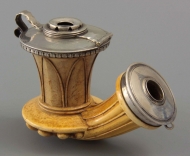
The chiboucq, a funnel-shaped pipe bowl placed on a saucer shape, is a typical Turkish invention. Such pipes were developed in the eighteenth century and remained popular throughout the nineteenth century. Originally it was an invention in ceramic that was soon copied in other materials. Such a counterpart in meerschaum we see here. The shape of the chiboucq has been copied exactly, although the decoration is adapted to the West European taste. Contoured pointed windows have been added around the bowl to create the atmosphere of neo-Gothicism. The dish is provided with lobes on the underside, while the stem of the pipe is fluted along the length. In this way a striking form of serene decoration is provided with a beautiful overl-all design as a result. Finally, the pipe is mounted with a silver hinged cover and a cuff ring with a locking eye. The hinged cover is atypical. This is because the bowl capacity of this pipe is relatively small, while the wall is thick, especially at the wider top. Therefore, the only option was a broad silver bowl ring with a surprisingly small lid. In the middle, this lid has a very large air inlet, extremely contrasting. Elegant is the clamping spring that runs over the wide bowl rim with a bow and secures the lid there. it is difficult to determine where such pipes were made. In this case it seems to be a Hungarian product, but new insights into the meerschaum production can easily change this attribution.
Amsterdam Pipe Museum APM 18.009
PermalinkRepresentative case
mai 2006
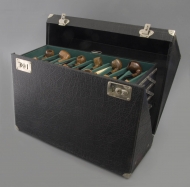
This attractive handmade case was used by the representative of the Gubbels pipe factory in Roermond. It is a wooden case covered with black artificial leather that, when you open the buckles shows six drawers, each with oblique compartments for a dozen briar pipes. At the bottom is another compartment that is higher for storing pipe bags, boxes or other items. What makes the suitcase so ingenious is that when the lid is opened it folds down to the floor and then the whole series of drawers can be pulled out, resting on the lid like a wide fan. This way the entire assortment of six dozen or 72 pipes stored in the case is displayed in one go. With such a case, representatives visited the tobacconists' shops to promote their pipes. Nice enough, not only has the case been preserved, it still retains the selection of the factory that belongs to it. This selection shows the variation of products over a period of more than thirty years and thus forms the memory of the pipe factory of our Royal Gubbels. even more special is that all pipes are still unsmoked, showing how impressive such a representative case looked at the time.
Amsterdam Pipe Museum APM 17.900
PermalinkDutch painting on a pipe
avril 2006
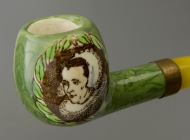
The ceramic pipe as developed by the Gouda factories between the two world wars gradually became souvenir items. It was soon discovered that an appropriate tourist painting or transfer gave enhanced the sales. In addition, souvenir painting became an important item for export. The Holland pipe became a coveted article in America but also in other countries. A special design is this multi-coloured pipe, which shows details of two paintings by the Haarlem painter Frans Hals on the bowl. One side shows the cheerful drinker, the portrait on the other most closely resembles one of the woman regents of the Haarlem Elderly home. Both portraits are placed in a leaf wreath. The remaining part of the ceramic is filled with stylized leaf work with the inscription Holland on the underside of the stem. The pipe was then washed green. The design for these pipes, which is in keeping with the swirling style of Frans Hals, was done by Willem van Norden, the versatile designer of the Royal Goedewaagen. However, sticking the colourful transfers and then painting in turned out to be a time-consuming affair resulting in a sales price of these pipes that was in fact too high. As a result production was limited and only a few were sold.
Amsterdam Pipe Museum APM 17.775
PermalinkElegant lady with fan
mars 2006
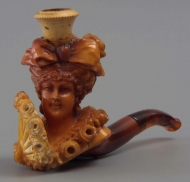
Between 1880 and 1920 they were cut by thousands, the cigar holders with images of elegant ladies. Among gentlemen or those who pretended to be they were meant to please and impress. In a leather covered wooden case with fabric inside, they were taken to visits to demonstrate well-being and good taste, sometimes they also served as a conversation piece. This pipe shows such an elegant lady with upset hair with a large bow flanked by rose buds. The trumpet-shaped holder for the cigar is placed precisely at that location. Her bust shows a collar with blooming roses on the edge. She partially shields her face with a fan with the same rose buds on the edge. However, if you look hastily, you now think that her robe goes on in a unexpected stand-up collar that makes it a bit akward element in the depiction. Such pipes are carved in large numbers, but because the handwork and the pieces of raw meerschaum always being differed in size and shape, they show different details. These types of holders were mounted with a transparent mouthpiece made of imitation amber, presumably celluloid. The beautiful orange-like colour of the meerschaum was obtained through frequent smoking.
Amsterdam Pipe Museum APM 17.742
PermalinkA seven bowled pipe
février 2006
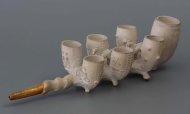
In England at the end of the nineteenth century the multi-bowled pipe came up as a trinket. They were sold as a curio. Although some seriously smoked multi-headed pipes have been preserved, most of them were ornamental objects. They figured in a pipe collection as the ultimate piece, but also as a presentation pipe in the tobacconist's shop. They are also said to have been used as a game in the pub to drink them when filled with liquor. Whoever tries, will soon discover that it is not that simple and that was of course the joke. There will be countless casualties in such game. Nevertheless, several copies have been preserved, such as the one shown here. It is clearly a serial article but a serious piece of pipe maker craftsmanship. The pipe in the center has a large curved bowl and a thicker stem. It was precisely on this thicker stem that three smaller pipe bowls each side could be mounted on either side, which of course were connected to the central bore that led to the mouthpiece. Various decorative clay pipes have been used for these added bowls, which run very subtly on both sides from large to small. The somewhat messy zone in between, where the stems were attached, was adorned with two walking horses that were cut off from the stems of ornate pipes.A show piece like this required one complete pipe, six decorated bowls and two stems of figural pipes. It is not impossible that the stem of the main pipe was extended to give the object a better proportion. At this pipe, a twist was made in the last stem piece, which indicates a great deal of care during manufacture.Being typical English the pipe culdn’t do without a lacquered mouthpiece.
Amsterdam Pipe Museum APM 17.730
PermalinkCatalog of a meerschaum manufacturer
janvier 2006
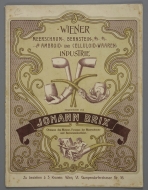
The manufacturer's catalog is an extremely important source of information on the development of the pipe over time. In the catalog, the manufacturer shows his assortment as a plain list of shapes and types available at that moment, usually without comment. For us now, this gives a great insight into fashion and its process of change. This catalog, published by Johann Brix from Vienna, introduces us to the world of the meerschaum pipes at the turn of the for-last century. The catalog shows 376 pipes and six pipe stems on 21 pages. Only 68 pipes out of that offer are intended for tobacco, two are water pipes and all others are meant as cigar holders. This shows that during that period the meerschaum tobacco pipe was strongly pushed into the background by the cigar holder. The latter article, as a matter of fact, has become very ordinary. Pretty ladies' busts, single horses or pairs, dogs and other animal figures are shown. From the catalogue it is clear that Brix was a manufacturer of luxury serial work, a fashion that had become so plain-vanilla that we could no longer find any spectacular uncia’s. In addition to this decorated item, the simple cigarette tip has become commonplace. The choice was very wide. The tobacco pipes are shown at the very back of the catalog, clearly a sign of their decreasing popularity. The choise in sizable tobacco pipes is then limited to the fashionable egg bowl or the traditional high Hungarian. The hinged covers with which these pipes are mounted display simplicity, fitting in with the bourgeois and common nature of the Brix range. In addition to this old-fashioned ware, a few cased pipes have new bowl shapes such as the Dublin and the billiard. They represent the fashionable element and are intended for the more sophisticated smoker. It is clear that Brix served a specific market segment, but it also appears that around the year 1900 the taste of the meerschaum pipe wasmostly conventional and popular.
Amsterdam Pipe Museum APM 21.273
PermalinkHopewell effigy pipe
décembre 2005
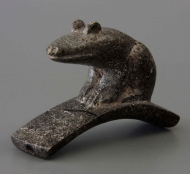
In the 1840s the Hopewell culture was discovered during excavations in the state of Ohio, where two large complexes of pipes were found that show specific characteristics. Typical are figurative representations in which the bowl of the pipe is hidden and that are placed on a kind of platform, usually with a slight bow or bend that functions as a short stem. The pipes are carved from a local type of stone that is more fragile than you would expect. The illustrated pipe with a bowl shaped as a sitting frog is a representative example of the Hopwell pipe. The silhouette of the pipe has the mystical appearance characteristic of this culture. In addition, the stylization of the frog with its convex eyes is very well done and shows great ability in abstraction. The Hopewell culture flourished between 200 BC and 500 in the forest area of eastern America. However unexpected the design of the pipes might be, members of the tribe themselves were worldly-minded, for they maintained contacts with many other ethnic tribes, almost from the east coast to the west coast of America. The Hopewell designation also refers to a way of life to be found in various local American Indian tribes. The most characteristic of this culture is the construction of earthen walls and mountains in specific forms. That is why these people are also called Moundbuilders.
Amsterdam Pipe Museum APM 17.639
PermalinkShop advertising for Gambier
novembre 2005
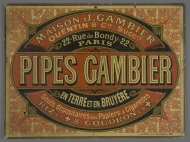
Pipe factories of fame and reputation already had advertising material designed in the nineteenth century to increase their brand awareness among consumers. Store cards, printed cardboard cards have been an important medium in this regard. These are usually rectangular cards that have a hanging hole along the top edge. They were hung on a nail in the tobacconist's shop to encourage sales. This card is issued by the Gambier company and advertises their products. In addition to brand awareness for the clay pipe, the original product of the firm, the briar pipe is also mentioned which, although not produced by Gambier, is traded. Gambier took up this representation of related products in order to broaden the offer for the cigar shopkeeper and thus stimulate sales. Another article also contributed to this, namely cigarette rolling paper, the two main brands of La Croix being represented by Gambier. The design of the store card is unexpectedly plain. The texts are in a horizontal oval with the most crisp "PIPES GAMBIER" at the center. The corners of the field are filledd in with geometrically arranged vine leaves. The ivory-white background is printed with red and black, highlighted with gold here and there. Along the lower right edge we read the printer's signature. All-in-all a rare piece of nineteenth century advertising.
Amsterdam Pipe Museum APM 17.637
PermalinkPortrait of a cheerful singer
octobre 2005
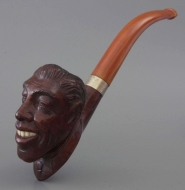
The craze for the portrait pipe is during the nineteenth century. After the First World War, the tobacco pipe is hardly a conversation piece shown to express your personal interest. It is therefore not surprising that only a limited number of examples are known from the twentieth century. This specimen is a wonderful exception. The smiling figure portrays Fernandel, the famous comedian who broke through in the late 1920s and faced a long career. In addition to performances in theaters, he is known for countless shots of filming. His very recognizable broad grin and mouth full of teeth became his trademark. For a pipe maker of course an ideal feature to make his portait pipe easy to identify. With this pipe the likeness was especially successful because its striking teeth are made of ivory and therefore contrasts fantastically with the warm tint of the wood. The maker signed the pipe on the tige, the wooden stem piece, with his name: M. Pech, but unfortunately this name is not known from historical sources. As a result of the wonderful craftsmanship, this successful portrait pipe must date from the thirties, although the popularity of Fernandel extended well after his death in 1971.
Amsterdam Pipe Museum APM 17.619
PermalinkStylized bird's head
septembre 2005
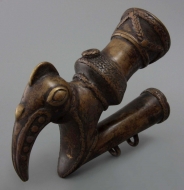
This pipe is made by the Bamum tribe in Cameroon in the cire perdue technique or the lost wax method. The design is first modeled in beeswax. This is then packaged in clay and when heated, the clay hardens while the wax runs away. This creates a simple mould, the hollow spaces of which are filled with bronze. Once this bronze has hardened, the clay lump is smashed and the object appears. Often the bronze still needs to be polished and filled in because of some castings failures or defects. With this wondrous pipe bowl built from geometric shapes, the constricted bowlis dominated by the hook-shaped stylized bird's head. It is said that the turaco bird is depicted, an African fruit-eating bird. This was done in the typical manner of the Grassland artist by reinforcing the animal's characteristics through stylization. A pity of course that the colourful feathers of these birds could not be displayed. The constricted pipe bowl is simply decorated with a few raised geometric bands. Finally, a double locking eye can be seen on the stem to secure the pipe to the stem.
Amsterdam Pipe Museum APM 17.634
PermalinkA black Negro
août 2005
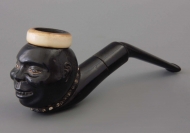
The discovery of para rubber or hard rubber in the nineteenth century marked a revolution for the pipe industry. The vulcanized rubber was easy to cast, easy to work and became beautifully glossy after polishing. Rubber stems were a particularly suitable solution for the serial production of briar pipes. Gradually, however, the manufacturers increased the use of this material by making the pipe entirely of hard rubber. Of course, an inner shell of meerschaum or briar had to be used with those pipes to prevent the rubber from scorching and spreading smelly black smoke. The tobacco pipe shown is a good example of a para rubber pipe. The bowl shows the puffy head of a Negro, possibly an existing person who was popular in the interbellum period. To add some relief to the design, some accents have been highlighted with paint. Remarkable is the curious kink in the stem, which gives the pipe a specific silhouette. The quality of pipes made of para rubber varies greatly. When the raw material is not properly vulcanized the object discolours quickly resulting in an unpleasant aftertaste. This specimen, on the other hand, is made of a beautiful strong deep black rubber, which is not discoloured at all and looks like the pipe was cast yesterday.
Amsterdam Pipe Museum APM 17.638
PermalinkPortrait head with fashionable glasses
juillet 2005
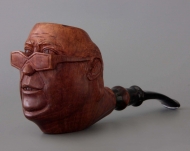
The carving of pipe bowls in briar is as old as the production of pipes in that material. However briarwood is very hard, thanks to its fineness, it can be worked well with a knife and anyone who is skilled in carving can achieve great results with this type of wood. The illustrated pipe is an example that shows a very characteristic and thus realistic portrait. Quite unusual in this case is the portrayal of a spectacled person and not just glasses, but rather a very fashionable pair. In addition, the face of the sitter is well-done by simplifying the details to make the main shape speak. The maker is Conrad Ovellet from St. Jean Port Joli in Quebec. The artist also signed this piece and even gave it the year 1984. The attachment of a acrylic stem was carried out by Aaron Beck from Fort Lauderdale, who was one of the first to know how to achieve beautiful results with different types and colors of acrylic. The striking depiction in combination with the colourful stem makes this tobacco pipe a desirable object.
Amsterdam Pipe Museum APM 17.584
PermalinkA shameless copy
juin 2005
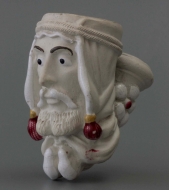
For many collectors this stub stemmed figural pipe gives the immediate association with the Bou Maza of Gambier, shape number 829. Rightly so because the modeling is exactly the same. However, it is a much rarer piece, made by Julius Wingender from Höhr who launched this pipe design as number 206. More often Belgian and German companies were inspired by the leading French factories, with Gambier's designs the most often being imitated. The imitation went so far that even the characteristic French enamel painting was applied. In the nineteenth century, when copyright law did not yet exist, copying was not seen as a sin even though some manufacturers did protest. Countless smokers from the past will never have realized that their pipe was not an original one, but a copy made by another company or even another country. As a person, Bou Maza only enjoyed popularity for a short time. That was when he led the fight against the French in Algeria after Abd-el-Kader fled to Morocco. He was leader until 1848 and had to surrender due to lack of resources. In Paris, he escaped from prison and quickly fell into oblivion. The Gambier company launched this pipe shape to exploit the interest in Bou Maza. Later the design was sold as an image of an no-name Arab to a much wider group of smokers. So, a specific portrayal gradually devalued into a general country type.
Amsterdam Pipe Museum APM 17.526
PermalinkA totem pole of portraits
mai 2005
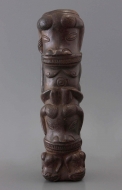
This monumental pipe bowl, shaped from earthenware, shows a magnificent stack of animal portraits. The potter who made this object possessed the art of shaping a continuum of masks on the front of the high pipe bowl, with buffalo heads alternating. The upper buffalo head stands on a naked human torso with breasts and a navel, the arms run along the sides of the bowl. Such striking pieces were made in the Grasslands of Cameroon by potters who worked in a strong tradition. Large, prestigious pipe bowls were intended for the tribal oldest or other important people. They were kept as a sort of collection to be displayed as a showpiece from time to time. They were not smoked, they were only carried around. On that occasion the pipe bowls were filled with tobacco, which after the ceremony was donated to the servants. Due to the strong tradition of pipe makers in the Grasslands, robust heads have been made for generations in more or less the same way, making it extremely difficult to date them. A second copy in the Amsterdam Pipe Museum shows the same stacking of portraits, but then no buffalo are shown but people. For the residents of the Grasslands, a change in the subject is, as to be expected, a reason to assign a different symbolic value to the pipe.
Amsterdam Pipe Museum APM 17.521
PermalinkA portrait pipe in faience
avril 2005
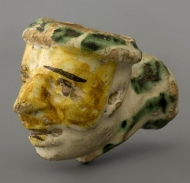
This Italian pipe bowl stands out for its design and use of colour. With its yellow shard and colourful tin glaze, it is one of the luxury and therefore rare pipes made of ceramic. The basic shape of this pipe was made in a simple two-part printing mould. The fashion is more sketchy than detailed and that underlines the philosophy of the maker who did not want to create an art product, but a simple yet striking object. After the so-called biscuit fire, the pipe bowl was glazed. The underglaze layer was usually applied by means of a sponge or a brush. Then the details with the brush followed. The latter happened in three colours and with a certain speed. The eyes, eyebrows and mouth are tipped with purple, the face with an orange tint. Finally, the cap of the head is provided with green stripes, together with the stem end. The glaze melts during the final fire. No matter how well-intended, the object displays craftsmanship but not the perfection that faience could have. The printing mould has too few details for this, presumably because it has been in use for some time. Moreover, tin glaze is rather thick and syrupy, which covers and obscures the shape characteristics. For the smoker, however, this pipe was a striking piece because the Italians mainly smoked from simple terracotta pipe bowls. IN this ase, figuration and colour were the elements with which the smoker of the past could stand out.
Amsterdam Pipe Museum APM 17.510
PermalinkDunhill with bamboo
mars 2005
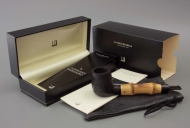
The use of bamboo as a pipe stem has been known for centuries, although this material has rarely been used in the briar pipe. From 1860 on hard rubber is the standaard and bamboo hits the background. However, a special effect can be achieved with a piece of bamboo wood, so that even the most exclusive pipe brands could give their pipes an unexpected appearance. This is reflected in this sand-blasted Dunhill, where the bamboo center piece gives cachet, all the more so since it is still very subtly burned and shows light brown hues. This clear but rustic detail becomes a focus in itself between the blackened bowl and the glossy black mouthpiece. Furthermore, there is something else to note about this item. For a pipe museum it is important not only to preserve the pipe, the original packaging is also part of the object and its history. That is why the pipe bag and the packaging box of modern pipes are also included in the collection. They inform us about the way in which the manufacturer put his product on the market and the Dunhill company definitely excels in this respect. With a box made of hard material, protected from scratches by a cardboard sleeve, the product is almost packaged like a jewel. This package also contains a guarantee certificate and a brochure about The White Spot, the circle of motivated/distinguished/select Dunhill smokers who are proud of part of it.
Amsterdam Pipe Museum APM 17.501
PermalinkFigural opium damper
février 2005

A functional pipe with a simple opium damper is the most suitable for the opium taker. Nevertheless, in addition to these plain objects that are suitable for use, curiosities have also been created for which the figurative damper shown here is exemplary. The bowl is shaped like a sitting mandarin with a bare belly, his navel forms the pipe bowl, the arms run along the body, the right hand rests on the knee while he holds something unclear in its left hand. The person wears a flat cap on the head. Thanks to the posture of the buddha, a compact design has been obtained where only the head sticks out. As usual, this opium damper is provided on the underside with a maker's mark consisting of two impressed Chinese characters. Various of such bowls were alternately placed on the long tubular stem of the opium pipe. Due to a metal bowl holder with a short insertion stem on the pipe damper, that could be done with a simple movement. The insert stem slid into a cuff-shaped holder that was attached to the pipe stem with a so-called saddle plate. Quick change was possible, while standardized diameters of the stem and saddle plate ensure an airtight placement of the damper.
Amsterdam Pipe Museum APM 17.491
PermalinkGiant pipe with exhibition building
janvier 2005
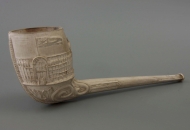
In the last part of the nineteenth century, countless giant pipes emerged on the market in England, that were known under all sorts of names. Four hours smoking pipe, giant or cadger were used as indication, among others. They are made in various shapes and with numerous decorations. Time-bound copies show the facade of an exhibition building around the bowl. The oldest version is the Chrystal Palace from Hyde Park in London, built in 1852 on the occasion of the first major English world exhibition. Fifteen years later, a similar building is rising in Manchester, but with a different silhouette dominated by a central dome. That design is also depicted on cadgers, as the accompanying pipe shows. Cheerful detail in the silhouette of the building are the large waving flags on either side with the British flag in the top corner. Below the continuous façade wall we see a stylized leaf motif flanked by a curl on either side. The stem often shows a text shield on both sides, sometimes filled in with the name of the maker and the place of origin. With this pipe that shield has been left blank and that indicates that the pipe comes from a less authoritative factory.
Amsterdam Pipe Museum APM 17.448
PermalinkSitting dog
décembre 2004
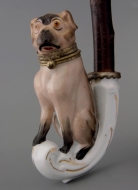
They are called Bohemians by the American collectors, the porcelain pipes from Bohemia that are decorated with figurative representations. For those who adore the exclusive eighteenth-century portrait pipes from Meissen and other authoritative factories, the Bohemians are horrible. They lack the refinement of the porcelain, but also the balanced refinement in the execution. Moreover, the portrayal is more amusing than distinguished. Finally, the painting has always been hastily applied in too bright colours. Yet these pipes are a culture in themselves because of their ever different appearance wich makes there are several hundred different designs to collect. An example of these Bohemians is the pipe with a seated dog, the head of the animal forming the lid of the pipe as usual. Because this is a somewhat earlier specimen, the representation is not too loud yet, while the pedestal is also beautifully designed. Some gold is even applied. It is precisely that pedestal that later becomes somewhat shapeless. The mounting consists of a straight cherry wood stem with a simply curved horn mouthpiece. Target group is the smoker for whom his pipe is a statement, but who still has something to learn in terms of taste.
Amsterdam Pipe Museum APM 17.440
PermalinkOstrich with horseshoe
novembre 2004
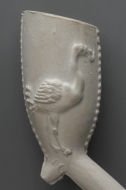
This decorated pipe bowl was found in Haarlem and fits well with the image we have of Haarlem smokers from the first quarter of the eighteenth century. They usually opted for common pipes with a simple decoration on the bowl. This is a striking relief decoration consisting of an ostrich standing on either side of the bowl with a horseshoe in the beak. The depiction of this exotic bird has been widely used since the seventeenth century, with the horseshoe rarely missing in the beak. It seems that the engraving on this pipe has been taken from a seventeenth-century print, on which countless chiseled gable stones with that same representation also fall back. Maker of the pipe bowl is the Boudewijn Claris from Gouda, owner of the initial mark BC. He placed that mark very modestly on the left side of the pipe just above the spur. On the other side we see a rosette as a mould mark and that may indicate that Claris owned a second copy of this engraved press mould.
Amsterdam Pipe Museum APM 17.450
PermalinkLotus flower with frog
octobre 2004

The Japanese pipe, referred to as kiseru, generally has a fixed concept. Characteristics are a small funnel-shaped bowl and a straight stem. Metal is the material used as standard, although the connecting part in the stem is often made of bamboo. This kiseru is completely different because the design is fully figurative. The bowl is shaped as the seed box of a lotus flower. The upper side is provided with holes in which white metal seeds can be seen, the funnel-shaped bowl made of silver is set in at the extreme end. The pipe stem is also worked out to nature and imitates the stem of the flower, a second twig curls playfully around the pipe stem and carries a closed red copper lotus bud near the bowl. At the mouthpiece, sitting on the stem, we see in high relief a copper frog that has been given playful eyes of gold. Finally, the stem end is cut diagonally and provided with seven small punctures like a real plant stem. This even includes a piece of silver. The tip is very ingeniously made, it can be screwed off to properly clean the pipe. A special detail is that when moving the pipe, the seed box makes the same sound as a real lotus rocking in the wind. When you move the pipe, the moveable white metal seeds emerge partly from the surface. All in all, we are admiring a very naturalistic design in delightful and skillful work with characteristic detailing that is specific to Japanese arts and crafts.
Amsterdam Pipe Museum APM 17.423
PermalinkEarly Peterson
septembre 2004
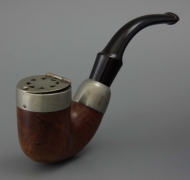
The Peterson firm from Dublin, officially called Kapp & Peterson, is renowned worldwide for its wooden pipes. Founded in Dublin in 1865, this factory quickly became known, thanks to, among other things, their own pipe designs that are marked by great reliability. The tobacco pipe shown here is an early product from this factory, although it already exhibits all the characteristics of the pipes as they are made today. Specific is the round metal ring on the tige, the taping stem and the round stem end with hole that is known as Peterson lip. Even the hinged cover is still in use, although the design has since changed. The so-called Peterson Standard System is not visible, which consists of a moisture chamber that is partly located under the bowl of the pipe where the tobacco moisture collects. Because of that system, the pipes are known as optimum dry smokers. A nice thing about this pipe is that on the reverse of the stem a trader's stamp has been placed that reads W. & R. Diehl, a firm from Munich, which by the way still exists. In that respect there is nothing new under the sun except that genuine early Peterson pipes are rare these days. Thanks to the excellent use properties, most Peterson pipes were smoked to the end and were only thrown away when they really could not be repaired anymore.
Amsterdam Pipe Museum APM 17.405
PermalinkEmpire style design with golden lid
août 2004
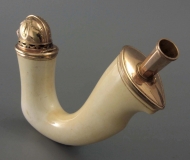
For those who take a good look, this meerschaum pipe bowl has a ravishing design. The bowl and stem have a flattened, swirling shape, while the characteristic bag type of the pipe fashionable at the time is still clearly visible in the bowl base. It is striking that the entire pipe is flattened on both sides, something we see more often at the beginning of the nineteenth century. This design with its slender shape and rising stem with wonderful curve at the end balances between the Louis XVI style and the Empire style. In addition to the particularly refined shape, the mounting also demonstrates exclusivity. This is not as usual made of white metal or silver, but in two colours of gold. The red gold was allied with copper, the yellow with nickel. The mounting is equally characteristic of the time of creation. Classic motifs were loved at the time, as evidenced by the helmet shape of the flap lid, but also from the vase in a standing oval on either side of the lid. Such characteristics are based on both Greek and Roman civilization. The subtle shape of the pipe and the refined decoration in the goldsmith work make this pipe an exclusive item for a wealthy smoker with good taste. The beautiful light meerschaum and the comfortable shape ensure optimum user enjoyment.
Amsterdam Pipe Museum APM 17.399
PermalinkDunhill short stem
juillet 2004
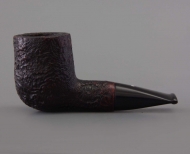
Pipes from the London firm Dunhill enjoy great appreciation among smokers and collectors, due to the solid and enduring high quality of the Dunhill products, of course in combination with the general renown of this global brand. Characteristic of Dunhill is the design in a persistent conservative modeling, although without exception stylish and chic. This pipe is a remarkable example of this style. The surprisingly short stem is the original aspect, which no manufacturer dares to produce. This pipe is the handy item for people who are on the move and find a normal, standard stemmed pipe impractical. For some Dutch smokers it can be regarded as a ‘nose warmer’ for smoking on bicycles. For sure this extremely short pipe is unsuitable for the hasty smoker because the smoke has no opportunity to cool down and every pipe smoker knows that hot smoke does not taste well. A series of codes is stamped on the tige of this pipe. We read "305 F / T DUNHILL SHELL MADE IN ENGLAND 0 2 S", statements the manufacturer wanted to communicate to his customers. This successively refers to the shape number, the type of mouthpiece with the so-called fish tail, brand and finish, location of production and annual code, finally the format figure and, quite unexpected, the finish again: s for ‘shell’ meaning sand-blasted.
Amsterdam Pipe Museum APM 17.474
PermalinkModern wood pipe with negroes
juin 2004
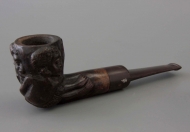
This remarkable tobacco pipe shows an interesting mix of a European shape with an African decoration. It was made in Tanzania in the years that meerschaum was mined there and even a pipe factory was founded. This happened on the initiative of the British, who encountered problems in Turkey with the purchase of raw meerschaum. The pipe factory arose in Arusha and was named Tanganyika Meerschaum Corporation Ltd. Pipes were made to the English taste, but it was not surprising that decorations from African culture were incorporated as well under the influence of local workers. This pipe is a good example of this intercultural mix. A local type of wood is used, which is more flammable than the briar and therefore the bowl is covered on the inside with meerschaum paste. The outside was decorated with two Negro figures according to local traditions. In accordance with puritan English custom, they are seen from the back and wear a loincloth. The carving of the figures shows a remarkably smooth relief that runs around the bowl very rhythmically and only shows the figuration in the second instance. A white elephant was used as a factory mark, stamped in the caoutchouc mouthpiece. The dating of this attractive pipe is in the 1970s.
Amsterdam Pipe Museum APM 17.370a
PermalinkPipe collection in cigar box
mai 2004
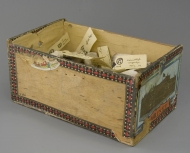
Collecting pipe bowls and stem fragments found in de fields is a hobby for young and old. Countless boxes and crates have been filled with clay pipe fragments and are still somewhere hidden in a cupboard waiting for renewed attention. The box shown here has since moved to that new destination and has even acquired a museum status. It is kept in our reserves as an example of such a cigar box collection. Incidentally, this is not so much about a group of pipe bowls that have been gathered at random, but about a genuine collection that has been brought together with love. The material was collected by the Amsterdam-based Onno Boers when he searched the area of his house as a boy. It is a good example of the care and dedication that many people cherish for the pipe as an archaeological find. This also applied to Onno, who, with his inquisitive mind, neatly labeled all his finds and additionally wrote down the information in a notebook. Seriously and as a playful pass-time at the same time he captured the history of his expeditions and the background of the pipe fragments for posterity. A wonderful proof of an Amsterdam boy's interest in history and curious enough to preserve because our museum collection was once started in such a cigar box.
Amsterdam Pipe Museum APM 17.366
PermalinkAgate tongs from Belgium
avril 2004
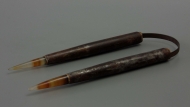
The quality of the clay pipe is in many cases determined by the finish. For that finish, stroke burnishing the surface after removing the mould seams is very important. By stroking the dry clay with agate stone, the clay plates were forced in one direction and a shiny line was created. A special tool for this task is shown here. It is a pair of polishing tongs or agate tongs where two agate stones tips are mounted on a spring-loaded bracket. Instead of stroking the pipe with a single stone, this instrument makes it possible to polish two sides at the same time. Especially for the production of long pipes, such a tool is extremely time-saving because it requires 50 percent less work. This object comes from A. De Bevere in Kortrijk and that factory is probably also the inventor of the intrument. In 1948 this tool moved to a pipe factory in Andenne, but was never used again. It is surprising that such an invention was not done in Gouda. Was this way of time saving never thought out or did the Gouda makers find the result insufficient?
Amsterdam Pipe Museum APM 17.363
PermalinkBust of George V
mars 2004
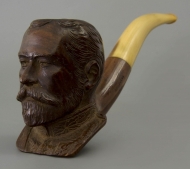
This briar tobacco pipe shows the bust of the English king George V. The concept, a head with a modest chest piece is characteristic for the pipe makers in Saint-Claude. They launched such portrait pipes as early as the 1870s and these remained popular until after the Second World War. The English George is shown here with a simple upstanding uniform collar, the chest piece itself is rather undefined. What makes the portrait look so realistic is that not only the personal traits are well-done, but especially the overall design of his head has been meticulously taken over. By copying the contours of the head three-dimensionally, some simple carving only needed to be added for the detailing. The advantage of this method was that the pipe could be fully preformed in a machine and the carver only had to align this products with a few retouches. Thanks to the signature on the tige, the wood part of the stem, we know that the maker is Charles Dessertines. He led one of the well-known workshops for figural pipes between 1910 and 1930. The additional mentioning ‘sculptor’ to the maker's name is proof that such pipes were sold as unique pieces of craftsmanship. It is, however, unmistakably a serial product whose sales were supported by the popularity of the British king. The mouthpiece is made of a blond buffalo horn, a widely used material at the time.
Amsterdam Pipe Museum APM 17.357
PermalinkShow piece full of riddles
février 2004
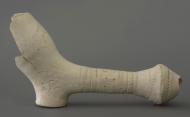
Recently this special tobacco pipe was excavated in the Wetering area in Amsterdam. It is not a standard size pipe, but a large one. The bowl, for example, has a height of more than eight centimeters, compared to less than four centimeters for the current pipe of that time. Much has been speculated about the function of such pipes. We now know that the idea that it is a guild piece is certainly not correct. Rather it seems to be a pipe as a shop sign or an object that was used as an advertisement. The pipe follows the then prevailing standard shape, but is not pressed in series but entirely moulded by hand. As a result, the balance have become slightly disproportionate, while hand-moulding also caused tension in the clay, causing shrinkage cracks. In the stem of such large pipes, a disk or knot was added to make the appearance more impressive. Apparently the pipe maker wanted to emphasize the special features of the product with such an accent. Many of such large size pipes are lavishly decorated with stamps and that is precisely what happened here in moderation. Because the TIP stamp has been used several times, we can assume that the maker is de Gouda pipe maker Thiel Jansz. Proost. He started his company in 1636 and continued to work well into the 1680s. A remarkable detail is the appearance of the "marigold" mark, which was hardly in demand at the time this pipe was made. The use of this stamp is as unexplained as the image of the heel stamp with double-headed eagle above which "HASELDOC" can be read. In that regard, there are still some mysteries about this object.
Amsterdam Pipe Museum APM 17.313
PermalinkImage of a water pipe smoker
janvier 2004
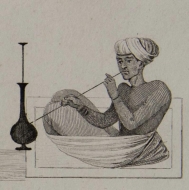
This simply executed print is one of many images of hookah or water pipe smokers produced in the nineteenth century. We find them as an illustration in travel journals to show the exotic smoking habits. This is a water pipe smoker from India, who, after a long journey, arrived in a smoking salon to rest and to smoke a sturdy pipe. The same print shows a few fellow smokers, in different styles with different types of water pipes. In this way the variety of clothing but also of smoking positions and hookahs from India are made known. The main feature is sitting on the floor smoking from a pipe with a clear bottle shape that is placed in front of the smoker. It is remarkable that all pipes have a fixed stem. This is different in the Mediterranean, where water pipes have a flexible hose that smokes more comfortably. For the Indian himself, the type of pipe, the clothing and the way of sitting can immediately tell the region of origin. Printed in European publications, however, only the curious way of smoking is preserved. Even more so when, as is this case, the lithographer who processed the drawings of the traveler simplified the details at its discretion. In this way he created an attractive unity in style that enhances the artistic quality of the print, but unfortunately some of the reality was lost as a result.
Amsterdam Pipe Museum APM 17.280
PermalinkCigar holder in a case
décembre 2003
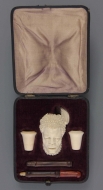
From 1850 onwards, the fashion of meerschaum cigar holders was created for the smokers and in a few decades a wide variety of designs were devised. Characteristic of the cigar holder is that it is often figurative and can take the most diverse forms and representations. A funnel-shaped holder, intended to clamp the cigar, has been given a place somewhere in the carving of such pipes. The cigar butt is put in there. The cigar pipe shown here is a good example of its time. The pipe bowl is figured and shows the head of a Negro with open mouth, making his teeth visible. In the short frizzy hair you can see a cord with beads on the left, with a raised plume that cheerfully sticks up. A pleated collar forms the transition to a disc-shaped stub. The top of the head is drilled in to insert the trumpet-shaped cigar holder. The protective case for this pipe is curious. The pipe bowl is placed centrally in this rectangular box. On both sides we see a meerschaum holder, each with its own diameter intended for thin and thicker cigars. In this charming rectangular box we also find a two-piece rosewood stem with an amber tip along the front edge. The case is covered with black leather on the outside, the inside lined with red velvet and reddish silk. Packed in this way, the luxury of the cigar pipe is highlighted, but this smoking set can also be easily taken along. As a matter of fact, this cigar holder has never become the owner's favorite because the pipe has only been used a few times.
Amsterdam Pipe Museum APM 17.312
PermalinkCartoon with smoker and snuff taker
novembre 2003
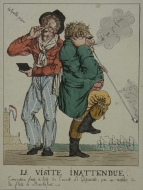
In the last quarter of the eighteenth century, the cartoon experienced great popularity, especially in England and France. This dry needle etching in standing format is French in origin and is typical in its kind. The coloured print shows two happy tobacco consumers in their typical attitudes. The man on the left takes some snuff powder from his snuff box with the exclamation: "what a great snuff". The person on the right is smoking from a long, oversized clay pipe with the sigh "ah, how delicious I smoke again". The two Nicotinists refer to a political problem that played a key role. Tobacco from the French colonies of Martinique and in particular San-Domingo was so heavily taxed that tobacco was regularly mingled with inferior leaf work. The taste of the tobacco deteriorated, while the price actually increased. Over time, Dutch merchant ships brought relief by bringing in excellent tobacco via Amsterdam. At the harbor head of Rochefort, on the left in the foreground, the Dutch flag goes out to welcome the Amsterdam fleet in the distance. For the French smoker this was, as the caption reads: "An unexpected and welcome visit" or literally "La visite inattendue".
Amsterdam Pipe Museum APM 17.253
PermalinkA wood pipe with bearded man
octobre 2003
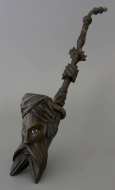
At first glance, this wooden tobacco pipe is reminiscent of a Jacob pipe, the popular tobacco pipe that was smoked by almost the entire French peasantry from 1860 onwards. Yet we have to see an independent design in this bearded pipe. Carved wooden pipes enjoyed a much higher status in the nineteenth century than clay figural pipes. That is why the images on wooden pipes do not refer to generally accepted items, because that would affect their status. Of course the design goes along with the fashion of the day with a love for exotic images in which especially men with beards and turbans scored. A clear difference in design, however, is that the beard is much shorter and runs out more strongly in two points, while the mustache of the man is many times larger than in the Jacob pipe. But also in the details we see that there is a different figure, for example the fact that the two tassels that Jacob wears standard on his turban are missing here, while two embroidered slips hang down from the turban that never occurs with the Jacob pipe. The finish of this pipe with a decoration of small silver nails on the turban also underlines the luxury of this object, together with the set glass eyes of course. The mounting with a twisted buffalo horn stem with a flexible part and button end also points to a more expensive item. As we know, the Jacob pipe was commony fitted with a cherry wood stem and a simple mouthpiece.
Amsterdam Pipe Museum APM 17.143
PermalinkHitler's head
septembre 2003
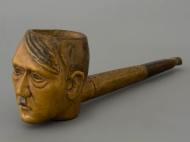
The well-known Dutch pipe collector Henk van der Hoef from Zeist received this wooden pipe bowl as a gift from a German collector in 1941. The pipe bowl shows the head of Adolf Hitler as we know him with characteristic lock on the forehead and the typical small mustache. On the underside, on the neck of the portrayed person a swastika is carved. Striking is the beautiful light grain-free wood that has been carved in a nearly realistic way. Yet this pipe bowl appears to me as a bizarre gift to a Dutchman during German occupation, but Van der Hoef has included the pipe in his collection and even cherished it until his death. As a maker of riding clothes of the then Prince of the Netherlands, such a portrait pipe was completely inappropriate, even as part of a collection. Probably for that reason, when the war was over, the inscription "ES WAR EINMAL" was carved on the stem of the pipe to indicate that Hitler's fairy tale had ended. The portrait of the successful leader downgraded to that of a loser. By the way, pipes with the portrait of Hitler are also made by others, although they remain a rarity. They mainly occur as an inappropriate joke and they probably never got a place in literature for that reason.
Amsterdam Pipe Museum APM 17.131
PermalinkMeerschaum Turk head
août 2003
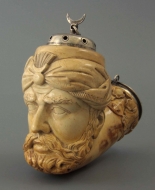
The portrayal of exotics and especially Turks with turbans is loved by tobacco pipe makers and was already worked out in fine details by porcelain factories from the eighteenth century. This majestic portrait head of a Turk with turban is undoubtedly inspired by those creations and all characteristics are almost slavishly adopted. However, manufacture of this piece did not take place until the Turkomania was already over, namely in the first half of the nineteenth century. Although robust and well proportioned, the image can be fully traced back to earlier examples, there is hardly anything of its own. Yet for those who pay close attention, one characteristic is typical of the nineteenth century, and that is the beard of the Turk, which did not occur in eighteenth century versions in porcelain. The turban is, as usual, provided with a chelengk, an Ottoman decorative feather with the characteristic half-moon underneath. Nice detail is that the moon of the turban is repeated on the silver lid. Whereas the porcelain counterparts always have a hinged cover, a clamping cover is used here, which is secured to the stub ring with a silver chain. The stem end is trimmed with a silver band of stylized acanthus leaves. What is special about this object is that it is a signed meerschaum pipe, the name of the pipe maker Roth, at the time working in Budapest, is imprinted on the stub. The object was preserved with the accompanying case. Practically, the pipe can be smoked in the case and then the silver lid with moon protrudes pontifically above it. In use, the fragile meerschaum was protected against damage and ugly, uneven discolouration.
Amsterdam Pipe Museum APM 17.134
PermalinkHunting scene in antler
juillet 2003
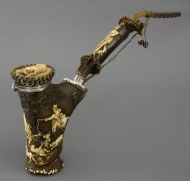
A wonderful and quite factitious pipe is this specimen made from deer antlers. The pipe bowl is carved from a single piece that sits in the red deer antler between the rose or the attachment of the antler and the first branch. This piece of deer horn offers a natural place for the pipe bowl and the attachment for the pipe stem. The surface of the antlers can be cut and this creates a scene with a beautiful contrast. When the carved decoration is subsequently polished, it even looks like appliques made of ivory. The theme of this pipe bowl is hunting, with a deer in the center, surrounded by hunting dogs. On both sides of the pipe bowl hunters are shown on horseback, with a whip in hand they drive up the game. Not very sportif, both hunters are wearing top-hats. The lid on the pipe bowl is also a crown piece of an antler, on which a sleeping hunting dog has been carved on the top. With a silver mounting, this lid is attached to the pipe bowl, along the edge with a fence by way of air inlet. The stem is also made of stag horn with an appropriate Diana on the top, goddess of the hunt with a hunting dog to her right. However, the mouthpiece of the pipe is buffalo horn, because stag horn is too hard and therefore unpleasant to hold between the teeth. The production of such curious pipes is said to have taken place in Meiningen in Thuringia. Gunpowder horns and all kinds of boxes of deer antlers have been made there for centuries. In the nineteenth century the tobacco pipe was added to their assortment as a new item, especially those with hunting-related subjects such as this one. Incidentally, the tobacco pipe of antler has not become a general article, they were too expensive for that and the design too extreme. Moreover, the material is heavy and not comfortable to hold. That production, however, achieved a high degree of refinement may be clear with this pipe.
Amsterdam Pipe Museum APM 17.115
PermalinkAmusing Polichinelle
juin 2003
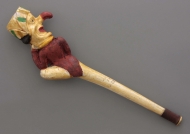
This figural clay pipe plays with the design in an original way. A seated Jan Klaassen or Punch forms the pipe bowl, his hook nose clearly protrudes from the silhouette, much more than the two-sided stitch on his head. The depiction refers to the Polichinelle or the Jan Klaassen, who was extremely popular in France in the nineteenth century. The design of this pipe can be attributed to the French pipe manufacturer Louis Fiolet from Saint-Omer and dates back to before 1840. The original name is Polichinel vampire. Yet this pipe is not really an original design from the Fiolet factory, but a copy made by Félix Wingender from Chokier along the Meuse river in Belgium. This factory was known for copying pipe designs from other companies in order to make good impressions. This pipe, by the way, is not simply recast, but has been remodeled. For example, the stem angle and size are different from the original design. The stem stamp with the text "WINGENDER FRERES A CHOKIER" proves the Belgian maker, who sold the pipe under shape number 63. Nice about this pipe is the original painting, in which in addition to red paint and some green tufts a transparent yellow lacquer has been used which gives the pipe a cheerful appearance. Of course, such pipes were more of a curiosity than a functional article, although of course they had a possibility of use. This is also confirmed by the rubber that has been slid around the stem end which enables the smoker to hold the pipe between his teeth without signs of wear.
Amsterdam Pipe Museum APM 17.046
PermalinkGold stone ashtray
mai 2003
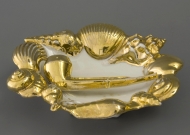
This ashtray has never been a functional item for smokers, but a fashion item all the more. In the last part of the nineteenth century, millions of curiosities and garlands were made in German porcelain factories, and this object is one of them. Although intended as an ashtray, it is primarily a decorative item to exhibit in the then overcrowded houses of the constantly growing middle class. An embellished border of shells and snail houses can be seen in relief along the edge, the realistic representation of nature as Palissy had done with dishes centuries before. Across the object lies a tobacco pipe as decoration, as a nonfunctional pipe fixed to the ashtray with the bowl and stem. It is precisely by fitting a pipe that the use function of the object is seriously impeded. It is nice that a modern pipe design was chosen with a bulldog bowl and a short, saddle stem. From 1890, such shapes, made in briar wood, were extremely popular. The fact that the German porcelain factories made an infinite series of such ashtrays and other curiosities is evidenced by the shape number affixed to the bottom giving "3308". Unfortunately it is not clear where the production took place. In the Netherlands, this ware was especially popular as a showpiece in the farming environment, especially in the east Achterhoek. Nevertheless the object depicted here comes from a Zeeland family.
Amsterdam Pipe Museum APM 16.952
PermalinkColourful Thai folklore
avril 2003
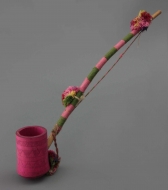
For the Akha, a tribe that has populated northern Thailand since the beginning of the twentieth century, this extremely cheerful tobacco pipe is characteristic. A closer look at the pipe shows that it is a simple but highly effective object. The pipe bowl is cut from a piece of bamboo, with the partition of the bamboo becoming the bowl bottom. On the underside of this a small piece of wood has been kept, in order to drill for fixing a securing cord. The bamboo bowl was then drilled in on the side for attaching a thin wicker stem. This created a simple but usable pipe of extremely low weight. This result was subsequently not left without adornment. First the bowl was provided with a simple scratched geometric lines all around. After that it was painted in a wonderful, but typical, red-purple colour. Finally, the stem is also woven into colourful threads, alternating in the same red-purple colour in combination with green. A locking cord is also attached, running from the top of the stem to the hole at the bottom of the pipe bowl. Here some fabric balls are added as extra decoration. Although not a sustainable item, this cheerful object is very specific for the tribe and especially original.
Amsterdam Pipe Museum APM 17.467
PermalinkGood oldie
mars 2003
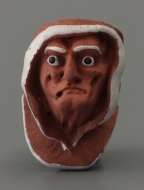
This beautifully designed portrait pipe of an old woman comes from a factory whose history is still unwritten. Made from red clay with a striking enamel painting in white, this pipe has a very special appearance. Particularly unusual is the hood, which shows deep-lying spaces next to the face, a relief effect that was avoided at most factories because the filling of those protruding pieces during pressing often led to so-called clay shortages. That was apparently a challenge for this pipe maker and he certainly did a good job, making a very fine pipe. This woman, full of character, once smothered a pipe between the lips, of which a tiny hole in the lip is still the proof. Nobody will be surprised that that loose mini pipe has been lost. All in all, there is a special modelé in a style that is really sculptural and, in particular, looks less smooth than the products of competing factories. Maker is Testervuide who worked in Pont-à-Moussin in the Lorraine. The company worked until the mid-1870s, but more than a few pipes of that brand are not known. That is highly surprising, because this pipe bowl shows the number 216 as the shape number which surely awakens the expectation of a substantial factory assortment. This pipe bowl is worthy evidence that more has been achieved than is shown by the figural pipes made by the major French factories such as Gambier, Fiolet and Duméril.
Amsterdam Pipe Museum APM 16.837
PermalinkA pipe from the Plains
février 2003
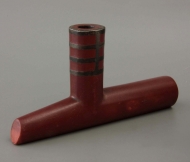
They are always called peace pipe, but the term ceremonial pipe would be more appropriate. Made from catlinite, also known as pipestone, this pipe enjoyed a great reputation among the Indian or more exact Native American tribes and was only smoked on sacral occasions. The special type of stone with the beautiful red colour, often with subtle hues, was said to have been kept in a special place by the tribal elder. Thus the sacral aspect of the pipe was underlined. Characteristic of this Indian pipe is the design in which the flattened shape has to do with the small thickness of the stone layers. The appearance of bowl and stem are fixed by tradition. The cylindrical bowl perpendicular to the stem is a standard feature, while the stem itself continues a little behind the pipe bowl. Often that part becomes very subtly slightly thinner to be cut obliquely at the end. This specimen has all those characteristics but is a even bit more luxurious than usual. The pipe bowl is in fact provided with an incised geometric pattern on the upper part which is afterwards filled in with lead. Casting this lead work was a simple job and just happened in the sand. When this lead had hardened, it was trimmed and polished to a pleasantly smooth surface. Such pipes were widely used in the prairie area east of the Rocky Mountains, but are nowadays very sought after by collectors and thus becoming quite rare. They are among the most distinctive/iconic objects of Indian culture and speak strongly to the imagination.
Amsterdam Pipe Museum APM 16.849
PermalinkWater barrel or asenewa
janvier 2003
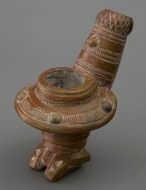
At the Ashanti people in Ghana there is a close relationship between proverbs or sayings from the local language and the design of their household goods and consumer articles. It is therefore not surprising that many pipe bowls are consistent with expressions in everyday language. This pipe bowl makesa good example. This is because a bowl or asenewa is depicted in the pipe, a metal vessel containing water that is the most common piece of household for the Ashanti in addition to the cooking pot. This depiction expresses a saying that is not so understandable to us: ‘When the pot of the poor breaks, the gourd lies next to it’. The way of saying indicates that the poor are satisfied with little: if their water pot breaks, they simply use a gourd. Striking and also characteristic of these pipes is the fine carving in the earthenware that has been designed in this way for generations. The beautiful engobe with which the ceramic is covered is another characteristic of these finely decorated pipes. After the pipe was baked, it was rubbed with white chalk to enhance the contrast of the incisions. Such pipe bowls were mounted with a straight wooden stem, sometimes covered with metal fittings. Understandably, those stems are hardly preserved because they were not taken by travelers, while the decorated pipe bowls were popular souvenirs.
Amsterdam Pipe Museum APM 16.708
PermalinkA chamois horn as a pipe bowl
décembre 2002
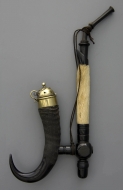
For the pipe smoker, the nineteenth century is the century with the largest selection of curious smoking utensils for which there was great interest among smokers. In this way we see a wide variety of pipes in unexpected shapes and of different materials. The tobacco pipe shown here is a good example of this crave for the curious. It is a so-called Gesteck pipe, a pipe made up of individual parts according to a fixed pattern. A horn of a gems has been chosen for the pipe bowl, which is covered on the inside with a non-combustible paste. As usual, the pipe bowl was mountedwith an elegant white metal hinged cover. The rising stem of the pipe is made up of buffalo horn parts that screw into each other. Remarkable is the stem piece in the center of the pipe that is covered with chamois or mountain goat fur and ends at the top in a miniature chamois hoof. Although somewhat ridiculous and, above all, contrived, a beautiful unity has emerged with a strong relationship between nature and hunting, themes that dominate many German tobacco pipes. The pipe is also representative of the enormous buffalo horn turning industry that developed in the nineteenth century and was primarily at the service of tobacco pipe manufacturing. It was practiced in several places although much work shows an amazing unity.
Amsterdam Pipe Museum APM 16.715
PermalinkBlanc-de-Chine Turk head
novembre 2002
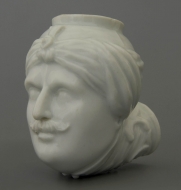
When the porcelain portrait pipe became popular in the second half of the eighteenth century, images of Turks' heads quickly gained popularity. It is not without a reason that this was in keeping with the so-called Turkomania, a fashion that was part of many art forms. In addition, there was the advantage for the designer of the pipe bowls of modeling a turban, which was much simpler than complicated hats. This Turks head follows the usual concept and shows a mustache man's head with a simple turban. A few mantle folds are applied to the stem, with a c-volute on either side, an ornament that points to an early date. The pipe bowl was created in the leading porcelain factory, the Königlichen Sächsischen Porzellan-Manufaktur in Meissen. We know that thanks to the blue painted underglaze mark of two crossed sabers on the inside of the bowl. Remarkable here is that the pipe bowl is not painted in many colours, but is finished in so-called Blanc-de-Chine. Sober design, but not the most economical. At the time, the pipes from Meissen were among the most expensive specimens available, regardless of whether this was with or without painting.
Amsterdam Pipe Museum APM 16.569
PermalinkNegro with carrying basket
octobre 2002
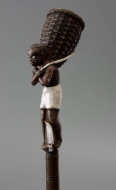
Apparently an ordinary figural clay pipe but with a special design. A standing Negro forms part of the stem, the pipe bowl is shaped as an oval basket that rests on its shoulders. What makes the pipe so special is the beautiful, lifelike design, which is perfectly proportioned and extremely detailed, even if it is a miniature version. Thus we see that the basket with the carrying straps naturally influences the posture of the standing figure so that we forget that this man is part of the pipe stem. Due to endless smoking, the pipe is coloured enhancing the effect of the otherwise sparing accents in white enamel paint. Pay particular attention to the speaking, contrasting eyes. One day the pipe broke and the smoker had it fitted with a new buffalo horn mouthpiece, attached with a brass ferrule. After that it was smoked with pleasure for years until the pipe got the deep dark brown colour that it still has today. The maker is the Louis Fiolet company from Saint-Omer who put this design on the market around 1855. Given its origin, it is not impossible that this specific specimen is the same pipe that Fairholt depicted in his book on tobacco use in 1859. Describing this pipe Fairholt made a link to current events by connecting this pipe with Uncle Tom's Cabin. What is most evident from that attribution is that many of the depictions in pipe design of that time were rooted in the topicality of the day.
Amsterdam Pipe Museum APM 16.585
PermalinkUnusual name pipe
septembre 2002
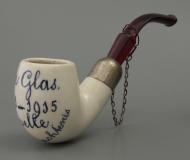
A name pipe has always been a valued item. Donated by a loved one or ordered in other cases personally, it gave the smoker a special identity. The occasion was often a festive or memorable event that people were happy to look back on. When the glazed ceramic pipe developed in Gouda around 1910, the name pipe variant soon appeared. This copy is an early example of this kind. The pipe dates from 1915 and does not yet have the appearance as it later became, characterized by a scene in a geometric frame with text in block lettering. Here the inscription "PIETER GLAS 1891-1915 KAPELLE IN MEMORY" is still straight forward or even primitive. The text is written right in the middle of the bowl in the then usual handwriting, executed in only one single colour and still the most obvious one: blue. The product was created at the Koninklijke Goedewaagen and looks like a loner in a style that has not been continued. Even the stem is time-bound, as it is not made in hard rubber, but in a red sort of plastic. Such stems were introduced during the turn of the last century and gained great popularity because they could compete with amber in appearance. In addition, they had the advantage that they were significantly stronger. To protect the bowl against breakage, a locking chain with a locking eye was attached on the curved shapes. If the bowl were to fall off the stem, it would not break thanks to the little chain.
Amsterdam Pipe Museum APM 16.512
PermalinkMeerschaum by Gambier
août 2002
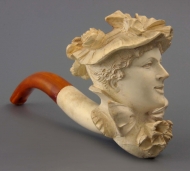
This meerschaum tobacco pipe shows the head of an English lady with a flat hat decorated with flowers and ribbons, a kind of general portrait that was carved more often around the year 1900. Elegant women's portraits were popular motifs for tobacco pipes and were in particular in demand with the bourgeois smoker. What makes this pipe special, however, is not the design but the address in the case. On the inside of the lid we read in gold leaf letters "J. GAMBIER PARIS" and that text indicates that the pipe was traded by the Gambier company. It dates back to the time when this famous clay pipe factory was struggling with declining sales and the management was hoping to be able to better serve the retail trade through extended representation in wooden and meerschaum pipes. By the way, addresses in the cases of meerschaum pipes are almost always related to the reseller and unfortunately they rarely refer to the workplace where the pipe was made. The actual production site of this tobacco pipe therefore remains hidden. Should we unexpectedly come across this design in a manufacturer catalog of a meerschaum factory, even then we must keep in mind that the factories also outsourced a lot of work. In addition, it was normal for manufacturers to trade work from other makers, so that they could supply the most complete range possible. Nowadays, this trade policy makes attribution virtually impossible.
Amsterdam Pipe Museum APM 16.472
PermalinkMulticolour glaze
juillet 2002
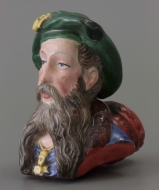
This beautifully shaped pipe bowl of a man in historical costume originates in the Dutel-Gisclon factory in Montereau. The press mould for this distinctive pipe was made in the 1870s, but it was most likely an older design. Remarkable fot this copy is the finish with a painting in multi-colour glaze, which covers the entire surface of the pipe. In contrast to the more common paint enamel, in which only a few colour accents were made, in this case a fully polychrome version is made. Until now it is the only pipe with this colourful finish that is known from Gisclon and therefore a rarity. Therefore we expect this work is not done in the pipe factory itself, but by a potter somewhere in France. Especially the lifelike tones of the man's face are well done, because skin colours are very difficult to approach. By the way, glazing a clay pipe is not a logical choise. due to the pressing of the pipe the surface has become too smooth to give a good adhesion for the glaze. This results in a vulnerable glaze skin that is likely to loose flakes of enamel in the event of an impact.
Amsterdam Pipe Museum APM 16.494
PermalinkA portrait pipe with allure
juin 2002
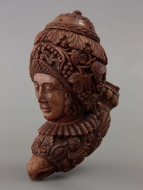
This magnificent stub stemmed pipe bowl is made from coquilla nut, a hard tropical nut that can freshly be cut, but which later hardens and becomes rock hard. From the beginning of the nineteenth century, pipes were made from these nuts, often with an extraordinary artistic design. They are the variant of the numerous small snuff boxes and other curiosities that were also made out of the same material. This pipe bowl is a wonderful and particularly artistic example. The bowl represents the head of a woman, a band with grapevines interlaced in her hair. A bird's head below her collar protrudes at the base of the pipe bowl, its curved beak forming the extreme tip of the pipe bowl. This bird's head almost unnoticeably turns into a stem, decorated with geometric carvings with an abundance of flower buds. To complete the sculpture, a cover has even been made in the same nut, which is attached to the pipe bowl with a small brass hinge. Coquilla nut is not really resistant to the burning tobacco, so an insert of a different material is added into the bowl. Often – as in this case - this is a normal clay pipe bowl, which ensures both a neutral taste, and also prevents the nut from cracking due to heat. Thanks to that inner bowl, the pipe also became a suitable smoking instrument for critical smokers.
Amsterdam Pipe Museum APM 16.473
PermalinkSafe in a box
mai 2002
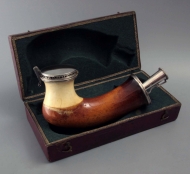
Meerschaum is and remains a precious material and meerschaum pipes were always carefully stored away by smokers. This rectangular wooden box is a nice example of a storage box for a large meerschaum pipe bowl in a so-called bag shape. Characteristic is the slightly overweight bowl base in a round shape and a narrower bowl top, making the pipe easy to hold during smoking. Characteristic of the period is the relatively long stem part that always rises slightly. As usual, such meerschaum pipes were fitted with a silver hinged cover with a sawn fence around the outside edge to allow the air flow into the bowl. At the other end of the pipe is a silver stem plate on which a silver ferrule for mounting the separate stem. The engraved text "V.BLÜCHER" on this silver stem indicates the proud owner of this robust pipe bowl, a member of the famous Von Blücher family. The Prussian field marshal Gebhard Leberecht von Blücher led the conquest of Paris in 1814 and took part in the Battle of Waterloo, thus playing a dececive role in a the allied victory over Napoleon. The owner of this pipe was a serious smoker and has used his tobacco pipe for years. We can see that in the beautiful dark patina. Intentionally the top part of the meerschaum was rubbed with white wax, so that only the lower half of the pipe bowl could absorb the tobacco juce that made the fine patina.
Amsterdam Pipe Museum APM 16.444
PermalinkBriar with Gouda shape
avril 2002
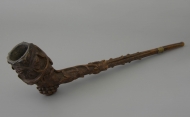
The Gouda pipe with its oval bowl, cylindrical heel and straight stem has gained a worldwide fame and reknown. The popularity of this product continues to resonate in other production centres and even in other materials. This tobacco pipe carved in briar wood makes a good example. In terms of shape, the pipe is completely Gouda-like, however, its material and decoration is related to other regions. For example, the swinging grapevine with its characteristic leaves cut around the surface is definitely not Dutch. Vines have long been popular as a decorative element, often interspersed with bunches of grapes. The latter motif is used here in the heel. To make a gradual ending of the decoration on the pipe stem, a knotty branch is depicted in the middle part of the stem, very appropriately a naturalistic representation of the vine. The mouthpiece is added in amber to give the smoker the required comfort. The maker is probably the company Aschenbrenner & Cie. from Saint-Claude in France. They supplied a series of such pipes, the most prestigious examples of which can be more than a meter in lenght!
Amsterdam Pipe Museum APM 16.451
PermalinkFish decoration
mars 2002
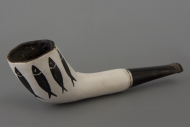
This tobacco pipe originates from the workshop of the ceramist Owen Jegou, who was active around 1960 in France. It is one of the many examples of ceramic pipes that follow the traditional pipe shape, but are adapted to their own sense for design and taste. This can also be seen in the work of Jegou. In addition to variation in shape, we see different motifs, with which Jegou usually decorated his pipes: scratched animal figures, such as the fish or a standing rooster, occur alongside, for example, flowering tobacco plants or other motifs. Since Jegou is also known for some other pipe designs, we can assume that he was a respected ceramist in his time with a certain reputation as a pipe maker. It is curious to notice that a person like him is completely forgotten within a few decades. Nevertheless, thanks to this preserved pipe holding his signature, his work has gained eternal value. The carefully hand-made buffalo horn stem and the aluminium screw system with which it is attached to the pipe prove that it is actually meant as a serious smoking pipe.
Amsterdam Pipe Museum APM 16.457
PermalinkBronze pipe of the Batak
février 2002

In the local language these bronze pipes are called raja or datu toba. These are tobacco pipes made by the Batak tribes that live in the north of Sumatra, especially around Lake Toba. The pipes were regarded as a status item for the Batak tribal leader, the raja or the priest, the datu. For generations this tribe has made their tobacco pipes in bronze, in a design following a fixed concept. This type, there are two, is the most common and has a trunk-like bowl, a heel marking and a long straight stem. The pipe is cast in the so-called lost wax method and is provided with a rhythmic geometric decoration on the bowl and stem. Because the long stem cannot be cast in one go, it consists of three pieces that are held together with a wooden core. Slightly beyond the centre of gravity of the pipe is a thickened band with a few knurls, which gives the pipe an elegant balance. Finally, there is a suspension eye on the bowl for carrying the pipe, commonly on a brass chain. Rare with this specimen is that the bowl has a lid that closes with a hinge. On this lid we see a cast standing rooster. This pipe with a length of more than eighty centimetres including the stem proves that Batak pipes can have a considerable length. They were carried over the shoulder with a chain. Notwithstanding the length and weight these pipes were actually used as smoking instruments, as witnessed by the layer of soot and tobacco residues in the original pieces, although these pipes were of course reserved for specific users.
Amsterdam Pipe Museum APM 16.424
PermalinkCheek head
janvier 2002
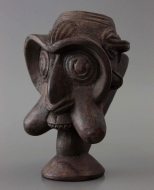
According to the seller, this pipe bowl was kept in the Monastère Bénedictin du Mont Fébé in Yaoundé, capital town of Cameroon and was preserved there until 1999. The most remarkable feature of this object is the stylized face with the inflated cheeks, referring to the trumpeters who accompany the king and who blow their cheeks with air. At the top, the face is closed with two eyebrows that extend into each other, forming a flowing line above the circular eyes. Those eyes account for an attribution to the Bamileke, a tribe living in the Grassland area of Cameroon. Another unexpected feature is the flat base on which the pipe bowl can stand stably. Although technically suitable for smoking, such pipes were mainly made as collectors' items. The design of this pipe bowl is strong in itself and cannot be compared with many other figurative pipe bowls. However, this pipe must have been produced in series, as determined by the pottery tradition on the Grasslands, although a second one is not yet known. Another typical characteristic is the black colour of the braised ceramics in which most pipe bowls from the region are made.
Amsterdam Pipe Museum APM 16.421
PermalinkTest pipe by Scholenaar
décembre 2001
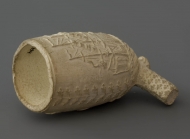
In the nineteenth century father Pieter and son Pieter Gerardus Scholenaar worked in Gouda, the first as silversmith, the second as engraver. On request of the Gouda pipe makers they decorated the brass press moulds by adding engravings. That activity followed the tradition of their predecessors with the same tools that went back to the heyday of pipe industry around 1750. This massive pipe bowl originates from the workshop of son Pieter Scholenaar junior. When he had decorated a pipe mould, he made a massive print in clay to check the result. That print was saved with alle the others and served him as an example for new designs. After his death in 1909, Pieter Goedewaagen donated his archive of several hundred casts to the Gouda Municipal Museum. Unfortunately, those examples were not preserved there, presumably they were thrown away during a clean-up due to lack of knowledge. This specimen comes from the factory inventory of the Koninklijke Goedewaagen pipe works in 1963 and is one of the few remaining examples. The object is of exceptional importance because it learns us which dies were used by the Scholenaar’s. By comparing the ornaments on this pipe bowl with other decorated pipes from the nineteenth century, we can determine whether Scholenaar was the decorator or whether a different mould engraver is the maker. In this way we can group the decorations in order to make better descriptions of the pipes. This is especially important because many pipes from that later period no longer have a maker's mark and cannot be identified in any other way.
Amsterdam Pipe Museum APM 16.394
PermalinkSpecial Chinese script
novembre 2001
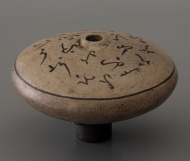
Opium pipe dampers are often made in yixing clay, a Chinese stoneware with a very fine shard that was used for making teapots since the Song Dinasty. This exclusive type of stoneware has a cooling effect and has sufficient porosity to absorb the solids from the opium vapour. Many of such dampers got a decoration on the visible top side by scratching in the decor and then filling in with a clay in contrasting colour. The surface of these opium dampers is then polished to achieve a beautifully smooth skin.The pipe bowl thus remained completely flat for easy cleaning. Calligraphy are among the beloved motifs on such bowls, often inspired by Chinese poetry. The pipe bowl discussed here is different in the way that it doesn’t show the usual Chinese script, but a much simpler continuous writing. While the characters are normally placed in well-arranged rows from top to bottom, the writing here is evenly arranged around the bowl opening forming two text rings. Such opium dampers usually show stamps on the underside that refer to the maker and the place of manufacture, sometimes even a year or other special features are included. This pipe bowl has got as many as four groups of these stamps.
Amsterdam Pipe Museum APM 16.310
PermalinkA matrix by Zenith
octobre 2001
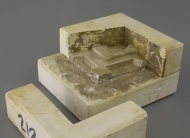
The production of slip cast pipes developed from the beginning of the twentieth century, but, surprisingly, this industry has not left many traces apart from the finished products. Countless brass and iron moulds have been preserved from the time of the press moulded clay pipes, but virtually nothing remains of the slip casted ceramic pipes and their plaster moulds. For casting ceramic pipes plaster are used and after a limited edition these objects worn out and were thrown away. New moulds were then produced in a so-called matrix or mother mould. Such a matrix, or in other wordsthe positive of the working mould, is shown here. Characteristic is that the mould is included in a flat plate. This has two attachments with an L-shape so that a casting basin is created in which the liquid plaster is poured for a new mould. In addition, the pipe shape in the matrix is in positive. This particular matrix is intended for a hollow-walled tobacco pipe by Zenith with the name intermezzo (or pauze). As the name of the pipe indicates, designed for those who want a brief smoke. The four-sided shape of the pipe bowl, which dissolves into the stem, is characteristic for this design. Inventor is Niels Keus from Amsterdam, who devised various designs for hollow-walled pipes for the Zenith firm. The design was very successful and has been in production for almost thirty years.
Amsterdam Pipe Museum APM 16.233
PermalinkA lightweight emperor
septembre 2001
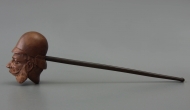
This briar pipe with a stem of caoutchouc or vulcanised rubber is a remarkable object. It is the ultimate lightweight pipe because the bowl wall is extremely thin. In addition, the pipe with its sleek straight stem and elegant, somewhat rounded bowl gives the smoker a joyous, no-obligation look. Represented is the German Emperor Wilhelm I, recognisable by the German helmet in combination with his characteristic moustache and whiskers. Particularly strinking is that the image is upside down. Surely, that is not quite worthy for an imperial portrait, so the question arises whether such a pipe might have been smoked specifically by anti-monarchists. Its origin is yet unclear. Briar is mainly seen as a French product, although this type of wood is also used a lot in Germany. There, production started well in the nineteenth century. Nevertheless, the briar industry did not continue in Germany and was gradually lost since the material is always imported. All in all we are still in the dark about the origin of this pipe, and so we are about the dating. The lightweight version certainly gives the impression of being twentieth century, but the emperor himself died as early as 1888. It is therefore unclear whether we should regard this pipe as a posthumous homage from the time of the First World War or alternatively as a contemporary expression of anti-imperial feelings from before 1888.
Amsterdam Pipe Museum APM 16.215
PermalinkHorse head by a ceramist
août 2001
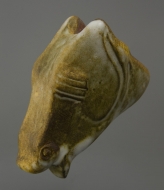
Tobacco pipes from the ceramic artist Marcel Giraud are one of the twentieth century ceramic masterpieces. Giraud, who used Gem or Gema as an artist's name, lived from 1897 to 1985 and worked in the French town of Vallauris. The best known of his works is the caricature pipe representing President De Gaulle, made in only forty numbered copies at the request of the pipe collector Madame De Westphalen. Until recently unknown, the pipe bowl pictured here, showing the head of a horse, has been designed just like the portrait pipe of the former president: with a minimum of details. Because it is a hollow-bowl pipe, the actual outer shape is independent of the inner bowl, so that the artist was not bound to the size of the smoking chamber of the pipe when designing. By stylizing shapes, Gem suggested the horse's head and then added some distinctive details. Giraud excelled in stylizing and suggesting. In addition to the minimalism in design and details, the application of the artful glaze is special in its matte appearance, in which the different shades help to accentuate the details. The horsehead pipe was made in the same period as the other pipes, between 1970 and 1972 and carries the signature Gem as usual at the place where the stem can be inserted. However, this design does not involve a numbered edition, although we know that Giraud's work is always made in small numbers. It is therefore not surprising that his pipes are rare these days.
Amsterdam Pipe Museum APM 16.200a
PermalinkA pipe from a crab scissors
juillet 2001
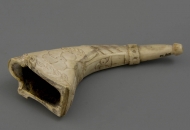
Amazing materials for making tobacco pipes have been used over time, such as in this pipe. Here, the scissors of a crab are transformed into a tobacco pipe. The pipe bowl is positioned in the wide extension part, a smoke tube is drilled in the tip. Apparenty, the pipe can function this way, since nicotine traces indicate that smoking continued for a long time. The surface is decorated with carvings, as was customary in the nineteenth century. Some simple flowers have been carved around the pipe bowl, but the main motif is on the front of the bowl. There you can see an eagle with spread wings, referring to the French empire. The stem shows a simple but charming twist. This is work done in a French colony, possibly by seafarers at times when the ship was anchored. Although this pipe seems unique, it is not. A second copy of this wonderful crab scissors pipe is known by a Belgian collector, so however extremely rare, it is not a unique piece.
Amsterdam Pipe Museum APM 15.815
PermalinkPortrait pipe of Philippe VIII
juin 2001
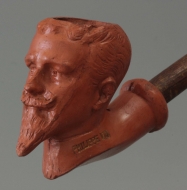
This portrait pipe represents the bust of Prince Philippe VIII, Duke of Orléans and pretender to the throne of France. The pipe was made at the beginning of the last century by the Société Bonnaud & Fils in Marseille. An example for this pipe was a sculpted wooden pipe from Saint-Claude, which was in circulation at the time. With this portrait pipe, Royalists were able to express their sympathy for the kingdom of France. This clay version is said to have been ordered in small numbers by a group of royalists, but there has never been any regular production. That is a doubtful statement, because making a multipart press mould was only worthwhile in a large print run. We can be certain that the sale will not have been very successful, because the intended coronation never took place. The rarity is partly confirmed by the fact that this pipe is missing in almost all collections. Characteristic for Bonnaud, the pipe is made in red-baking clay, the /surface is finished with transparent varnish to look more attractive, but also to be more colour-resistant.
Amsterdam Pipe Museum APM 16.196
Permalink